Forums
- Forums
- Axis And Allies Forum
- General Discussion
- Aviation News
Aviation News
Post a reply
- Go to Previous topic
- Go to Next topic
- Go to Welcome
- Go to Introduce Yourself
- Go to General Discussion
- Go to Screenshots, Images and Videos
- Go to Off topic
- Go to Works in Progress
- Go to Skinning Tips / Tutorials
- Go to Skin Requests
- Go to IJAAF Library
- Go to Luftwaffe Library
- Go to RAF Library
- Go to USAAF / USN Library
- Go to Misc Library
- Go to The Ops Room
- Go to Made in Germany
- Go to Campaigns and Missions
- Go to Works in Progress
- Go to Juri's Air-Raid Shelter
- Go to Campaigns and Missions
- Go to Works in Progress
- Go to Skinpacks
- Go to External Projects Discussion
- Go to Books & Resources
-
2 years agoMon Feb 21 2022, 10:01pmDuggy
 Main AdminA U.S. Marine Corps F-35B Lightning II with Marine Fighter Attack Squadron 242 hovers during an aerial demonstration at the Singapore Airshow 2022 near Changi Exhibition Center, Republic of Singapore, Feb 17, 2022. Through participation in airshows and regional events, the U.S. demonstrates its commitment to the security of the Indo-Pacific, promotes interoperability, displays the flexible combat capabilities of the U.S. Military, creates lasting relationships with international audiences, and strengthens partnerships throughout the Indo-Pacific region. (U.S. Marine Corps photos by Cpl. Bryant Rodriguez)
Main AdminA U.S. Marine Corps F-35B Lightning II with Marine Fighter Attack Squadron 242 hovers during an aerial demonstration at the Singapore Airshow 2022 near Changi Exhibition Center, Republic of Singapore, Feb 17, 2022. Through participation in airshows and regional events, the U.S. demonstrates its commitment to the security of the Indo-Pacific, promotes interoperability, displays the flexible combat capabilities of the U.S. Military, creates lasting relationships with international audiences, and strengthens partnerships throughout the Indo-Pacific region. (U.S. Marine Corps photos by Cpl. Bryant Rodriguez)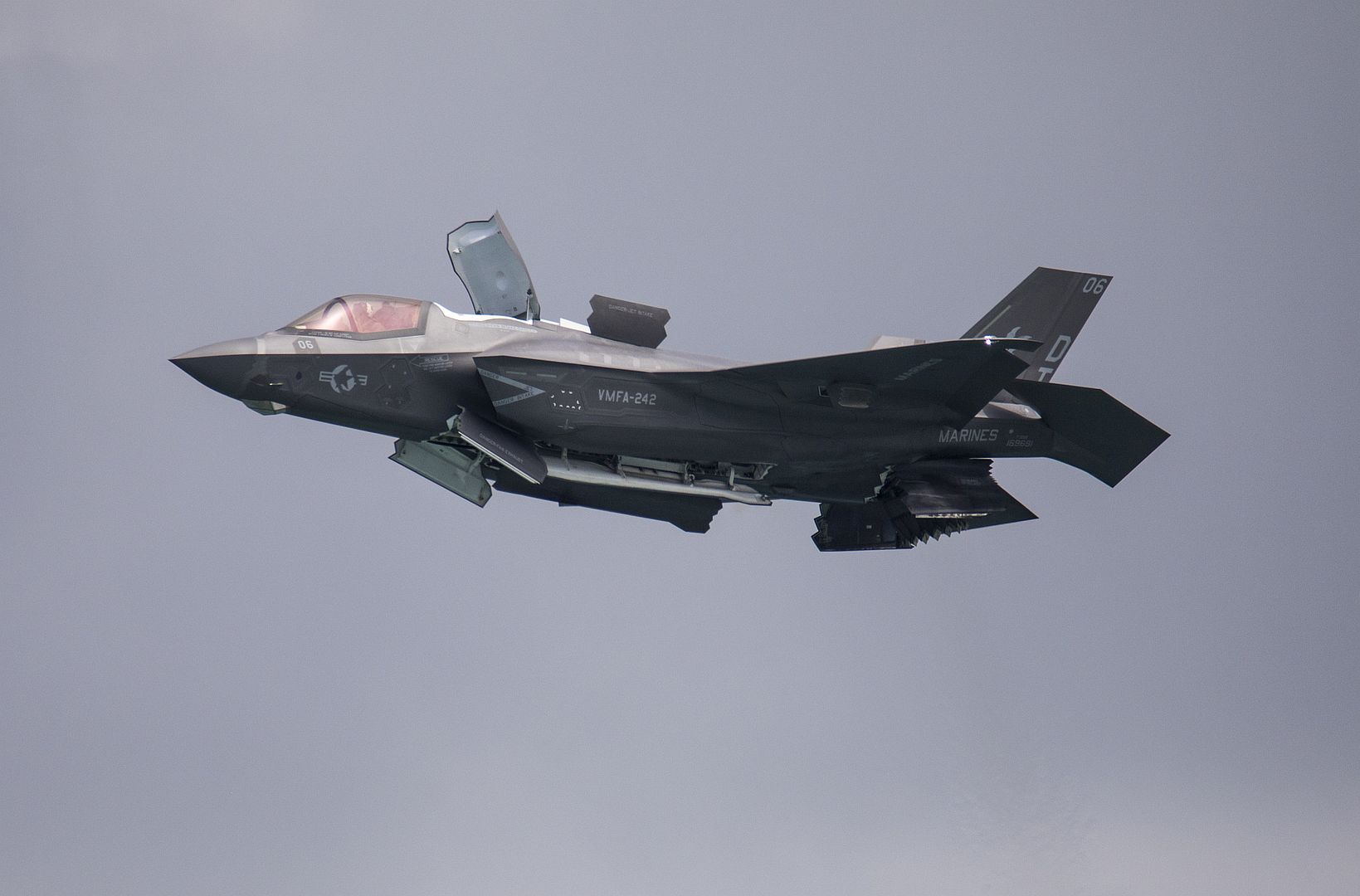

U.S. Air Force F-15C Eagle Aircraft assigned to the 44th Fighter Squadron, taxi onto a runway before taking off in support of Jungle Warfare Exercise 2022 at Kadena Air Base, Okinawa, Japan, Feb. 17, 2022. JWX 22 is a large-scale field training exercise focused on leveraging the integrated capabilities of joint and allied partners to strengthen all-domain awareness, maneuvers, and fires across a distributed maritime environment. (U.S. Marine Corps photo by Pfc. Justin J. Marty)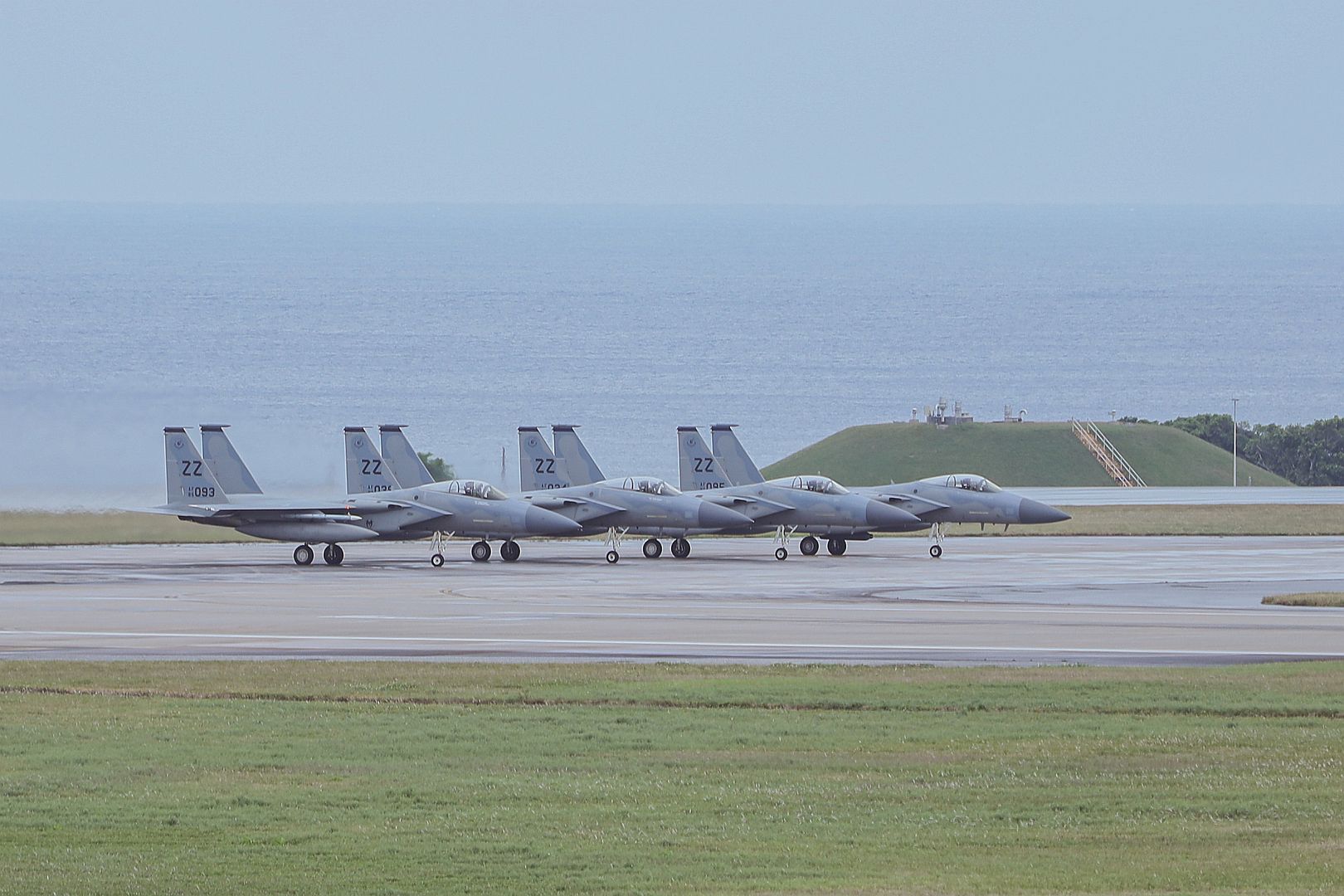
Three U.S. Air Force F-16 Fighting Falcons assigned to the 18th Aggressor Squadron, fly alongside a 909th Air Refueling Squadron KC-135 Stratotanker over the Pacific Ocean in support of Cope North 22, Feb.16, 2022. The Aggressor Squadron prepares combat Air Force, joint and allied aircrews through challenging, realistic threat replication, training, test support, academics and feedback. (U.S. Air Force photos by Airman 1st Class Yosselin Perla)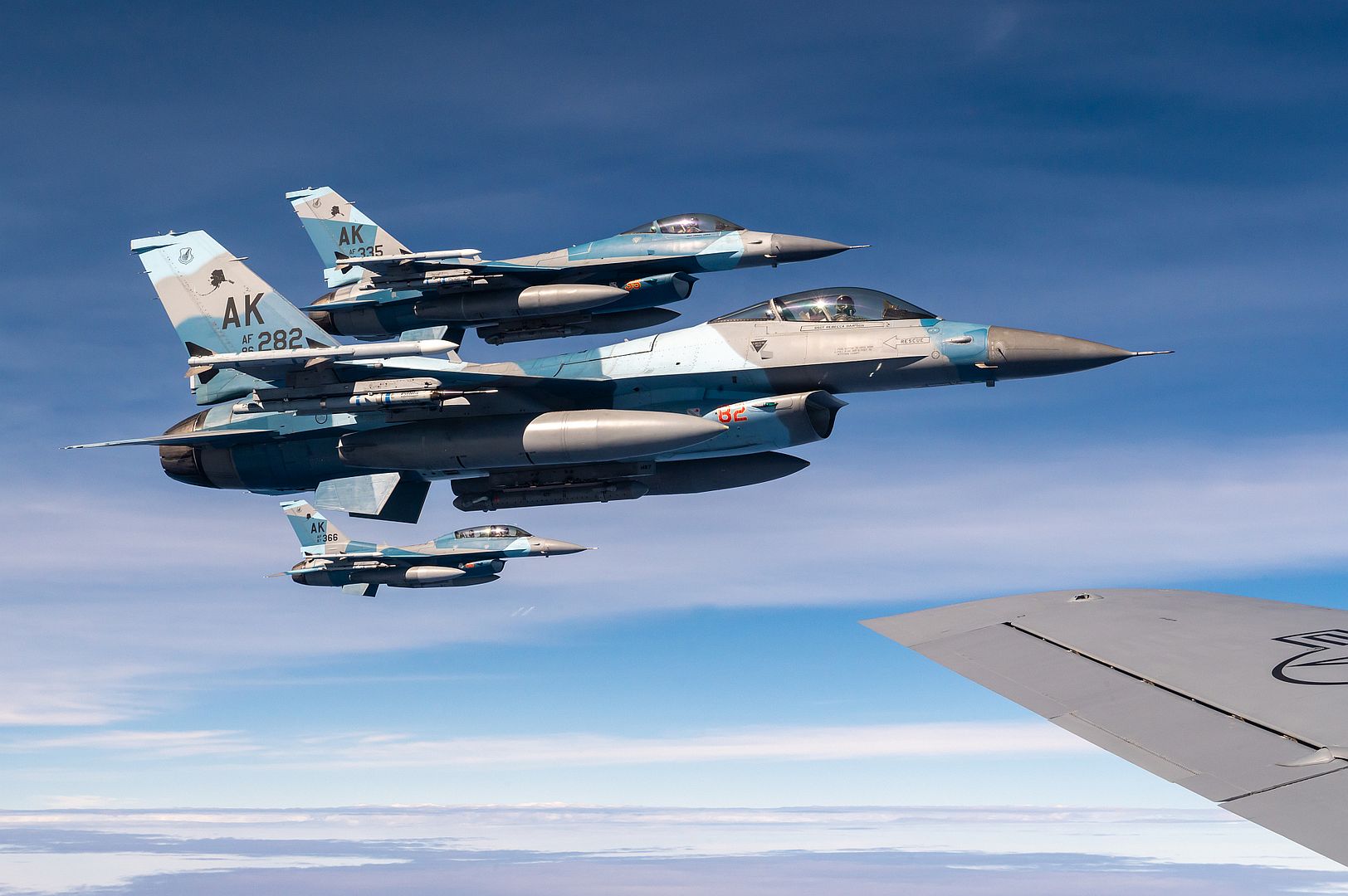
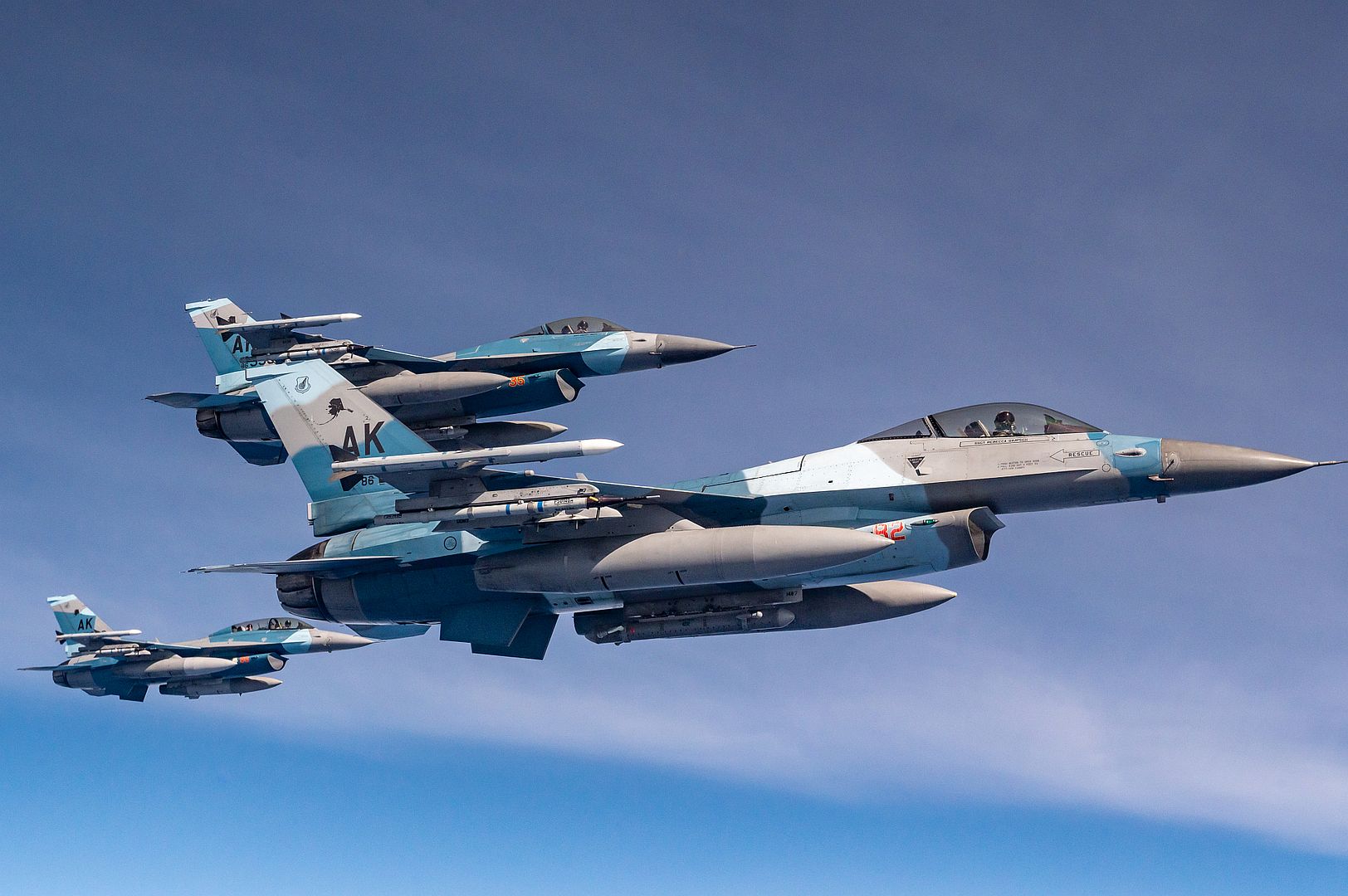
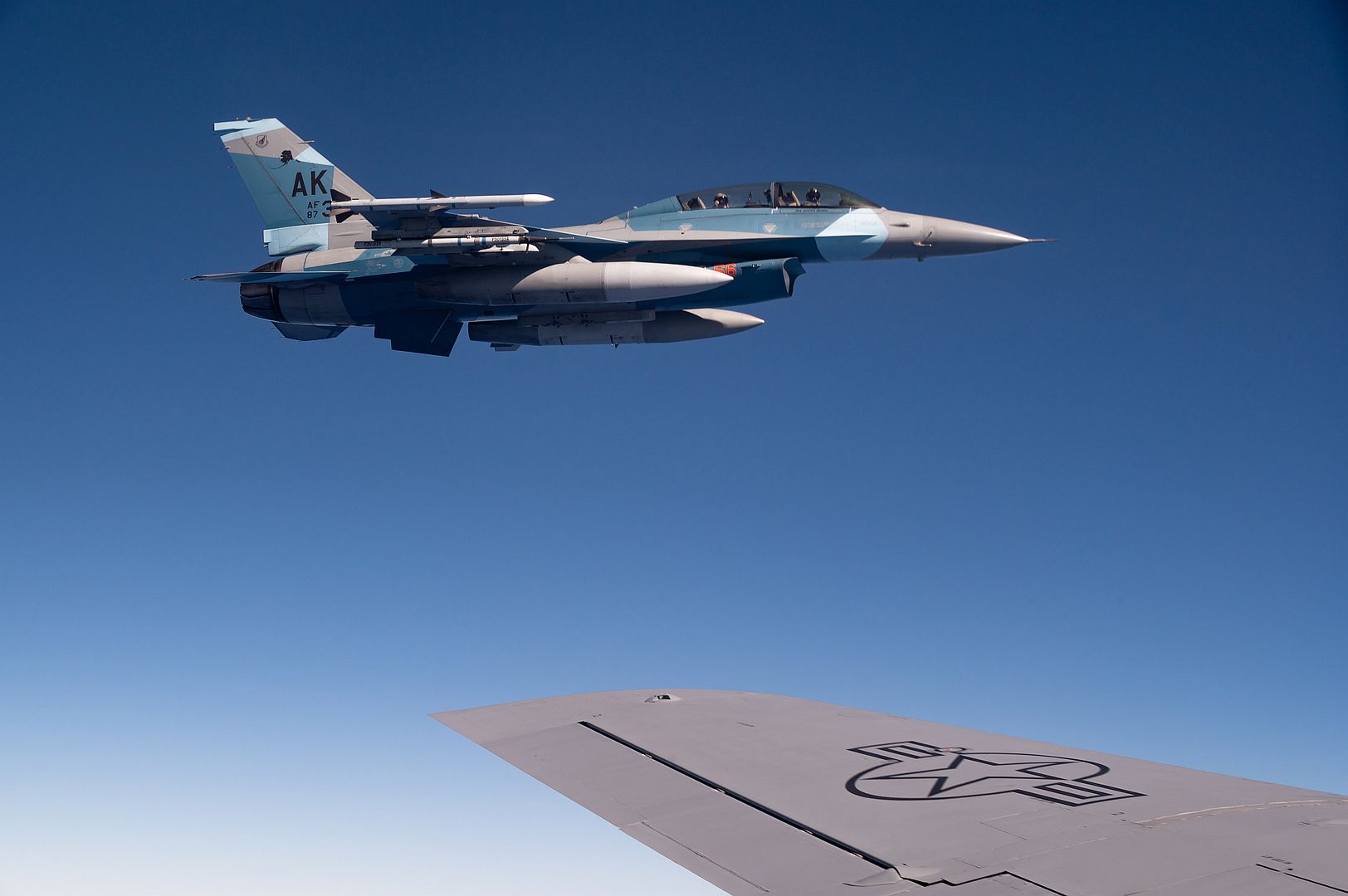
18.02.2022
Pilots of the MiG-31BM high-altitude supersonic interceptor fighters of the fighter aviation regiment of the Central Military District intercepted and conditionally destroyed high-precision weapons of a mock enemy during the first stage of a tactical flight exercise in the Krasnoyarsk territory.
During the tactical episode, crews of three types of radar stations Gamma, Terek and Cabina were involved, which performed the tasks of detecting and tracking conditional group targets of high-precision weapons of the mock enemy. The data on the targets were transferred to the crews of MiG-31BM interceptor fighters for further destruction. In total, about 8 group targets imitating cruise, anti-aircraft and aircraft guided missiles were detected and conditionally destroyed.
The next stage of the exercise will be the relocation of MiG-31BM interceptor fighters to the Republic of Buryatia, where they will perform combat launches of guided air-to-air missiles at single and group targets.
About 20 units of aviation equipment and about 800 military personnel from among the flight crew, combat crews of radar stations, engineering and technical personnel, flight control and support groups are involved in the tactical flight exercise.
(Photo courtesy of the Ministry of Defence of the Russian Federation).jpg?width=1920&height=1080&fit=bounds)
This week a Poseidon MRA1 (P-8A) aircraft from RAF Lossiemouth has been participating in a multinational anti-submarine warfare exercise off the coast of Norway.
The Exercise, known as, Arctic Dolphin is one of a series of routine exercises that provides the Royal Air Force an opportunity to test and develop the capabilities of its Maritime Patrol Aircraft alongside NATO allies.
Ships from Norway , the Netherlands , Denmark , and Germany worked alongside each other to hone their skills and ensure they can operate together seamlessly. As part of the exercise scenario the RAF aircraft worked with Frigates including HNLMS Van Amstel to hunt the submarine HNLMS Zeeleeuw.
(Photo courtesy of the RAF)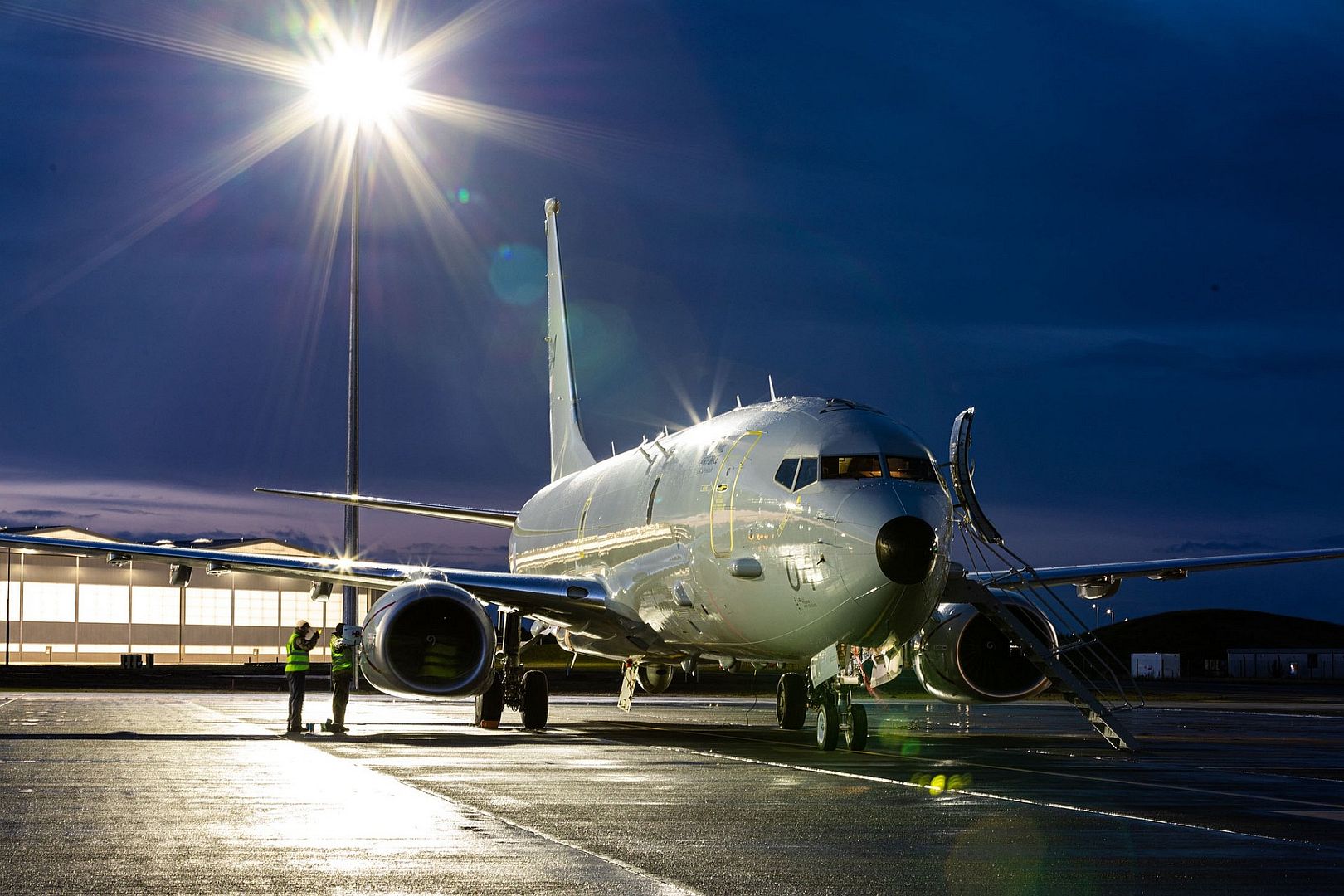
-
 Main AdminSoldiers from Charlie Troop, 7th Squadron, 17th Cavalry Regiment move an AH64 Apache helicopter in preparation for scheduled maintenance, Stefanovikeio Air Base, Greece, Feb. 21, 2022. (U.S. Army photos by Capt. Taylor Criswell)
Main AdminSoldiers from Charlie Troop, 7th Squadron, 17th Cavalry Regiment move an AH64 Apache helicopter in preparation for scheduled maintenance, Stefanovikeio Air Base, Greece, Feb. 21, 2022. (U.S. Army photos by Capt. Taylor Criswell)

PHILIPPINE SEA (Feb. 19, 2022) An F-35C Lightning II, assigned to the "Black Knights" of Marine Fighter Attack Squadron (VMFA) 314, makes an arrested landing on the flight deck of the Nimitz-class aircraft carrier USS Abraham Lincoln (CVN 72). Abraham Lincoln Strike Group is on a scheduled deployment in the U.S. 7th Fleet area of operations to enhance interoperability through alliances and partnerships while serving as a ready-response force in support of a free and open Indo-Pacific region. (U.S. Navy photo by Mass Communication Specialist 3rd Class Michael Singley)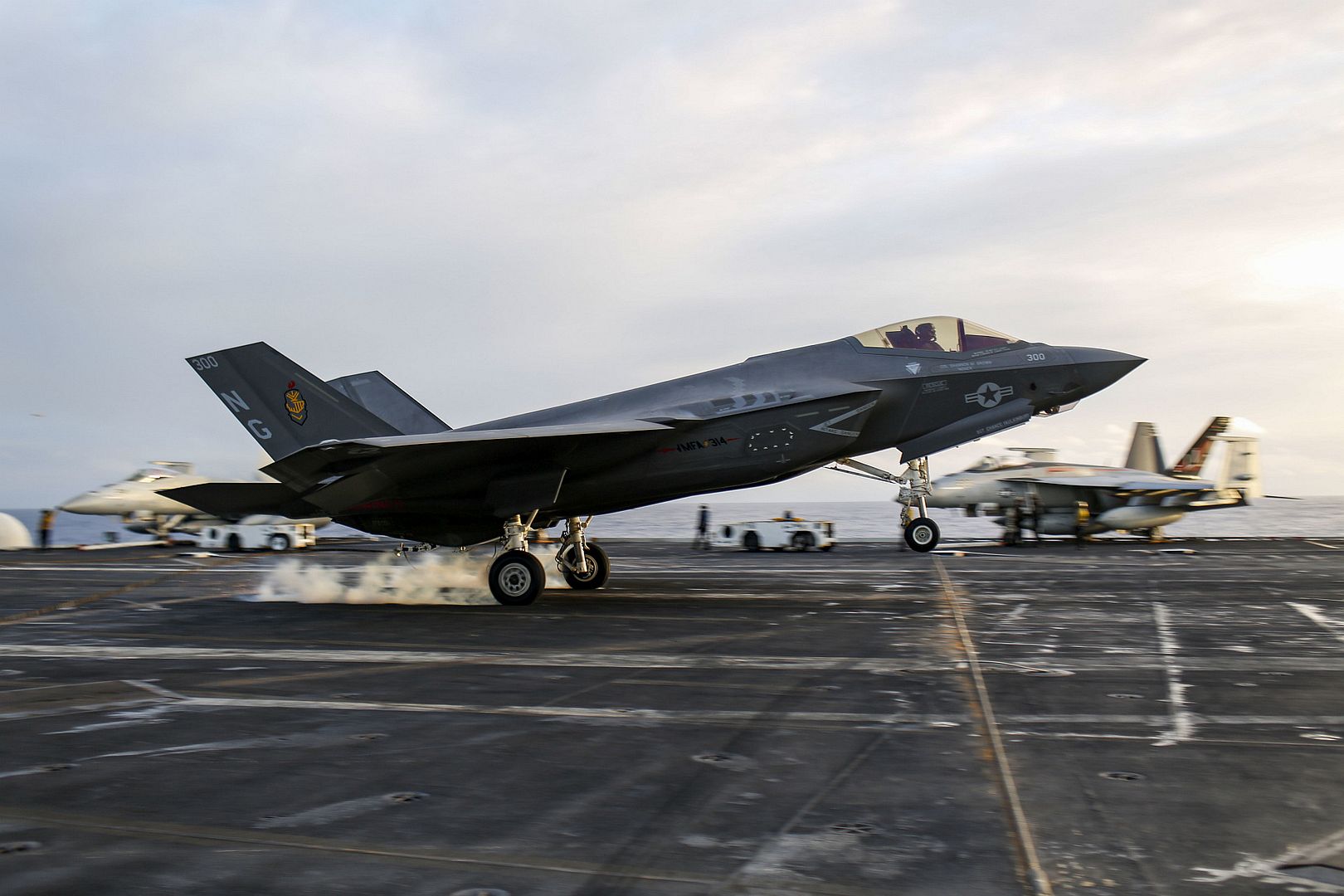
PHILIPPINE SEA (Feb. 19, 2022) An F/A-18E Super Hornet, assigned to the "Tophatters" of Strike Fighter Squadron (VFA) 14, launches from the flight deck of the Nimitz-class aircraft carrier USS Abraham Lincoln (CVN 72). Abraham Lincoln Strike Group is on a scheduled deployment in the U.S. 7th Fleet area of operations to enhance interoperability through alliances and partnerships while serving as a ready-response force in support of a free and open Indo-Pacific region. (U.S. Navy photo by Mass Communication Specialist 3rd Class Michael Singley).jpg?width=1920&height=1080&fit=bounds)
ADRIATIC SEA (Feb. 21, 2022) An F/A-18F Super Hornet, attached to the “Red Rippers” of Strike Fighter Squadron (VFA) 11, lands on the flight deck of the Nimitz-class aircraft carrier USS Harry S. Truman (CVN 75), Feb. 21, 2022. The Harry S. Truman Carrier Strike Group is on a scheduled deployment in the U.S. Sixth Fleet area of operations in support of U.S., allied and partner interests in Europe and Africa. (U.S. Navy photo by Mass Communication Specialist 3rd Class Bela Chambers).jpg?width=1920&height=1080&fit=bounds)
ADRIATIC SEA (Feb. 21, 2022) An E-2D Hawkeye, attached to the "Seahawks" of Airborne Command and Control Squadron (VAW) 126, flies over the flight deck of the Nimitz-class aircraft carrier USS Harry S. Truman (CVN 75), Feb. 21, 2022. The Harry S. Truman Carrier Strike Group is on a scheduled deployment in the U.S. Sixth Fleet area of operations in support of U.S., allied and partner interests in Europe and Africa. (U.S. Navy photo by Mass Communication Specialist 3rd Class Bela Chambers)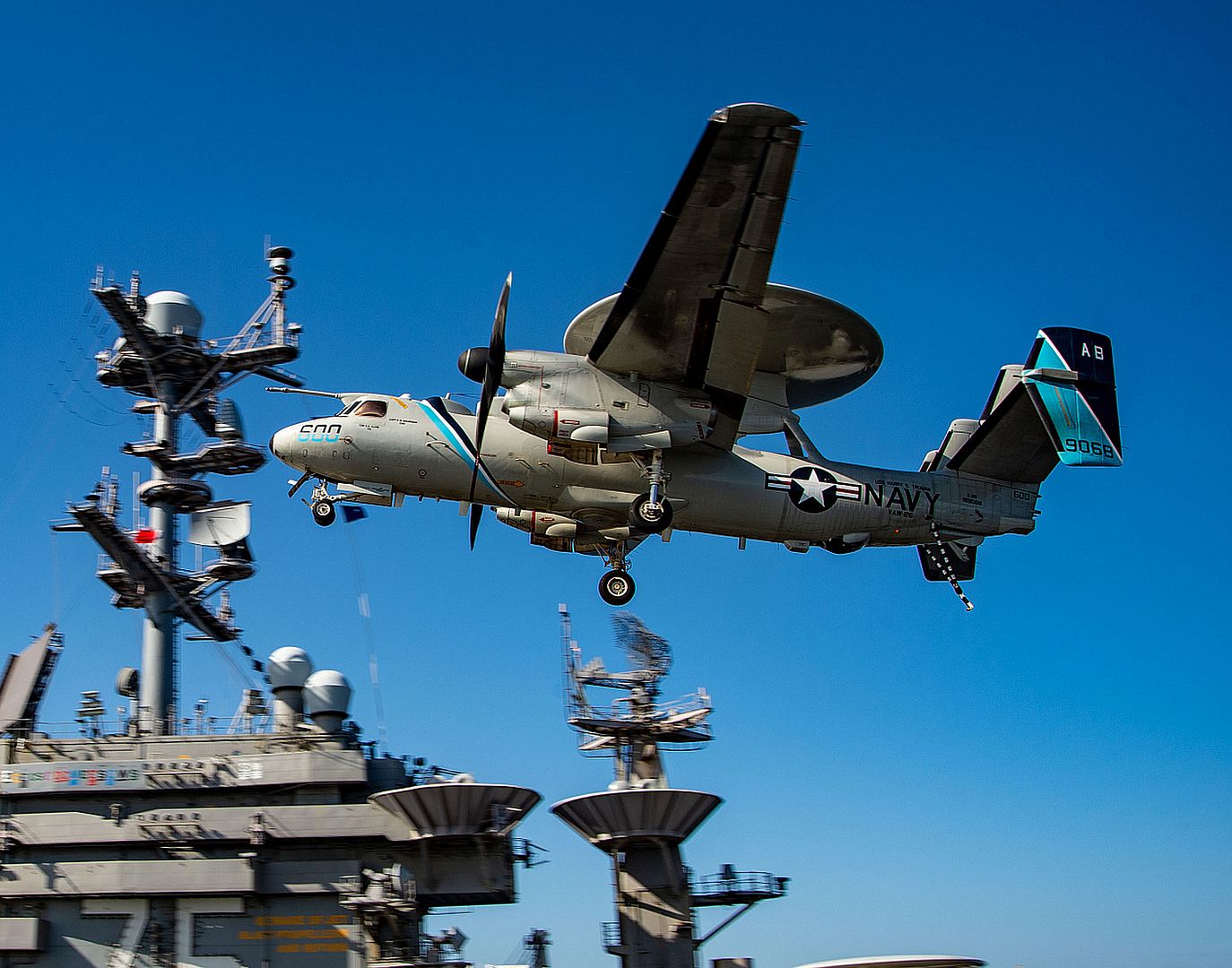
ADRIATIC SEA (Feb. 21, 2022) An E-2D Hawkeye, attached to the "Seahawks" of Airborne Command and Control Squadron (VAW) 126, lands on the flight deck of the Nimitz-class aircraft carrier USS Harry S. Truman (CVN 75), Feb. 21, 2022. The Harry S. Truman Carrier Strike Group is on a scheduled deployment in the U.S. Sixth Fleet area of operations in support of U.S., allied and partner interests in Europe and Africa. (U.S. Navy photo by Mass Communication Specialist 3rd Class Bela Chambers)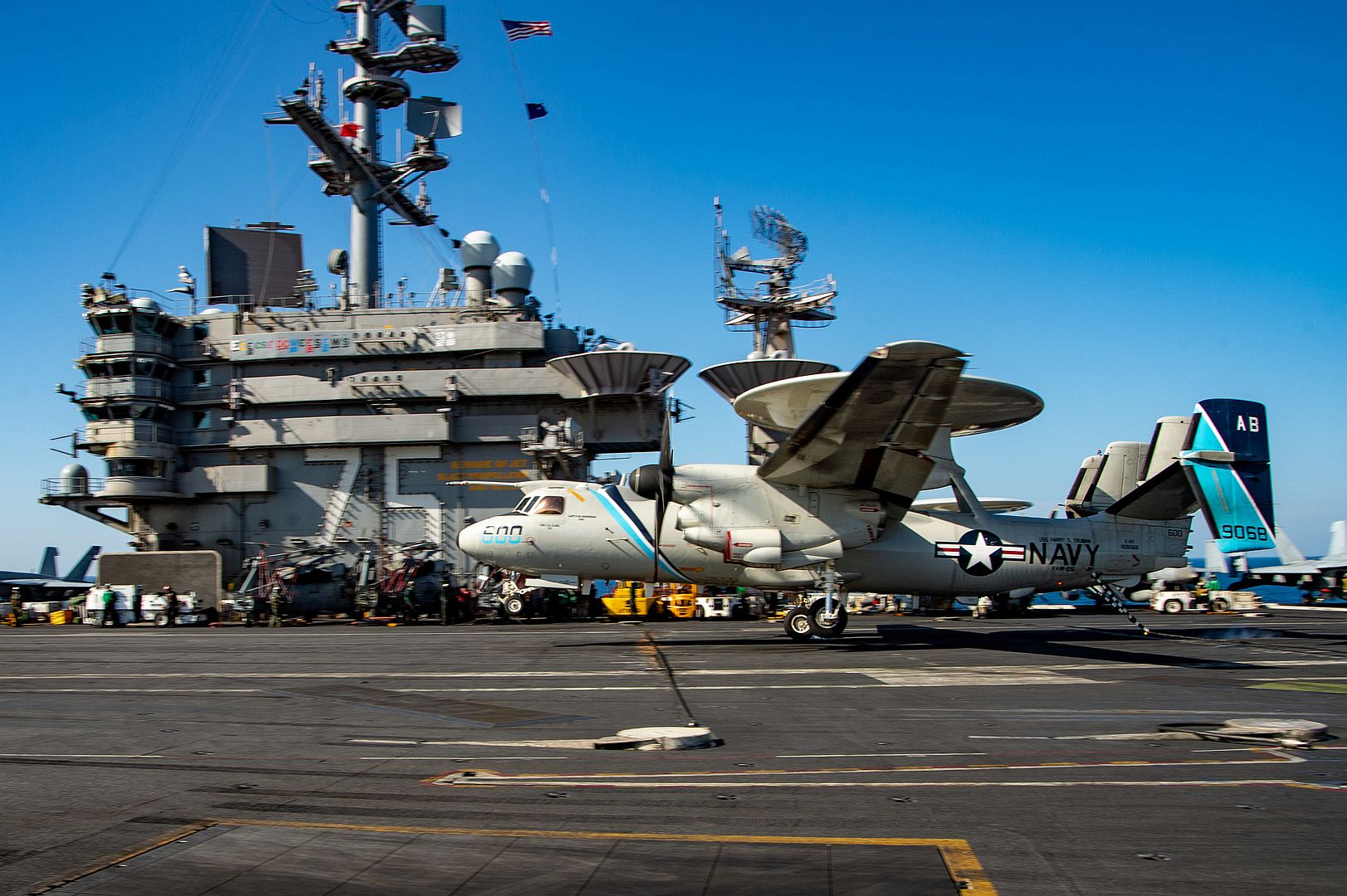
A U.S. Air Force F-16 Fighting Falcon assigned to the 332d Air Expeditionary Wing flies above the Red Sea, Feb. 16, 2022. The live fly event with U.S. and regional assets, tested information distribution capabilities during a simulated unmanned aircraft system threat scenario, improving collective counter-UAS capabilities and increasing theater security and stability. (U.S. Air Force photo by Staff Sgt. Joseph Pick)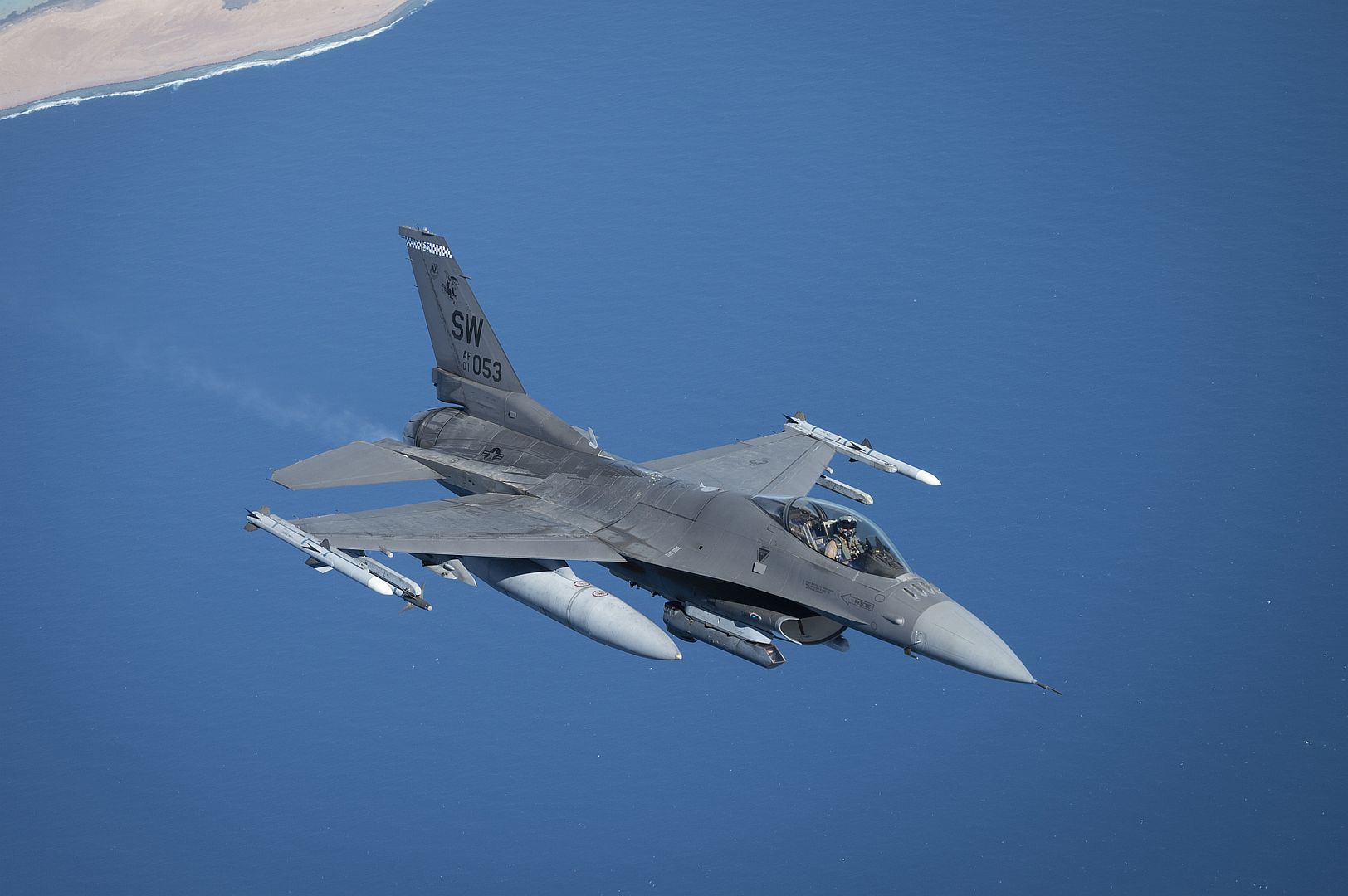
A U.S. Air Force aircraft maintainer performs post-flight checks on a U.S. Air Force F-35A Lightning II from the 34th Fighter Squadron at Hill Air Force Base, Utah, after the jet landed at Spangdahlem Air Base, Germany, Feb. 16, 2022. The F-35 deployment to Spangdahlem AB is designed to bolster readiness, enhance NATO's collective defense posture and further increase air integration capabilities with Allied and Partner nations. (U.S. Air Force photo by Tech. Sgt. Maeson L. Elleman)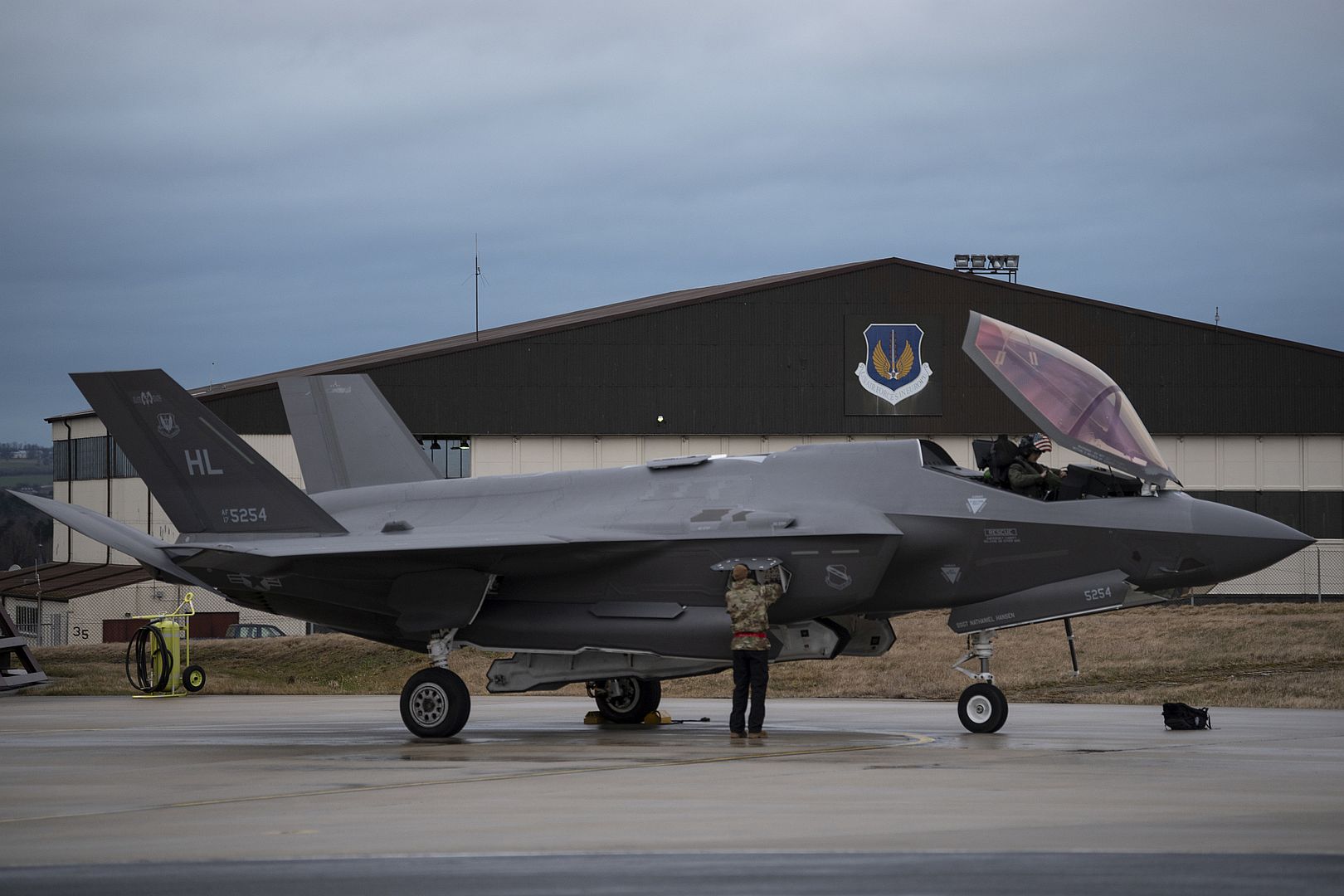
Two U.S. Air Force F-35A Lightning II multirole fighter jets from the 34th Fighter Squadron, 388th Fighter Wing, taxi on the flightline after arriving at Spangdahlem Air Base, Germany, Feb. 16, 2022, to bolster readiness and enhance capabilities with regional partners and allies. The deployment of the F-35s is designed to reinforce NATO’s collective defensive posture. (U.S. Air Force photo by Tech. Sgt. Maeson L. Elleman)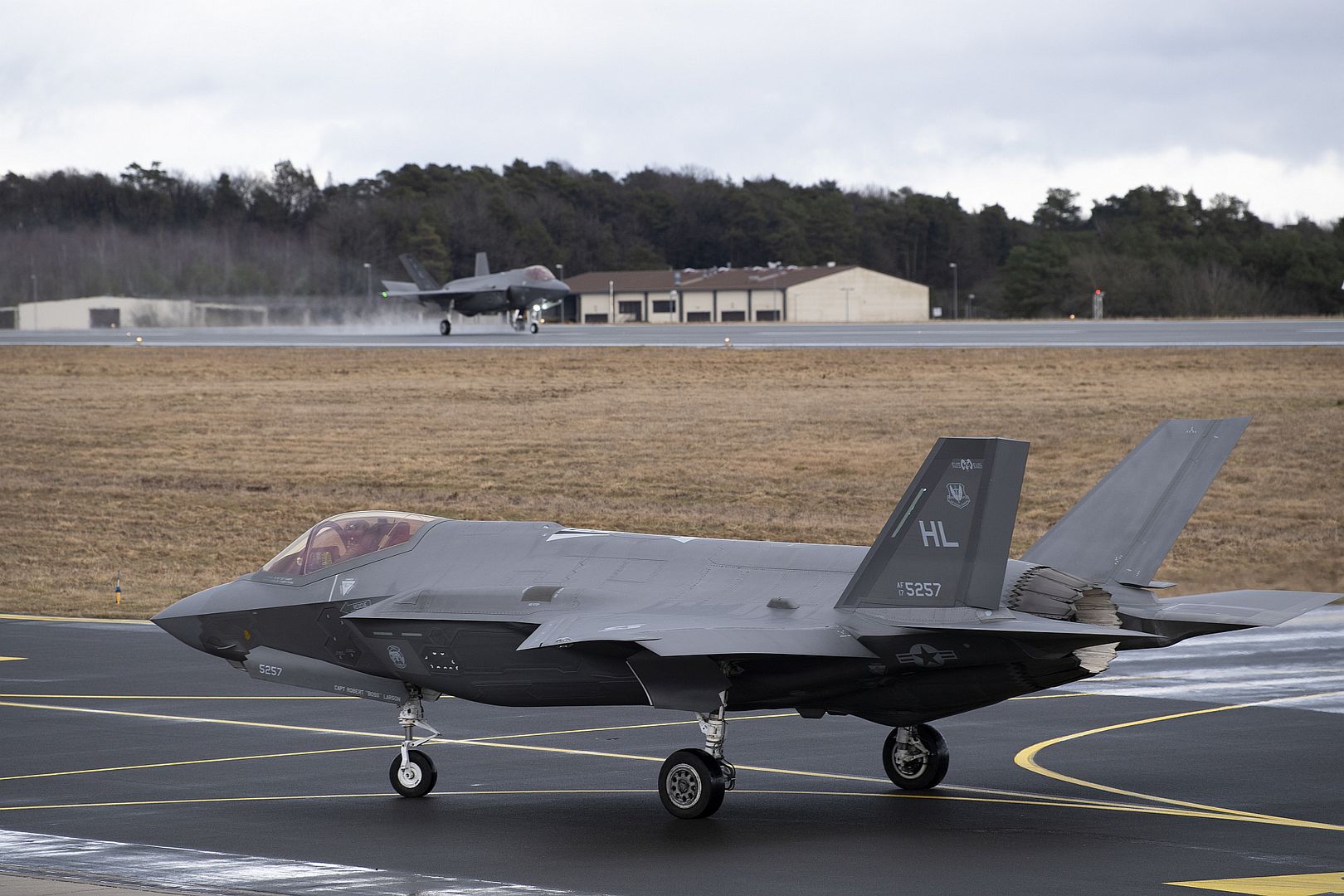
A Polish Air Force F-16 lands after Basic Fighter Maneuver Training with the U.S. Air Force F-15C Eagles assigned to the 493rd Fighter Squadron, Royal Air Force (RAF) Lakenheath, Englandat Łask Air Base, Poland in support of the North Atlantic Treaty Organization (NATO)Enhanced Air Policing mission, Feb. 15, 2022. The NATO Air Policing mission has been executed continuously since 1961, yet frequent training and exercising is critical to ensure NATO air power remains fully prepared at all times. (U.S. Air Force photo by Tech. Sgt. Jacob Albers)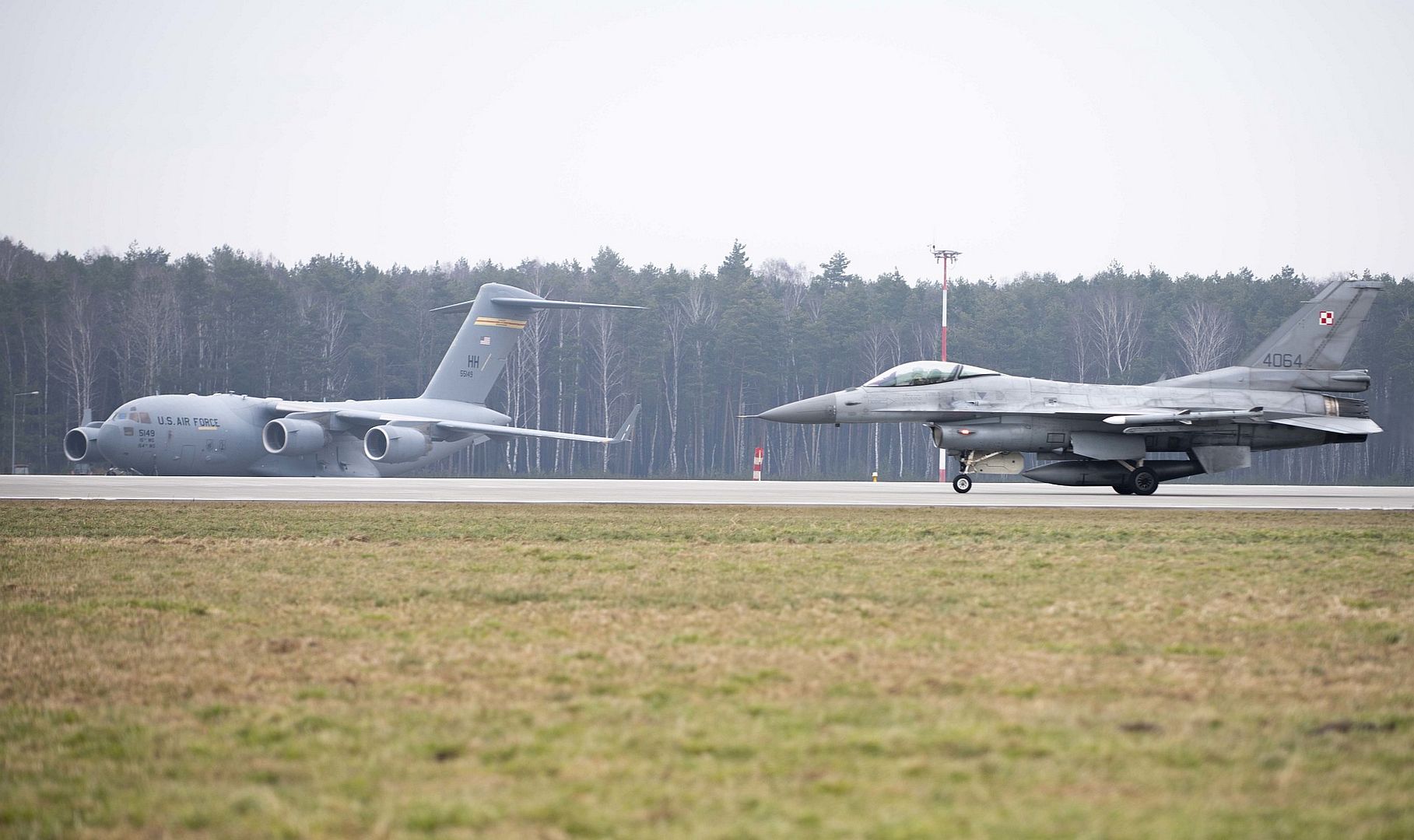
Toulouse, 21 February 2022 - Taiwan’s STARLUX Airlines has taken delivery of its first widebody aircraft - an A330-900. It is the first of 26 Airbus widebodies set to join the airline’s fleet, comprising eight A330neo and 18 A350s.
The A330neo aircraft and one A350 are being acquired on lease from ALC, while the airline has 17 A350s on direct order with Airbus. Benefiting from the A330neo’s unbeatable operating economics and award-winning Airspace cabin, the aircraft will feature a two-class cabin with 28 business class seats and 269 economy class seats.
The A330neo joins an existing fleet of seven single-aisle A321neo at the airline, and will complement the airline’s network by flying regional routes from Taiwan to the wider Asia-Pacific.
At the same time, STARLUX has also signed up for the computer-based ACE (Airbus Cockpit Experience) Suite training solution. Using a “learning by discovery” approach, STARLUX’s flying crew will be able to use the ACE Trainer that simulates a 3D Cockpit environment with guided lessons and free play.
ACE Suite offers an efficient learning process that also provides customers with significant time savings off high-level devices training. Users can enjoy better knowledge retention and continuous skills reinforcement. ACE Suite is approved by EASA and in line with ICAO regulations.
“I am delighted to welcome our first A330neo, as it marks a key milestone in our growth. Having already operated modern and efficient single-aisle A321neo, we are confident that the A330neo will bring even more flexibility and efficiency in our network strategy, whilst optimising cost efficiency and achieving high passenger comfort,” K.W. Chang, Founder and Chairman of STARLUX Airlines. “We are also looking forward to starting to take delivery of our A350s in the coming months.”
“We are excited to work closely with STARLUX to build their new fleet,” said Christian Scherer, Airbus Chief Commercial Officer. “Together the A321neo, A330neo and A350 will enable the carrier to benefit from the unique technical commonality and efficiency offered by our latest generation aircraft. In addition they offer the best levels of comfort in their respective size categories, which will be a key element for STARLUX in delivering its premium in-flight experience.”
At the end of January 2022, the A330 Family had won over 1,800 orders (including 353 A330neo from 23 customers worldwide)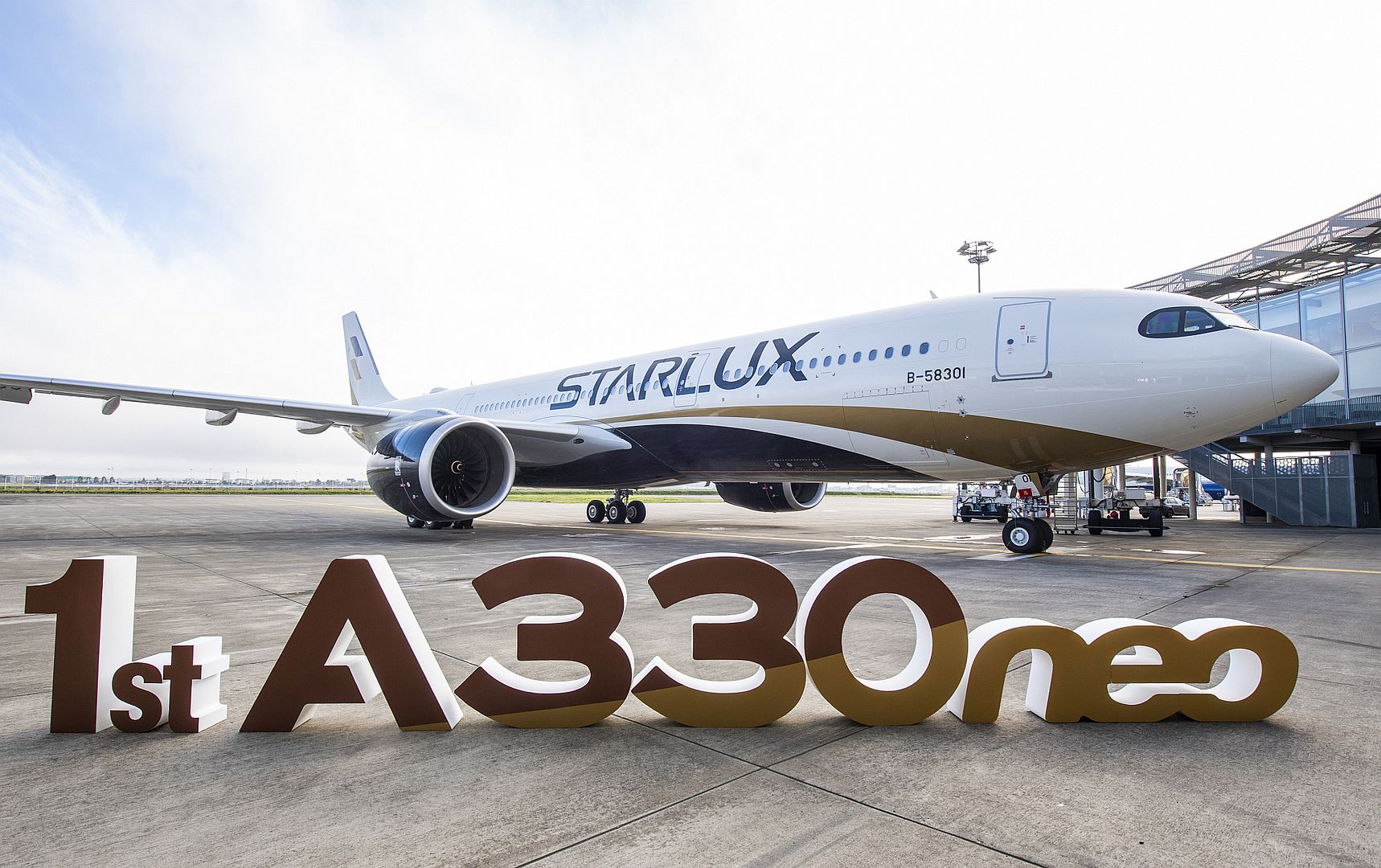 .
.
Airbus A400M, the world’s most advanced multi-role airlifter utilised by military forces around the globe, has demonstrated an airborne launch of a drone fulfilling a vital function for the Future Combat Air System.
During a recent test, an A400M deployed a drone from its opened rear cargo ramp door whilst airborne, validating its ability to air-launch drones. In the future such unmanned aircraft, called Remote Carriers, can serve as force multipliers for various missions, while keeping the pilots out of harm’s way. Manned-unmanned teaming (MUM-T) will allow the Remote Carriers to operate in concert with manned aircraft, opening new fields of tactics to surprise, deceive, deter, saturate and strike opponents.
During the A400M flight test, an Airbus-built Do-DT25 drone, acting as a surrogate Remote Carrier, was released over a test range in Northern Germany. Shortly after the launch, the drone’s parachute opened, delivering it safely to the ground. Throughout the test, the drone was connected and transmitting data to the A400M “mother aircraft”. This data transfer illustrates how Remote Carriers can be connected to a combat cloud network, providing vital information by serving the role of “eyes and ears” over the battlefield, whilst also enabling them to be tasked by the manned aircraft’s operators during their missions.
The A400M air-launch demonstration involved a joint flight test crew from the German Air Force and Airbus. The new Modular Airborne Combat Cloud Services (MACCS), also an Airbus product, enabled full connectivity between the airlifter and the drone.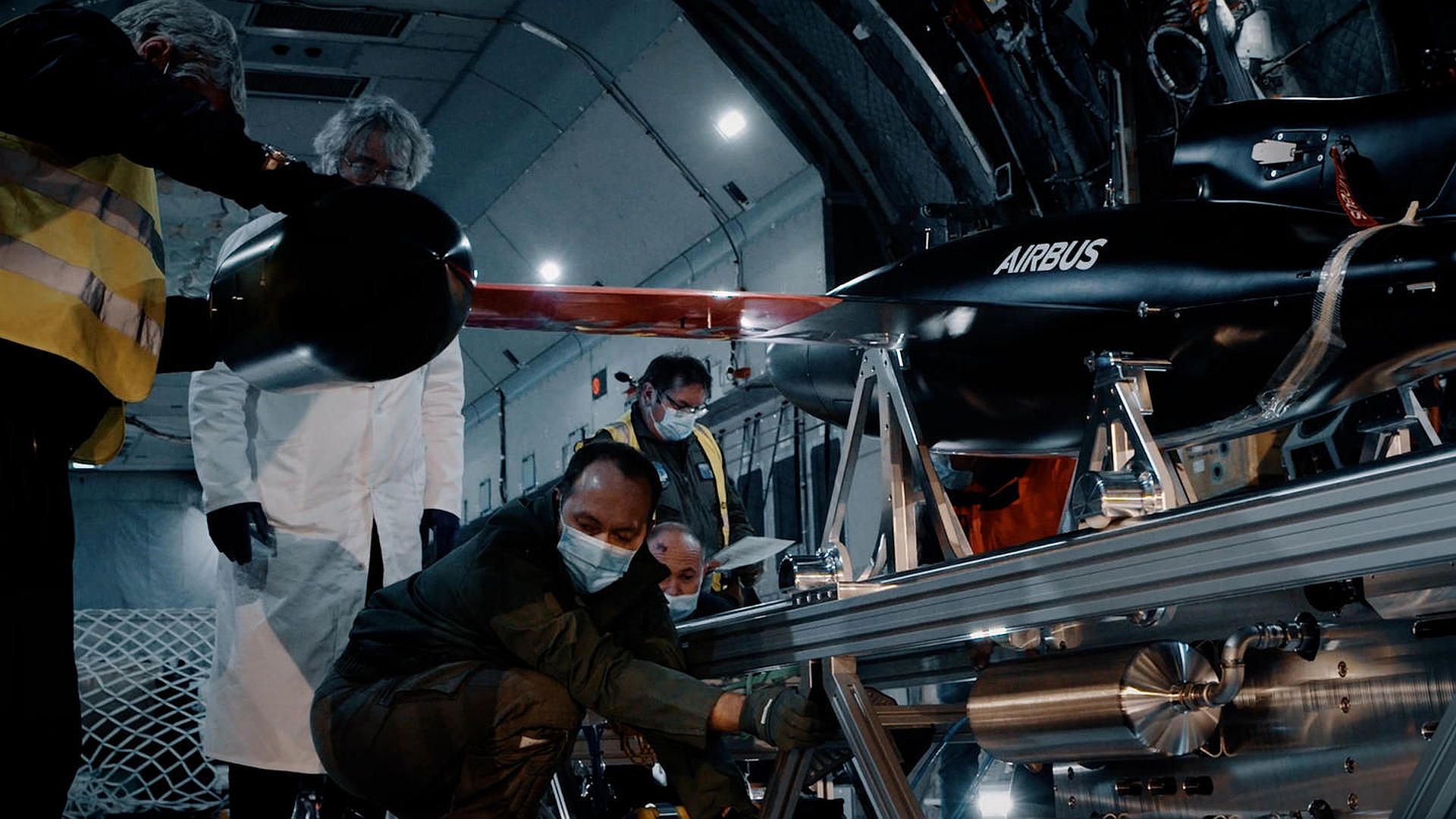
Airbus will continue validation of the A400M as an airborne launch platform for Remote Carriers, envisioning the ability to deploy large numbers of these drones. The multi-role airlifter’s large cargo bay is expected to be able to hold 40 or more Remote Carriers. By bringing Remote Carriers closer to the fight, an A400M will provide the numbers in terms of flying platforms for a Future Combat System to serve multiple missions, even in a well-protected environment. The next flight test is planned to happen this year.
In addition, Airbus contribution to the 2021 German Air Force’s Timber Express exercise saw an important development step being cleared. A Eurofighter networking with and tasking two Do-DT25 drones in real-time, became the successful first application of MUM-T with operational military aircraft in Europe.
Previously, Airbus also demonstrated the control of five Do-DT25 drones by a mission group commander who was airborne in a manned command and control aircraft. Validating such elements, as connectivity, human-machine interface, and the concept of teaming intelligence through mission group management, also constitute key steps towards using Remote Carriers as force multipliers within the Future Combat Air System.
BAE Systems’ Australian engineering teams, supported by teams in the UK, will deliver a programme of software and hardware upgrades to the Australian 33-strong Mk 127 Hawk fleet to ensure it continues to deliver highly-trained pilots to fly fast jets including the F-35 Lightning II.
The new contract includes the continuation of the existing in-service support, providing maintenance, engineering and supply chain services to the Royal Australian Air Force (RAAF) and provides the foundation for progressive upgrades of mission systems.
A Rolls-Royce 951 Adour engine upgrade for the Australian fleet will be incorporated by 2025 and will align the aircraft with the UK Royal Air Force’s T2 Hawk aircraft.
The aircraft is a global success story with more than 1,000 aircraft sold, the vast majority exported from the UK, delivering more than £16bn to the nation’s economy from an initial £800m investment.
In Australia, the Lead-In Fighter programme sustains a combined direct and indirect highly skilled workforce of almost 900 people at BAE Systems Williamtown (NSW) facility and at RAAF Base Pearce, as well as a supply chain of 168 Australian businesses, many of which are based in the Hunter Valley.
BAE Systems delivers support to Hawk fleets around the world through in-country teams in the UK, the Middle East and Far East and through engineering support services from the UK, ensuring aircraft are available where they are needed, when they are needed.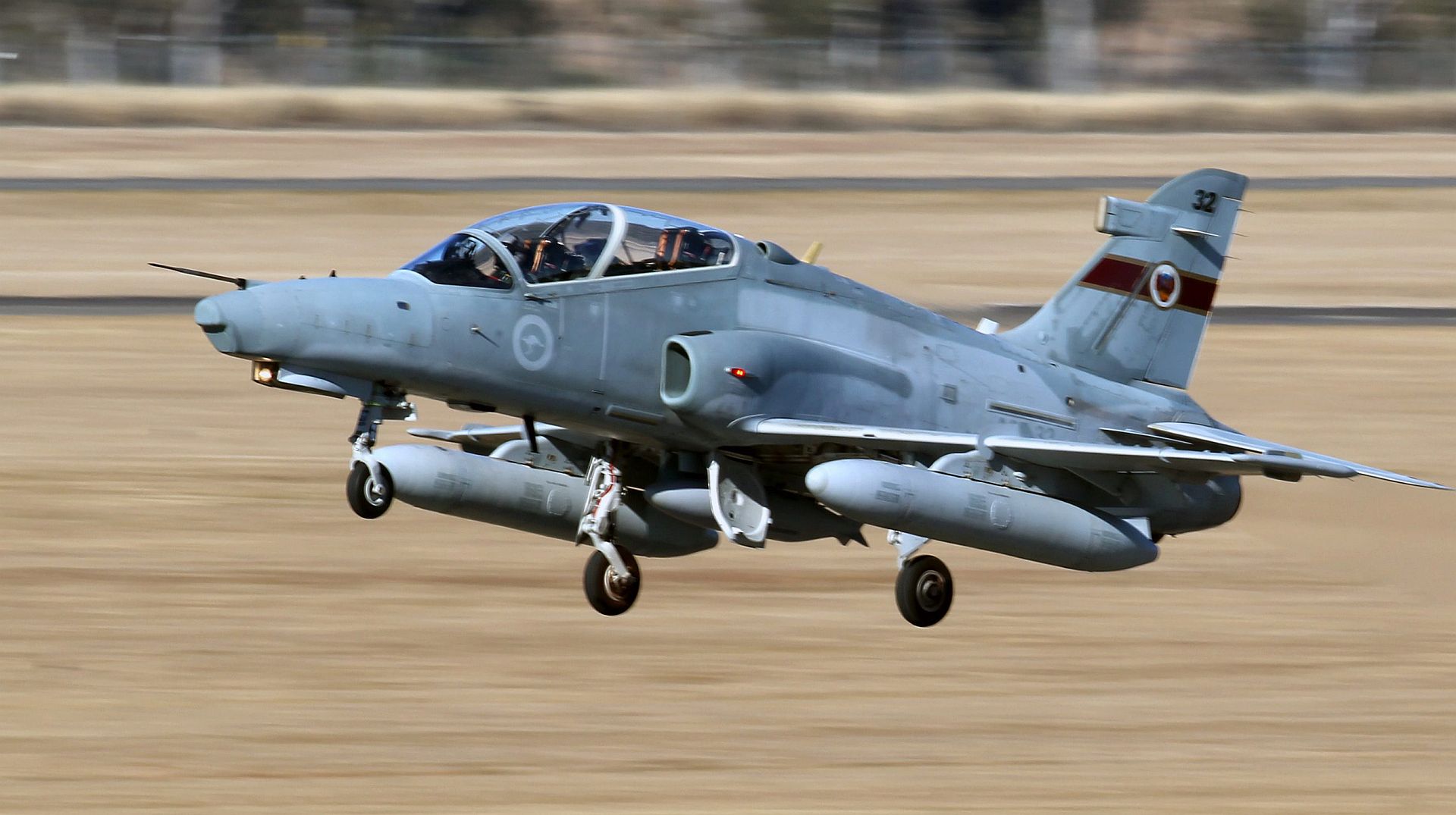
RAF Poseidon maritime patrol aircraft are participating in a major multinational NATO exercise in the Central Mediterranean and Ionian Sea. Titled Dynamic Manta 22, this is the first time the Poseidon Force has conducted Anti-Submarine and Anti-Surface Warfare operations from an overseas operating location.
A pair of aircraft and two crews, with supporting operations and engineering personnel from RAF Lossiemouth based CXX Squadron will spend the next fortnight training with aircraft, ships, and submarines from the nine Allied nations which have converged for the exercise.
Operating from Naval Air Station Sigonella (NAS Sigonella), in the shadow of Mount Etna, Sicily, the exercise re-emphasises and demonstrates the close relationship and interoperability the RAF shares with NATO allies to deliver joint security.
(Photo courtesy of the RAF)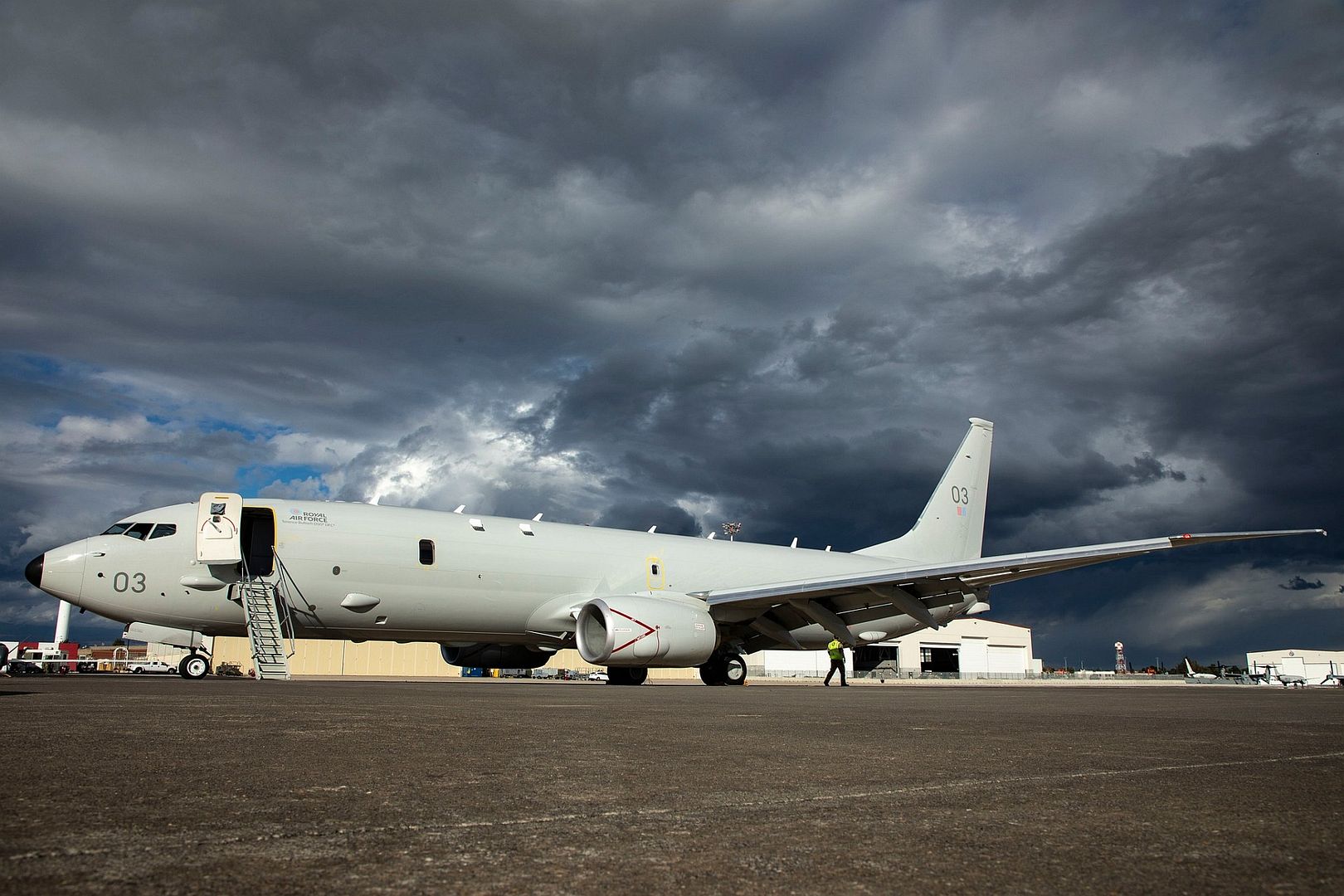
-
 Main AdminPHILIPPINE SEA (Feb. 21, 2022) An E-2D Hawkeye, assigned to the "Wallbangers" of Carrier Airborne Early Warning Squadron (VAW) 117, makes an arrested landing on the flight deck of the Nimitz-class aircraft carrier USS Abraham Lincoln (CVN 72). Abraham Lincoln Strike Group is on a scheduled deployment in the U.S. 7th Fleet area of operations to enhance interoperability through alliances and partnerships while serving as a ready-response force in support of a free and open Indo-Pacific region. (U.S. Navy photo by Mass Communication Specialist 3rd Class Javier Reyes)
Main AdminPHILIPPINE SEA (Feb. 21, 2022) An E-2D Hawkeye, assigned to the "Wallbangers" of Carrier Airborne Early Warning Squadron (VAW) 117, makes an arrested landing on the flight deck of the Nimitz-class aircraft carrier USS Abraham Lincoln (CVN 72). Abraham Lincoln Strike Group is on a scheduled deployment in the U.S. 7th Fleet area of operations to enhance interoperability through alliances and partnerships while serving as a ready-response force in support of a free and open Indo-Pacific region. (U.S. Navy photo by Mass Communication Specialist 3rd Class Javier Reyes)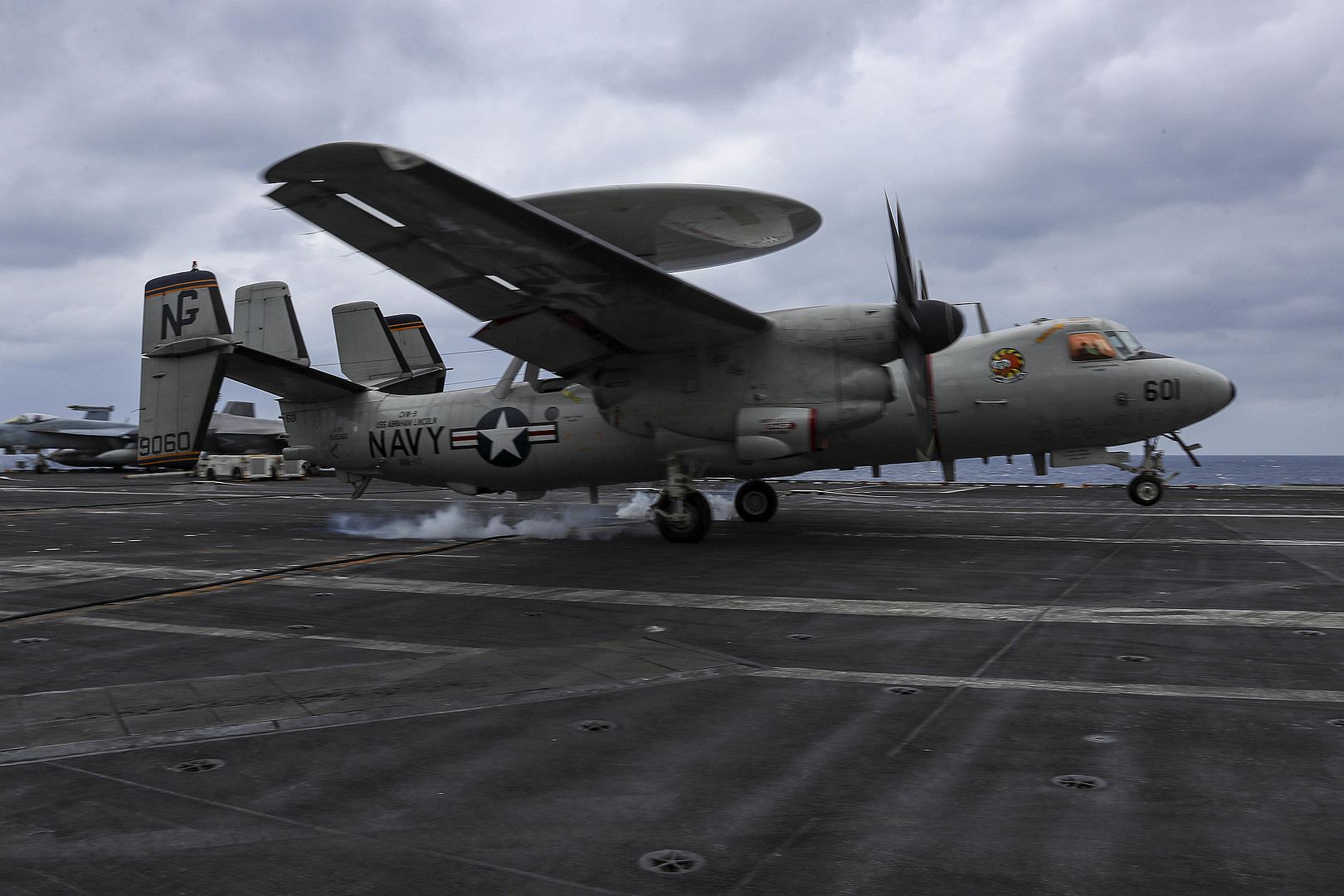
PHILIPPINE SEA (Feb. 21, 2022) An EA-18G Growler, assigned to the "Wizards" of Electronic Attack Squadron (VAQ) 133, prepares to make an arrested landing on the flight deck of the Nimitz-class aircraft carrier USS Abraham Lincoln (CVN 72). Abraham Lincoln Strike Group is on a scheduled deployment in the U.S. 7th Fleet area of operations to enhance interoperability through alliances and partnerships while serving as a ready-response force in support of a free and open Indo-Pacific region. (U.S. Navy photo by Mass Communication Specialist 3rd Class Javier Reyes).jpg?width=1920&height=1080&fit=bounds)
A U.S. Air Force F-35A Lightning II sits parked during exercise Cope North 22 at the Tinian international Airport, Feb. 9, 2022. Cope North enhances U.S. relationships with our regional allies and partners by fostering the exchange of information and refining shared tactics, techniques and procedures to better integrate multilateral defense capabilities and enhance interoperability in support of regional security. (U.S. Air Force photos by Senior Airman Joseph P. LeVeille)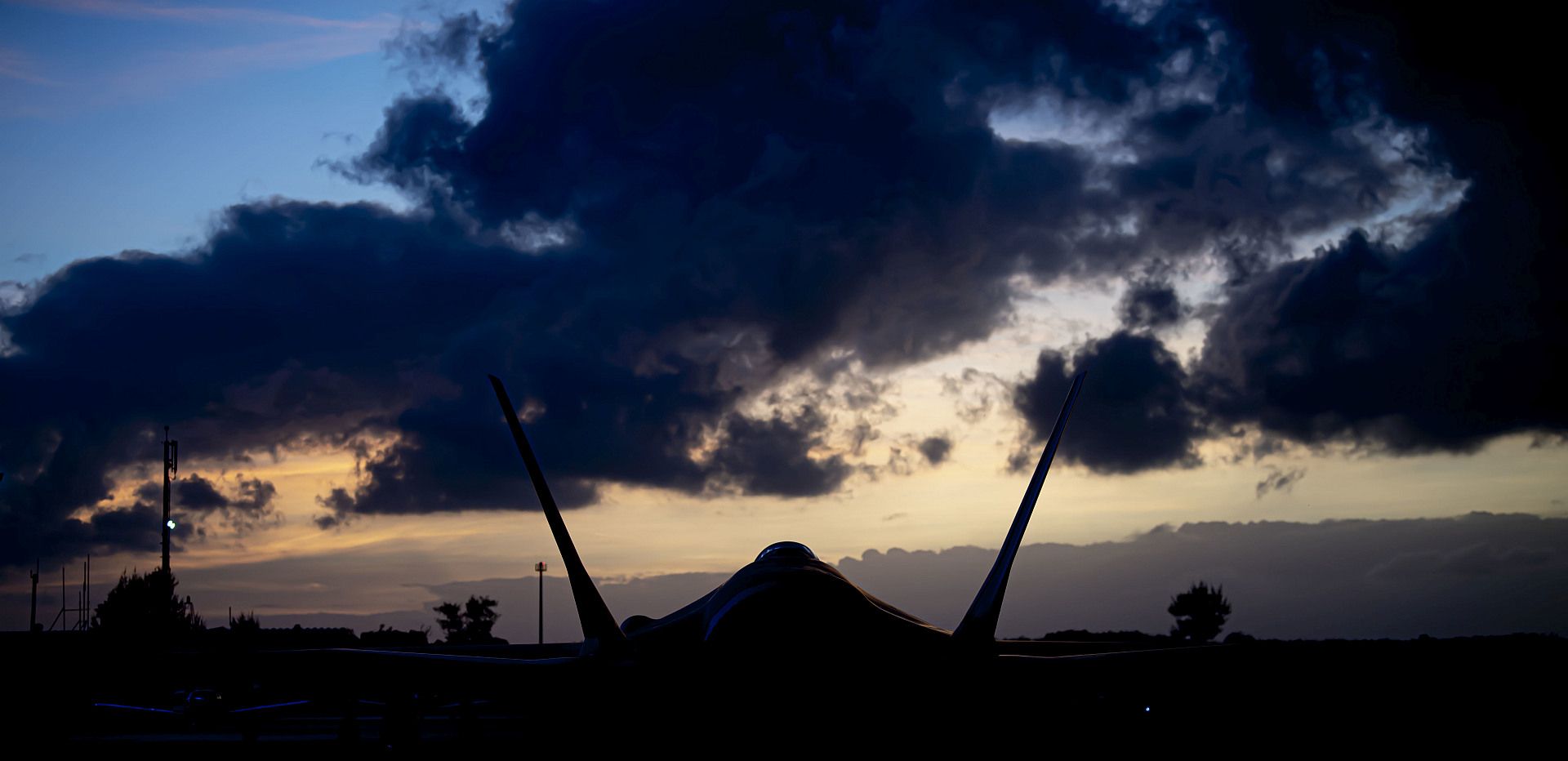
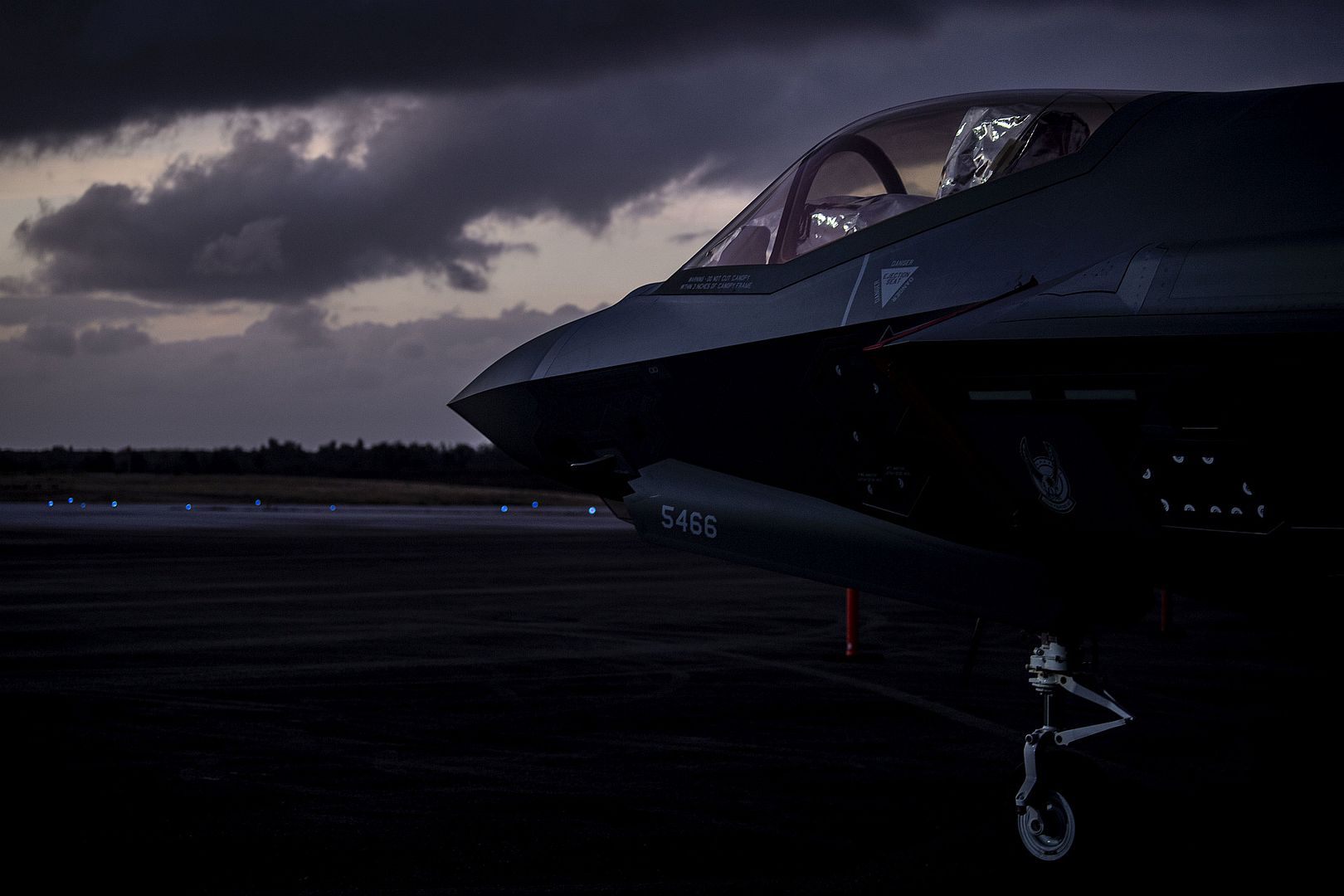
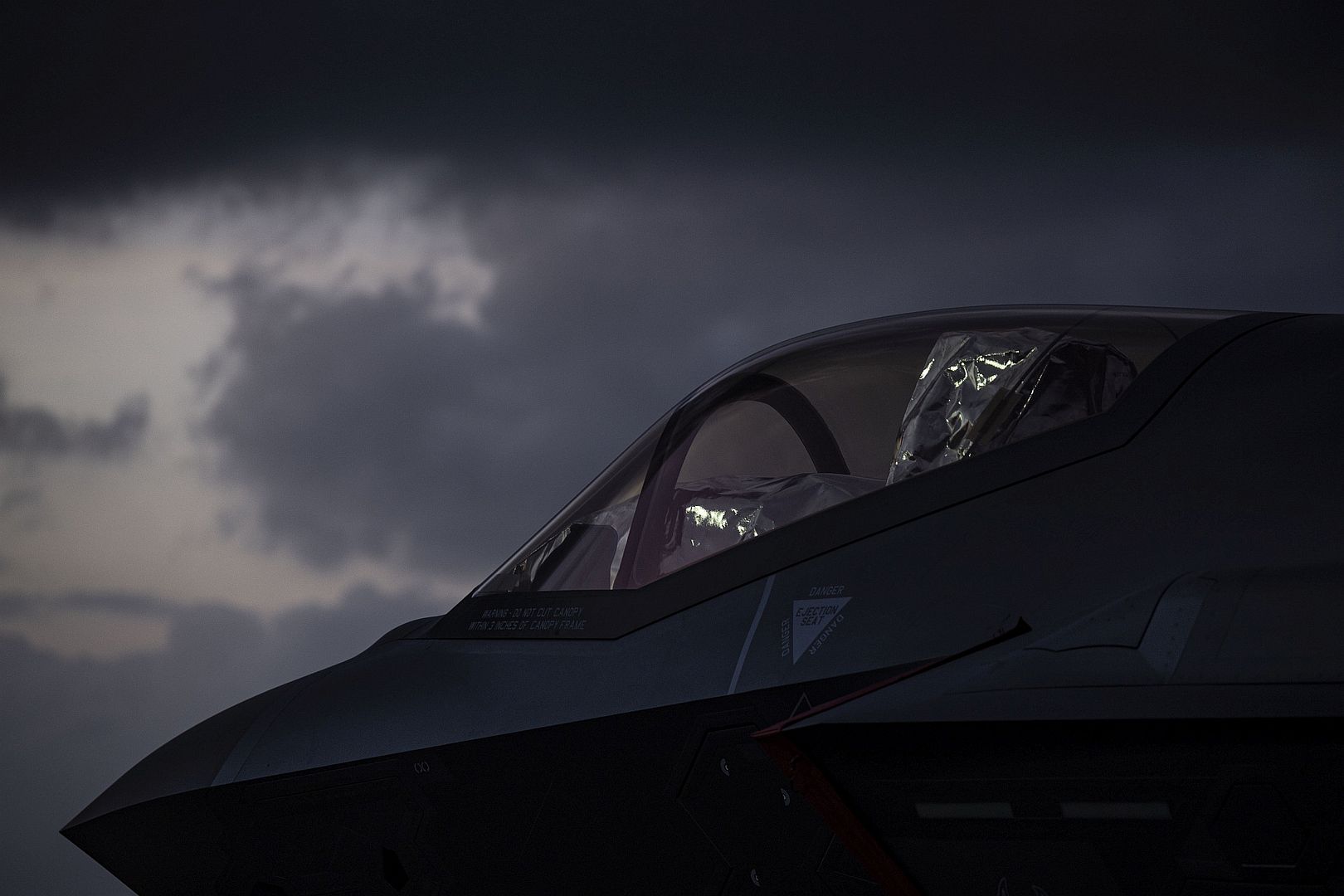
MIELEC, Poland, Feb. 22, 2022 – PZL Mielec, a Lockheed Martin company (NYSE: LMT) has signed a contract award with the Philippine Department of National Defense (DND) to manufacture 32 additional S-70i™ Black Hawk® utility helicopters for the Philippine Air Force. Delivery of all 32 aircraft by 2026 will dramatically increase the operational capacity of the Philippine Air Force to perform search and rescue missions, humanitarian assistance and disaster relief, and troop transport across the archipelagic country.
The Secretary of National Defense of the Philippines Delfin N. Lorenzana signed the contract with Janusz Zakręcki, president, general director of PZL Mielec. The contract signing took place February 22 at the Department of National Defense headquarters.
The Philippine Air Force’s 205th Tactical Helicopter Wing will receive all 32 aircraft in a utility configuration. Each aircraft will be equipped with a fully integrated digital cockpit with four axis coupled flight director, color weather radar, integrated vehicle health monitoring system (IVHMS), cabin troop seats, and a 9,000-pound (4,082 kg) cargo hook. Pilots and maintainers will receive training both in the U.S. and the Philippines.
“In the aftermath of Typhoon Odette (Rai), the Philippine Air Force has shown the world how its recently acquired Sikorsky S-70i Black Hawk fleet, designed and built to the toughest military standards, can quickly and reliably deliver emergency personnel and supplies to island populations across a large maritime area,” said Jason Lambert, vice president for Sikorsky Global Commercial & Military Systems.
Said Janusz Zakręcki, PZL Mielec president and general director: “Our Polish workforce is committed to build and deliver the next fleet of 32 Black Hawk aircraft on schedule, with the support that ensures these multi-role vehicles will protect and save lives while serving the Philippine people for decades to come.”
The Philippine contract for 32 aircraft is the largest single order of Black Hawk helicopters for PZL Mielec since S-70i aircraft production began in 2009. The contract signing comes two months after PZL Mielec, based in southern Poland, completed deliveries of 16 S-70i Combat Utility Helicopters on schedule to the Philippine Air Force 205th Tactical Helicopter Wing in December 2021.
Toulouse/Washington, 22 February 2022 – Airbus has signed a partnership agreement with CFM International, a 50/50 joint company between GE and Safran Aircraft Engines, to collaborate on a hydrogen demonstration programme that will take flight around the middle of this decade.
The programme’s objective is to ground and flight test a direct combustion engine fueled by hydrogen, in preparation for entry-into-service of a zero-emission aircraft by 2035. The demonstration will use a A380 flying testbed equipped with liquid hydrogen tanks prepared at Airbus facilities in France and Germany. Airbus will also define the hydrogen propulsion system requirements, oversee flight testing, and provide the A380 platform to test the hydrogen combustion engine in cruise phase.
CFM International (CFM) will modify the combustor, fuel system, and control system of a GE Passport turbofan to run on hydrogen. The engine, which is assembled in the US, was selected for this program because of its physical size, advanced turbo machinery, and fuel flow capability. It will be mounted along the rear fuselage of the flying testbed to allow engine emissions, including contrails, to be monitored separately from those of the engines powering the aircraft. CFM will execute an extensive ground test program ahead of the A380 flight test.
“This is the most significant step undertaken at Airbus to usher in a new era of hydrogen-powered flight since the unveiling of our ZEROe concepts back in September 2020,” said Sabine Klauke, Airbus Chief Technical Officer. “By leveraging the expertise of American and European engine manufacturers to make progress on hydrogen combustion technology, this international partnership sends a clear message that our industry is committed to making zero-emission flight a reality.”
“Hydrogen combustion capability is one of the foundational technologies we are developing and maturing as part of the CFM RISE Program,” said Gaël Méheust, president & CEO of CFM. “Bringing together the collective capabilities and experience of CFM, our parent companies, and Airbus, we really do have the dream team in place to successfully demonstrate a hydrogen propulsion system.”
CFM shares Airbus’ ambition of fulfilling the promise they made in signing the Air Transport Action Group goal in October 2021 to achieve aviation industry net-zero carbon emissions by 2050 by developing and testing the technology necessary to make zero emissions aircraft a reality within the ambitious timeline defined.
Airbus has a long-standing relationship with CFM and its parent companies, GE Aviation and Safran Aircraft Engines and, together, the partners have established a great track record of delivering high-performance products that meet the needs of airline customers.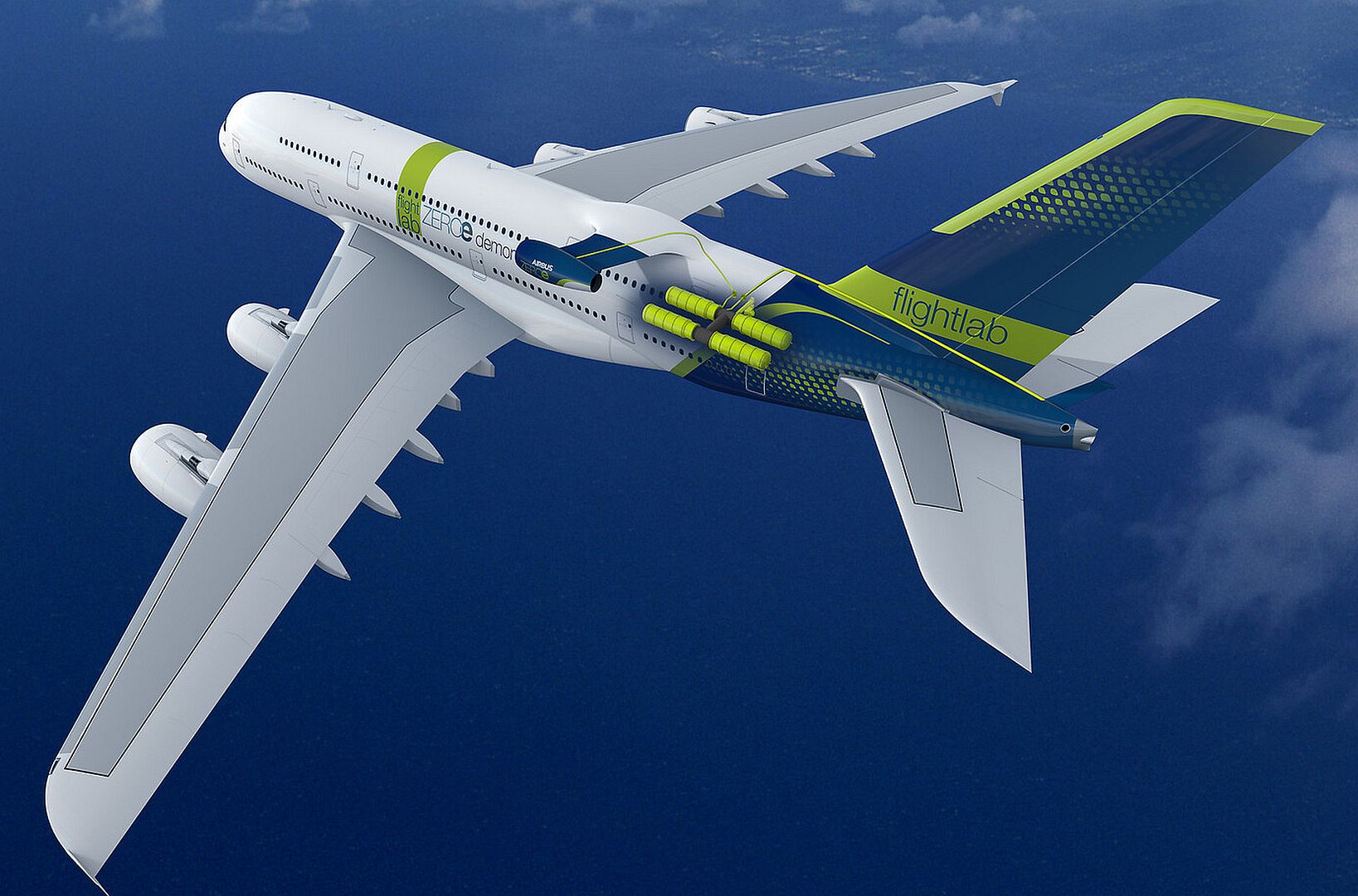
-
2 years agoWed Feb 23 2022, 08:54pmDuggy
 Main AdminU.S. Air Force and Royal Netherlands Air Force F-35A Lightning II aircraft, conduct a bilateral air-to-air training exercise over the Netherlands, Feb. 22, 2022. The F-35A is a fifth-generation multirole fighter that combines stealth, sensor fusion and unprecedented situational awareness. (U.S. Air Force Photos By Tech. Sgt. Rachel Maxwell)
Main AdminU.S. Air Force and Royal Netherlands Air Force F-35A Lightning II aircraft, conduct a bilateral air-to-air training exercise over the Netherlands, Feb. 22, 2022. The F-35A is a fifth-generation multirole fighter that combines stealth, sensor fusion and unprecedented situational awareness. (U.S. Air Force Photos By Tech. Sgt. Rachel Maxwell)
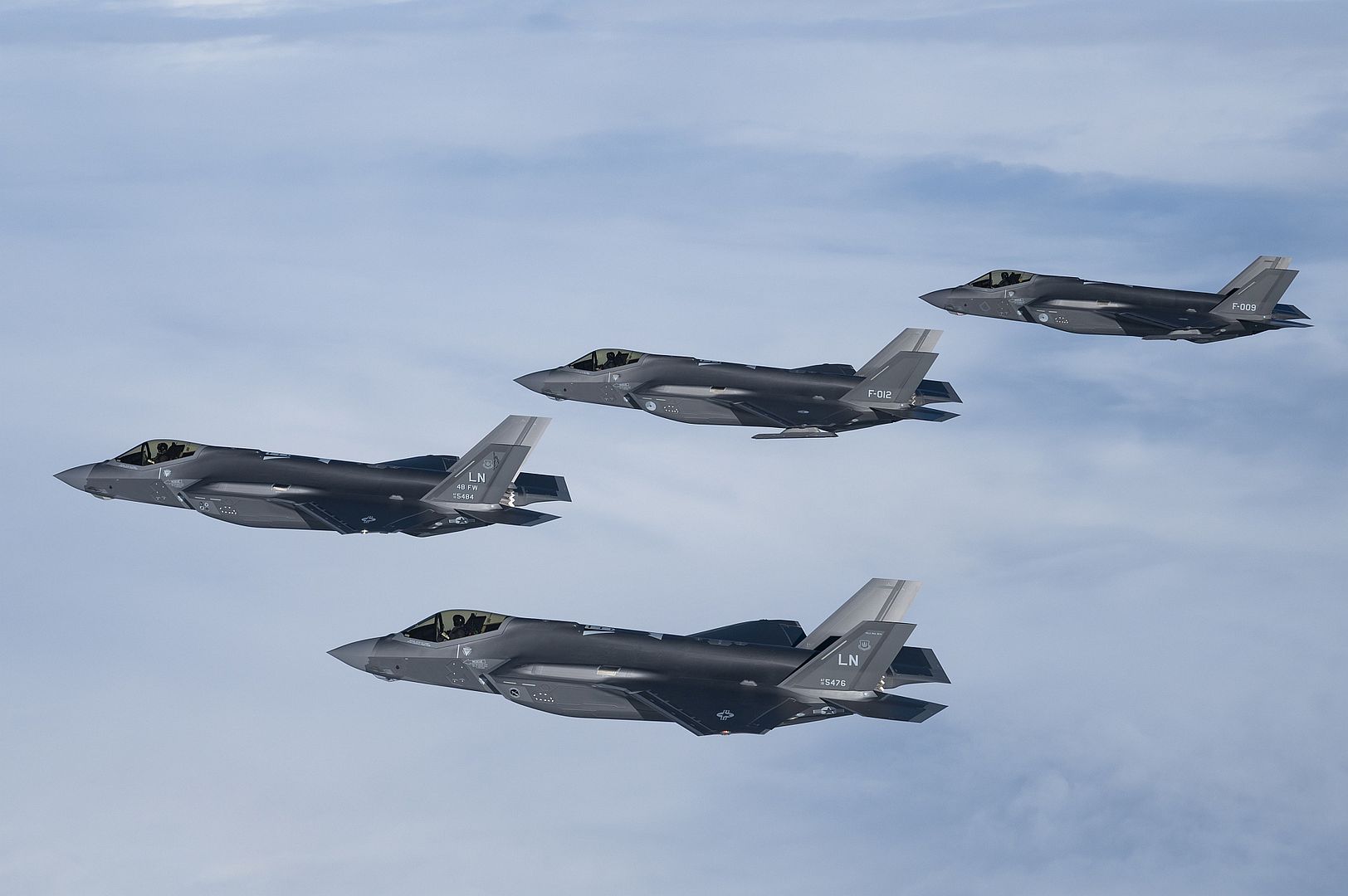
A U.S. Air Force F-15E Strike Eagle leads a three-ship formation with U.S. and Dutch F-35A Lightning II aircraft, during a bilateral air-to-air training exercise over the Netherlands, Feb. 22, 2022. The U.S. and its allies are bound by shared principles of democracy, national sovereignty, and commitment to Article 5 of the North Atlantic Treaty, vital to ensuring a strong and free Europe. (U.S. Air Force Photo By Tech. Sgt. Rachel Maxwell)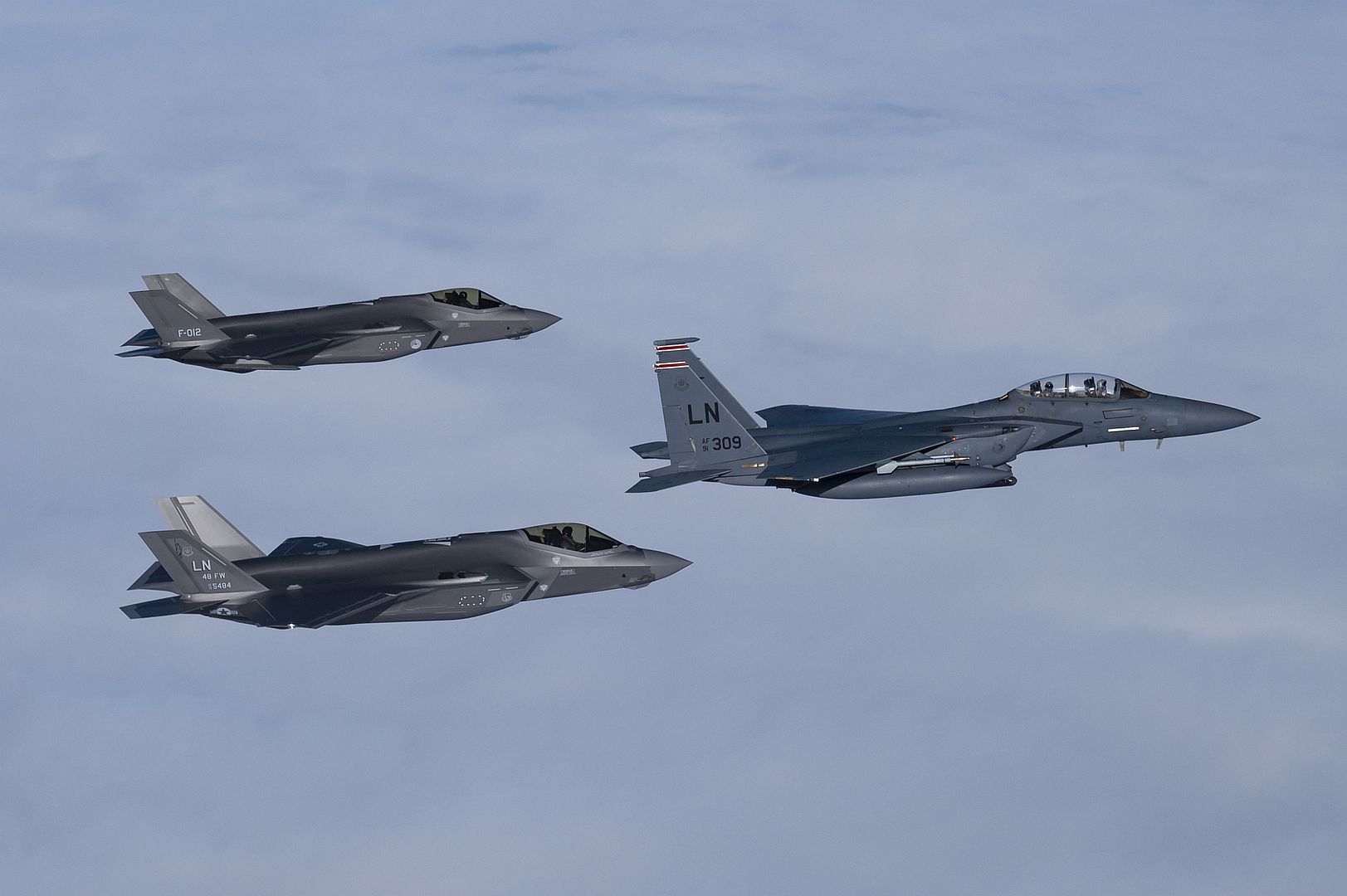
An F-22 Raptor takes off from Al Dhafra Air Base, United Arab Emirates, Feb. 21, 2022. The F-22s were rapidly deployed to the base earlier in the month on order from the U.S. Secretary of Defense in coordination with the Abu Dhabi Crown Prince and join a range of joint, coalition and allied and partner combat airpower capabilities already based in the region. (U.S. Air Force [photo by Master Sgt. Dan Heaton)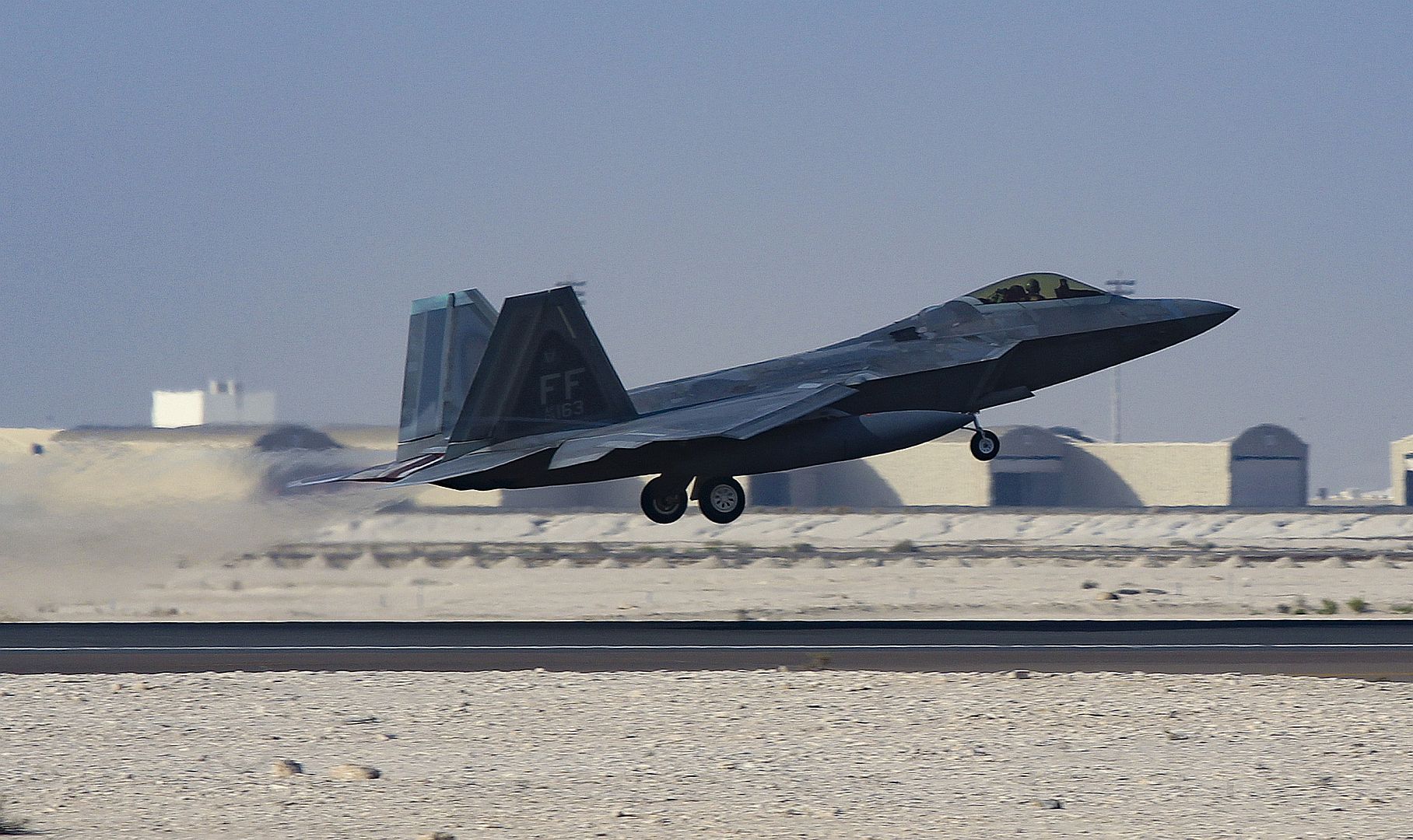
PHILIPPINE SEA (Feb. 22, 2022) An F/A-18F Super Hornet, assigned to the "Black Aces" of Strike Fighter Squadron (VFA) 41, launches from the flight deck of the Nimitz-class aircraft carrier USS Abraham Lincoln (CVN 72). Abraham Lincoln Strike Group is on a scheduled deployment in the U.S. 7th Fleet area of operations to enhance interoperability through alliances and partnerships while serving as a ready-response force in support of a free and open Indo-Pacific region. (U.S. Navy photo by Mass Communication Specialist 3rd Class Michael Singley).jpg?width=1920&height=1080&fit=bounds)
ADRIATIC SEA (Feb. 22, 2022) An F/A-18E Super Hornet, attached to the “Fighting Checkmates” of Strike Fighter Squadron (VFA) 211, launches from the flight deck of the Nimitz-class aircraft carrier USS Harry S. Truman (CVN 75), Feb. 22, 2022. The Harry S. Truman Carrier Strike Group is on a scheduled deployment in the U.S. Sixth Fleet area of operations in support of U.S., allied and partner interests in Europe and Africa. (U.S. Navy photo by Mass Communication Specialist 2nd Class Kelsey Trinh)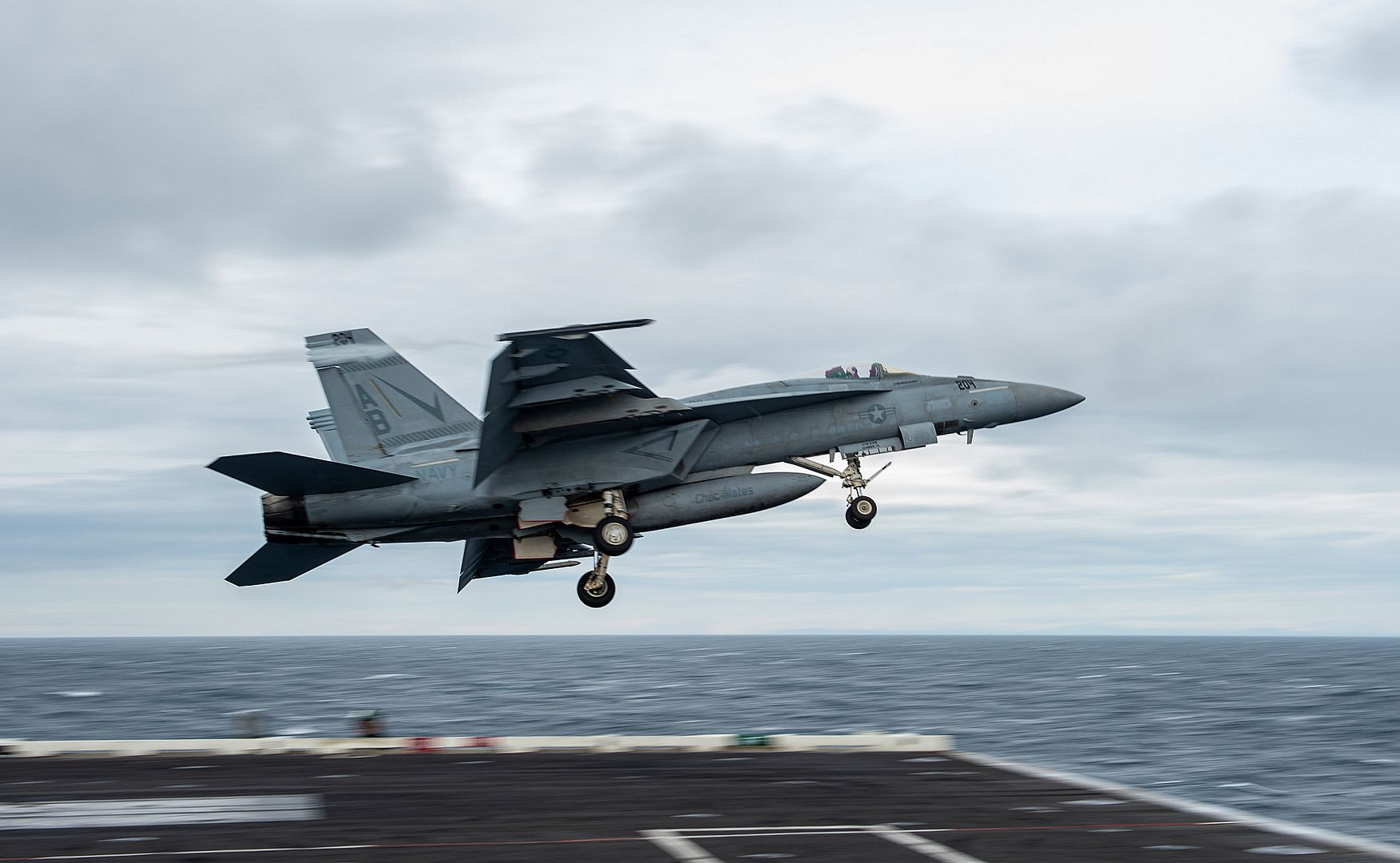
ADRIATIC SEA (Feb. 22, 2022) An EA-18G Growler, attached to the "Rooks" of Electronic Attack Squadron (VAQ) 137, lands on the flight deck of the Nimitz-class aircraft carrier USS Harry S. Truman (CVN 75), Feb. 22, 2022. The Harry S. Truman Carrier Strike Group is on a scheduled deployment in the U.S. Sixth Fleet area of operations in support of U.S., allied and partner interests in Europe and Africa. (U.S. Navy photo by Mass Communication Specialist 2nd Class Kelsey Trinh)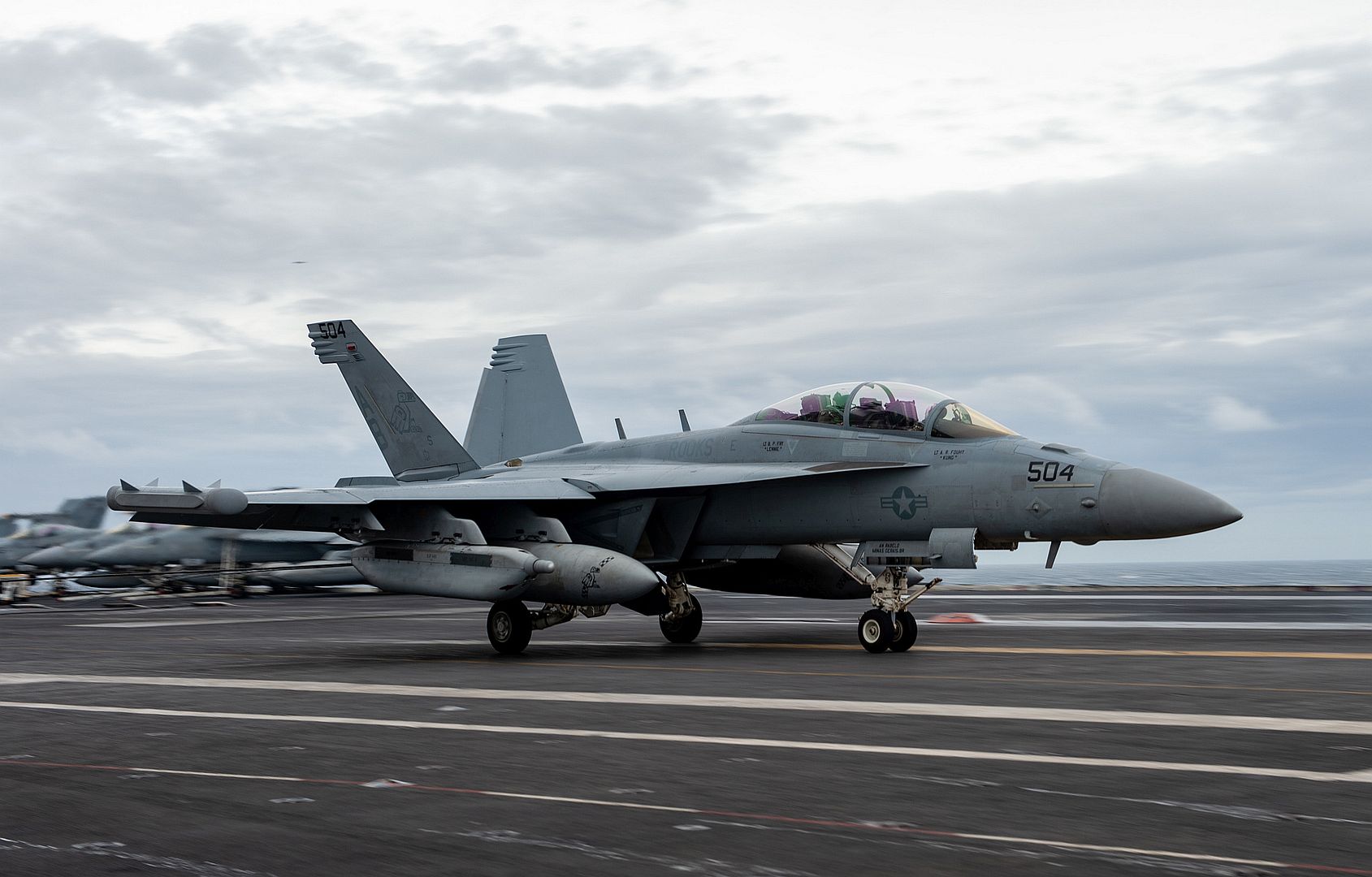
02.23.2022
A CMV-22B Osprey tiltrotor aircraft assigned to the "Titans" of Fleet Logistics Multi-Mission Squadron (VRM) 30, prepares to land at Commander, Fleet Activities Sasebo (CFAS) while conducting passenger and cargo transfer operations. For 75 years, CFAS has provided, maintained, and operated base facilities and services to empower forward-deployed U.S. and Allied Forces while providing superior support to their families and the community. (U.S. Navy photo by Mass Communication Specialist 1st Class Jeremy Graham)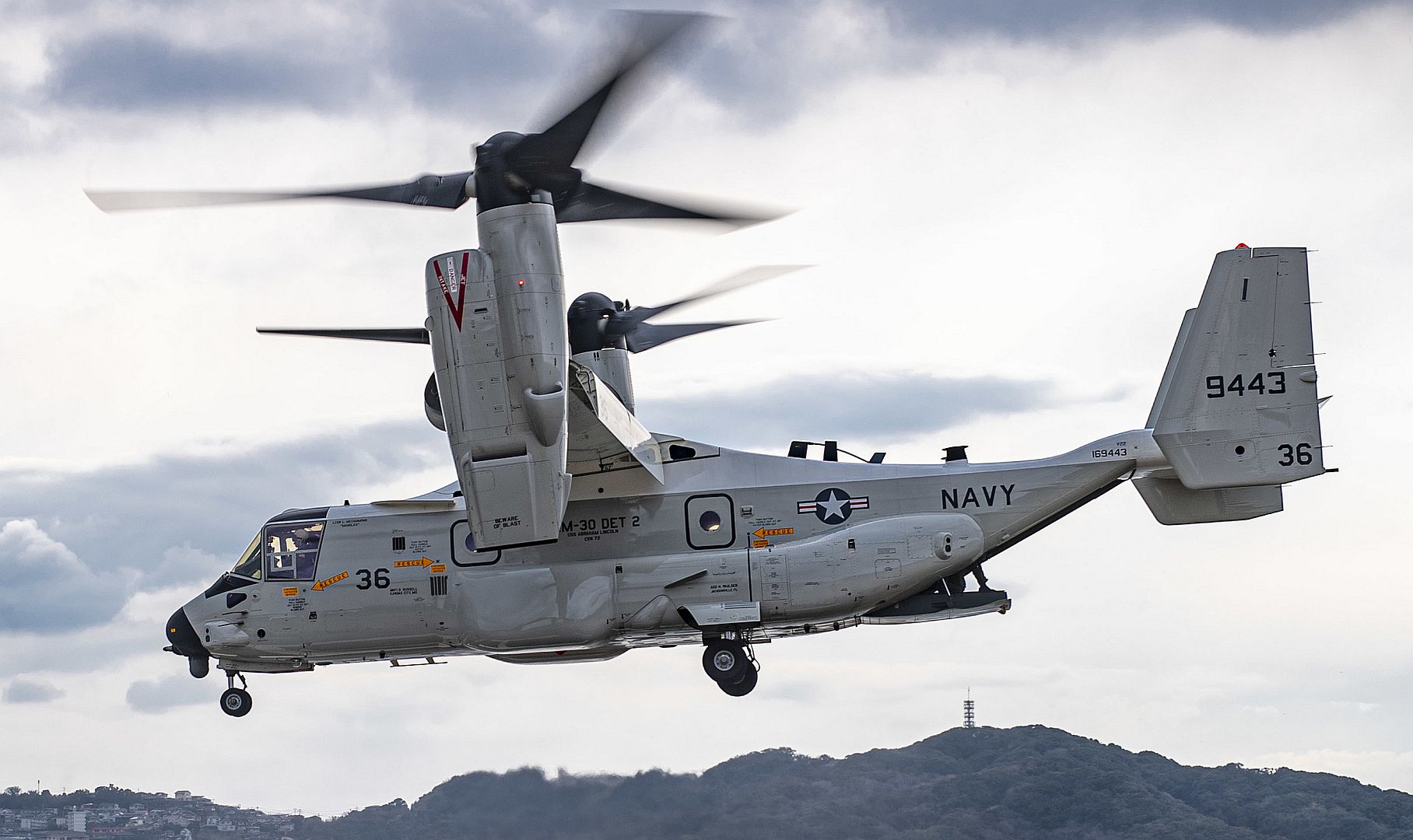
U.S. Air Force F-16 Fighting Falcon pilots assigned to the 18th Aggressor Squadron conduct aerial refueling with a KC-135 Stratotanker aircraft assigned to the 909th Air Refueling Squadron during exercise Cope North 22 over the Pacific Ocean, Feb. 17, 2022. CN 22 allows each nation to hone vital readiness skills and enhance interoperability among multiple mission areas to include air superiority, interdiction, electronic warfare, tactical airlift, and aerial refueling capabilities. (U.S. Air Force photos by Master Sgt. Joey Swafford)
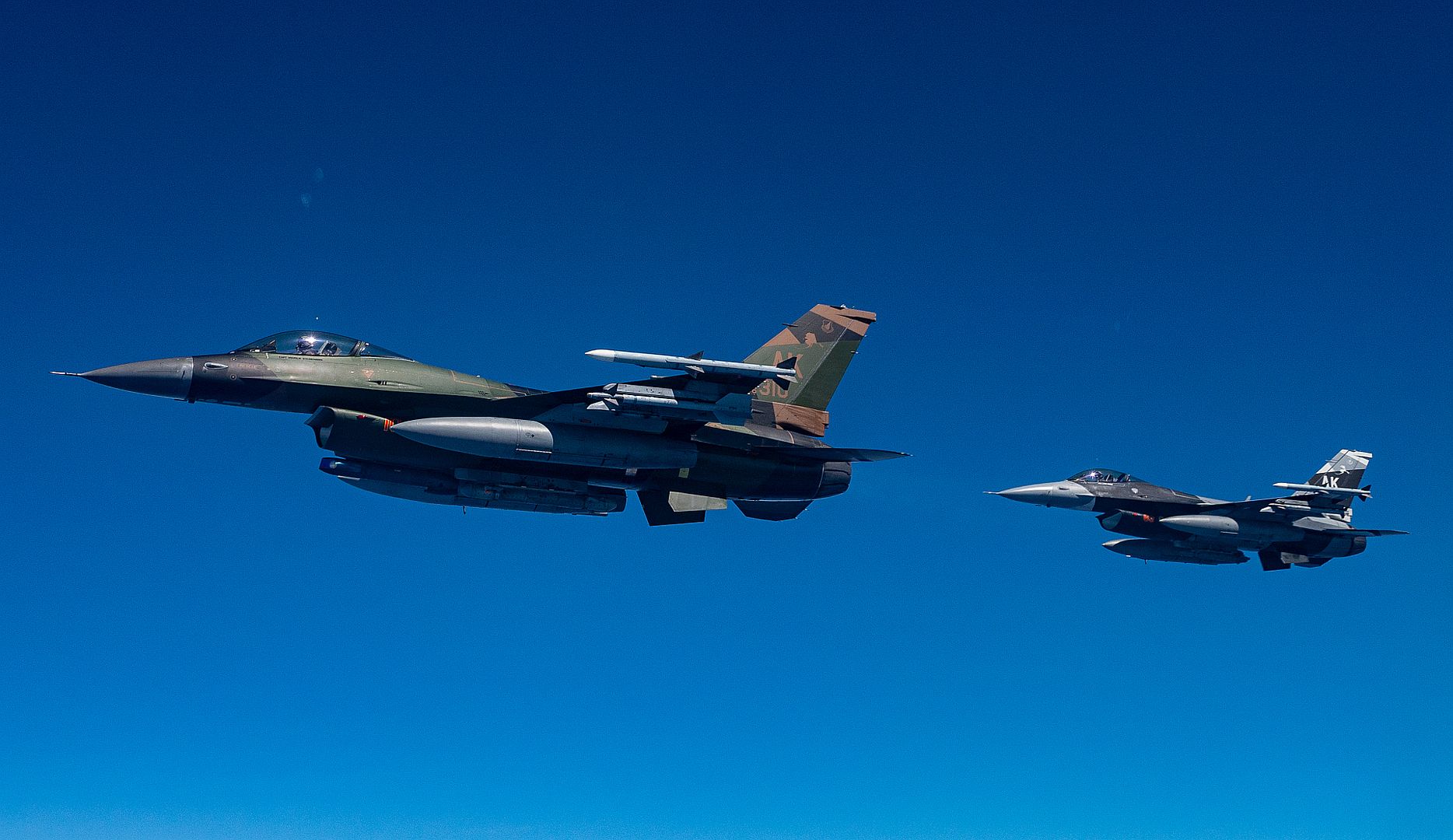
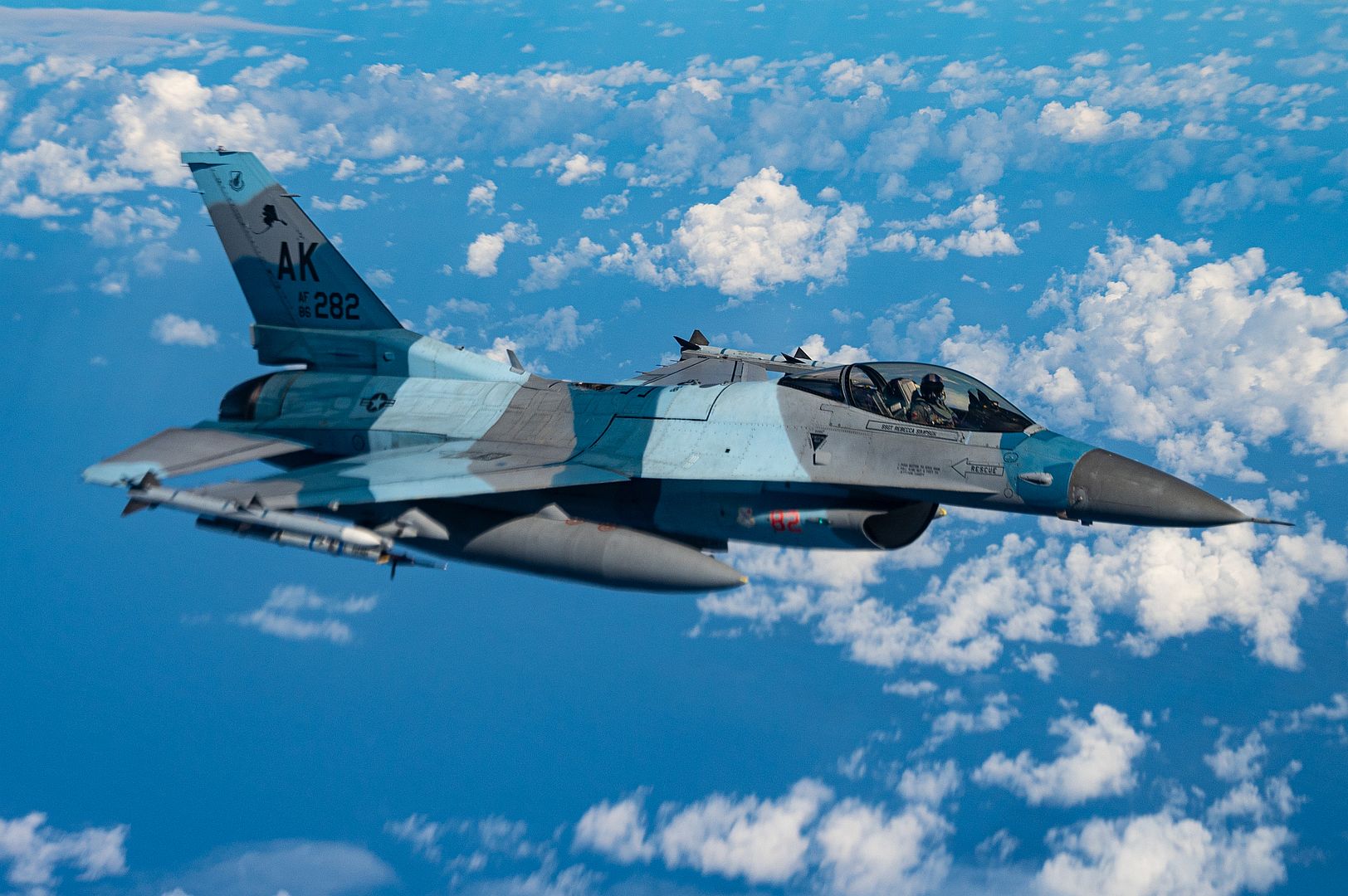
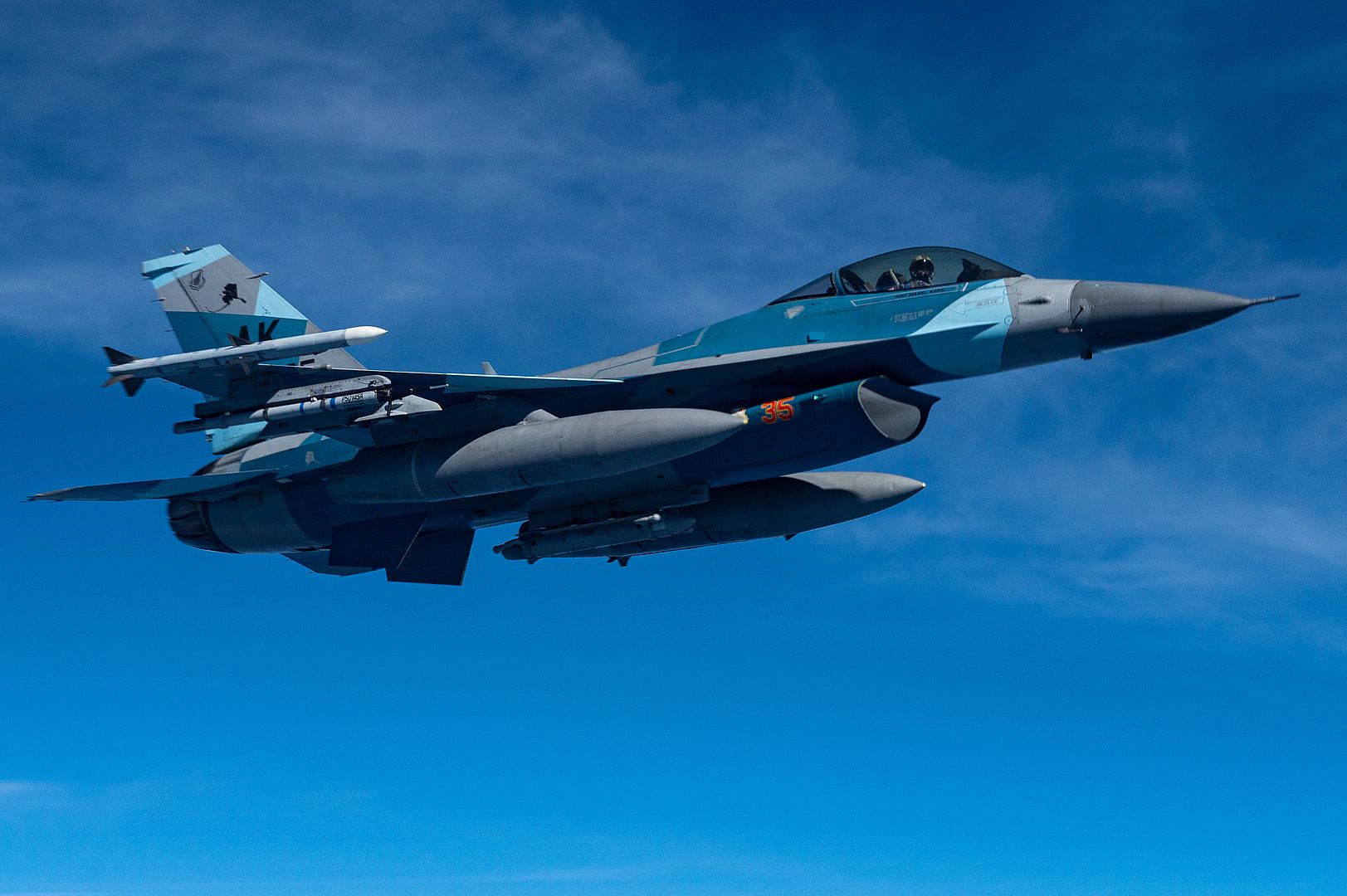
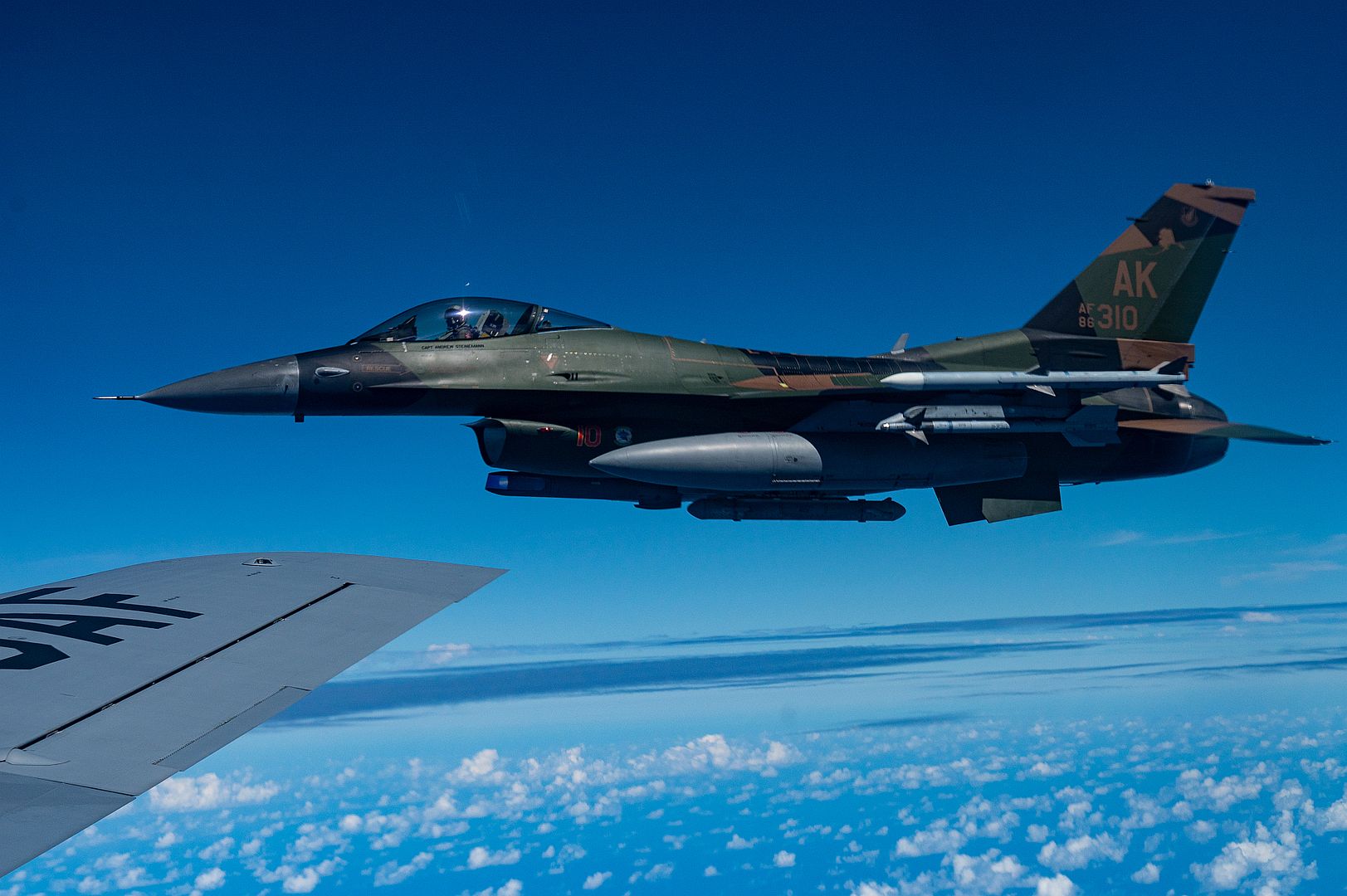
LINTHICUM, Md. – Feb. 23, 2022 – Northrop Grumman Corporation (NYSE: NOC) is developing a digital replica of its flying CRJ testbed airframe and subsystems to take full advantage of digital engineering capabilities in the development of new product lines of mission systems.
The company’s Digital Shadow testbed will enable faster and more agile development, modification and testing of new capabilities across programs. Digital Shadow will test digital representations of sensors, such as fighter radars, in a realistic virtual environment on the aircraft that simulates current and future capabilities and collects performance data.
“Our Digital Shadow testbed will enable the rapid iteration and assessment of various mission systems configurations and trades via digital models across the entire lifecycle,” said Roshan Roeder, vice president, airborne multifunction sensors, Northrop Grumman. “Extending the digital thread and developing a digital twin of our test aircraft allows us to rapidly collect valuable data of our mission systems all while reducing cost, schedule and risk.”
The company has been developing authoritative digital twins of its current and future capabilities across the enterprise to help reduce cost and accelerate development. These digital models and deep data stores enable engineers to answer questions with increased speed and agility. The Digital Shadow testbed, a virtual mission systems integration lab, provides the ability to correlate digital sensor representations with their physical design, further validating system and performance models and leveraging Northrop Grumman’s large repository of data collection.
By creating a digital version of the aircraft and the onboard mission system suites and rapidly reconfiguring and integrating sensors across the spectrum, the company can virtually fly scenarios and sensor combinations beyond the physical testbed limitations, thus increasing the breadth and scale of experimentation, and reducing timeline and flight test costs — ultimately extending mission capabilities for the warfighter. The company’s Digital Shadow testbed will enhance the ability to upgrade capabilities through software to stay ahead of evolving threats and reduce development and sustainment costs.
Northrop Grumman is integrating digital technologies to rapidly conceptualize, design, build and sustain value-driven solutions. For additional information about how Northrop Grumman is developing digital models through every step of the product lifecycle, visit Northrop Grumman.
Northrop Grumman is a technology company, focused on global security and human discovery. Our pioneering solutions equip our customers with capabilities they need to connect, advance and protect the U.S. and its allies. Driven by a shared purpose to solve our customers’ toughest problems, our 90,000 employees define possible every day.
MESA, Ariz., Feb. 23, 2022 -- Boeing [NYSE:BA] has been awarded a $103.7 million contract by the U.S. Department of Defense as part of a foreign military sale for eight AH-6 light attack reconnaissance helicopters to Thailand. The contract also includes spares, training devices, support equipment, and technical publications for the Royal Thai Army.
The deal paves the way for the Royal Thai Army to replace its fleet of aging AH-1F Cobras as part of the country’s defense modernization efforts. The aircraft will be produced in Mesa, Arizona, with deliveries planned through 2024.
“We welcome Thailand's selection of Boeing's AH-6 light attack reconnaissance helicopter and look forward to working with the U.S. and Thai governments as part of the foreign military sale process,” said Jessie Farrington, business development director of Attack Helicopter Programs. “From its unmatched power-to-weight ratio to its extensive, integrated digital communications suite, the AH-6 offers superior performance, capability and versatility and will be a force-multiplier for the Royal Thai Army."
Thailand is Boeing’s second international customer for the aircraft. Boeing has a long and proven track record of being a trusted partner to Thailand’s aviation and defense customers for more than 60 years.
A beneficiary of ongoing AH-64 Apache modernization efforts, the AH-6 features an advanced mission computer capable of processing large amounts of data and sharing system information with the rest of the aircraft quickly — enhancing safety and situational awareness, enabling faster decision making, reducing pilot workload and decreasing support costs throughout the aircraft’s life cycle.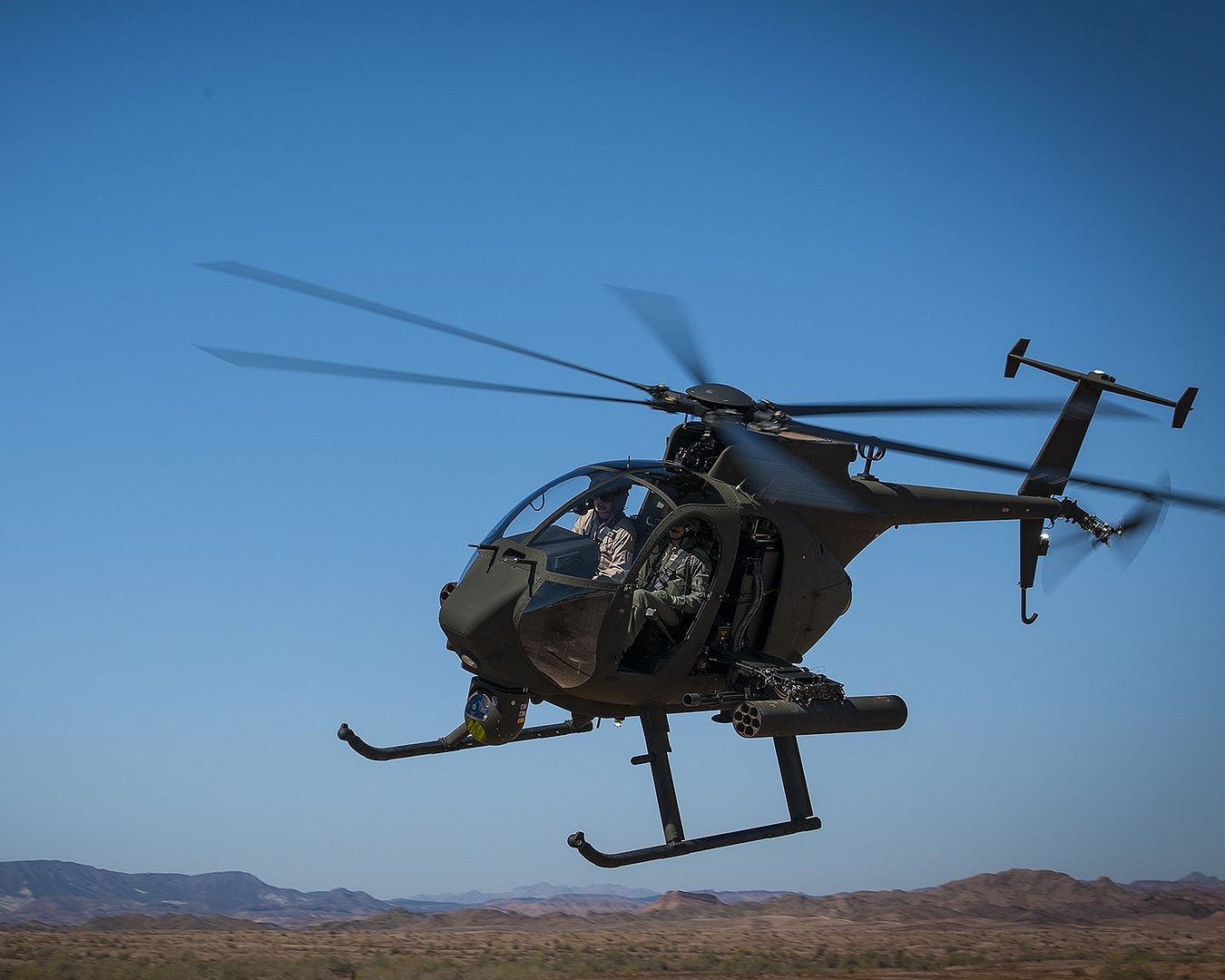
Getafe, 23 February 2022 – The Serbian Ministry of Defence has ordered two Airbus C295s and therefore the Serbian Air Force and Air Defence joins the family of C295 becoming the 36th operator worldwide.
The contract was signed in Madrid in the presence of senior government members of the Republic of Serbia and Spain. This contract will be accompanied by a Government-to-Government supervision agreement between the Ministries of Defence of Spain and the Republic of Serbia, which aims to study the development of future defence programmes between both nations. Airbus is committed to maintain and foster its close collaboration with the Republic of Serbia, which already operates Airbus military solutions.
The two aircraft, in transport configuration, will be equipped with the modern avionics suite Collins Aerospace Pro Line Fusion® and will contribute to enhance the air transport capabilities of the Republic of Serbia.
Deliveries are expected to commence in late 2023.
With this order 33 countries have already relied on the Airbus C295. With a total of 281 orders worldwide and more than half a million flight hours in operation, this aircraft is the undisputed leader in its segment.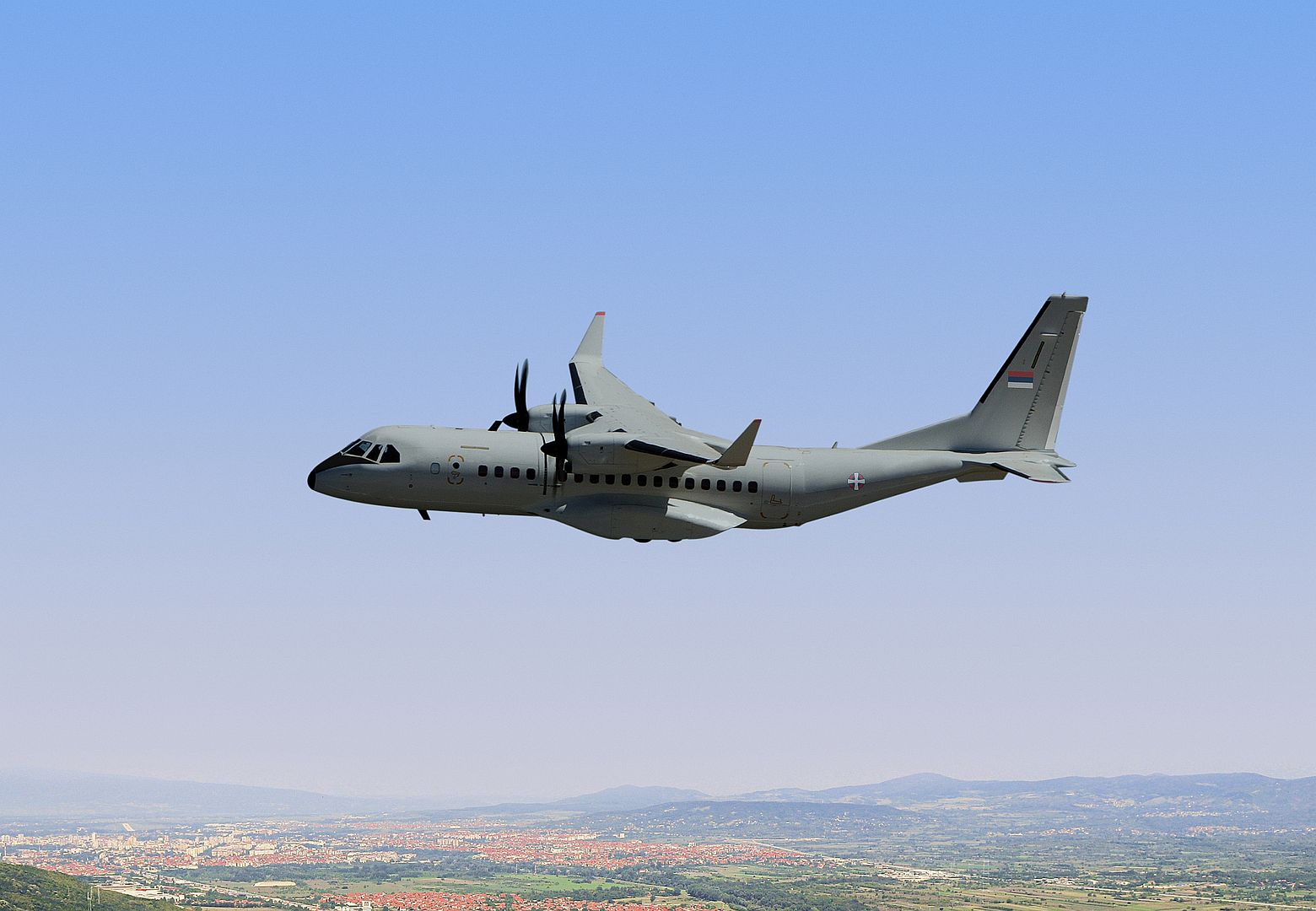
-
 Main Admin02.22.2022.
Main Admin02.22.2022.
1st Air Cavalry Brigade, which is in Europe for Atlantic Resolve, moves AH64 Apaches and UH60 Blackhawks from Greece to Poland to support the United States’ decision to increase its presence and activities in Europe as part of its strong and unremitting commitment to our NATO allies and partners.
(Photos by Capt. Taylor Criswell)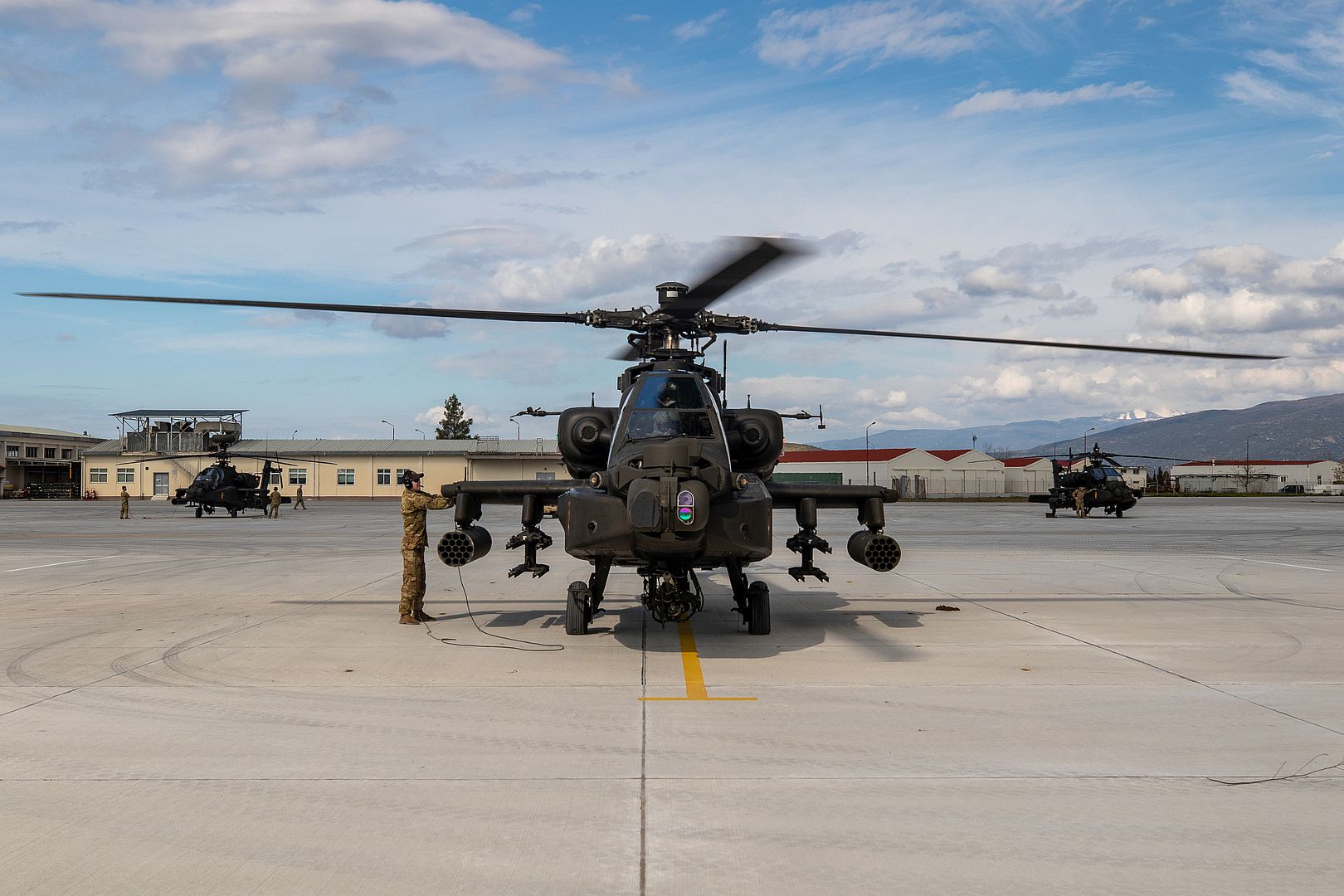
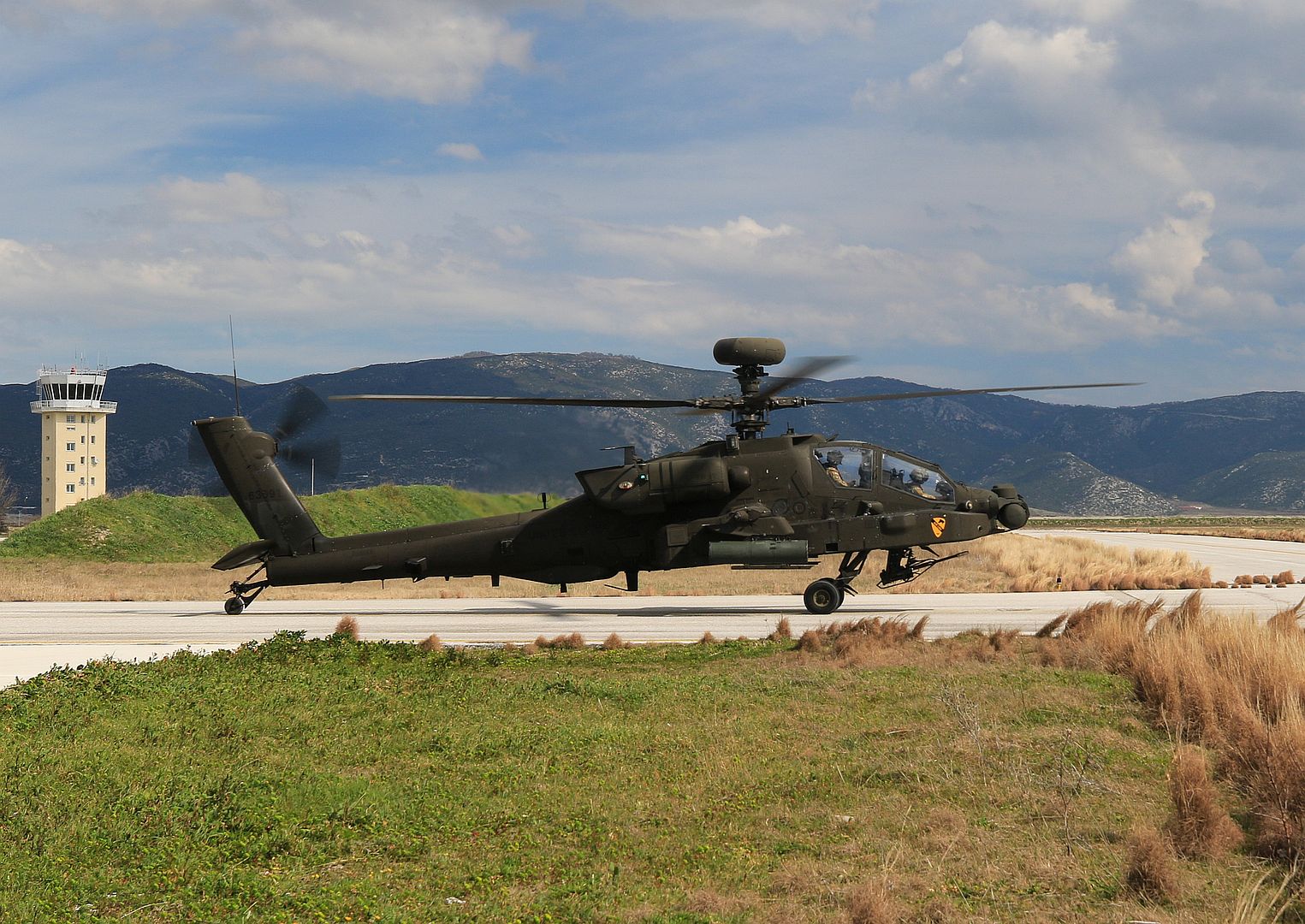
The U.S. Army Parachute Team jump aircraft, the C-147A, is shown in the early dawn hours during pre-flight inspections in Homestead, Florida on 24 Feb. 2022. USAPT is conducting night jump operations as part of their annual certification cycle for the upcoming show season. (U.S. Army photo by Megan Hackett)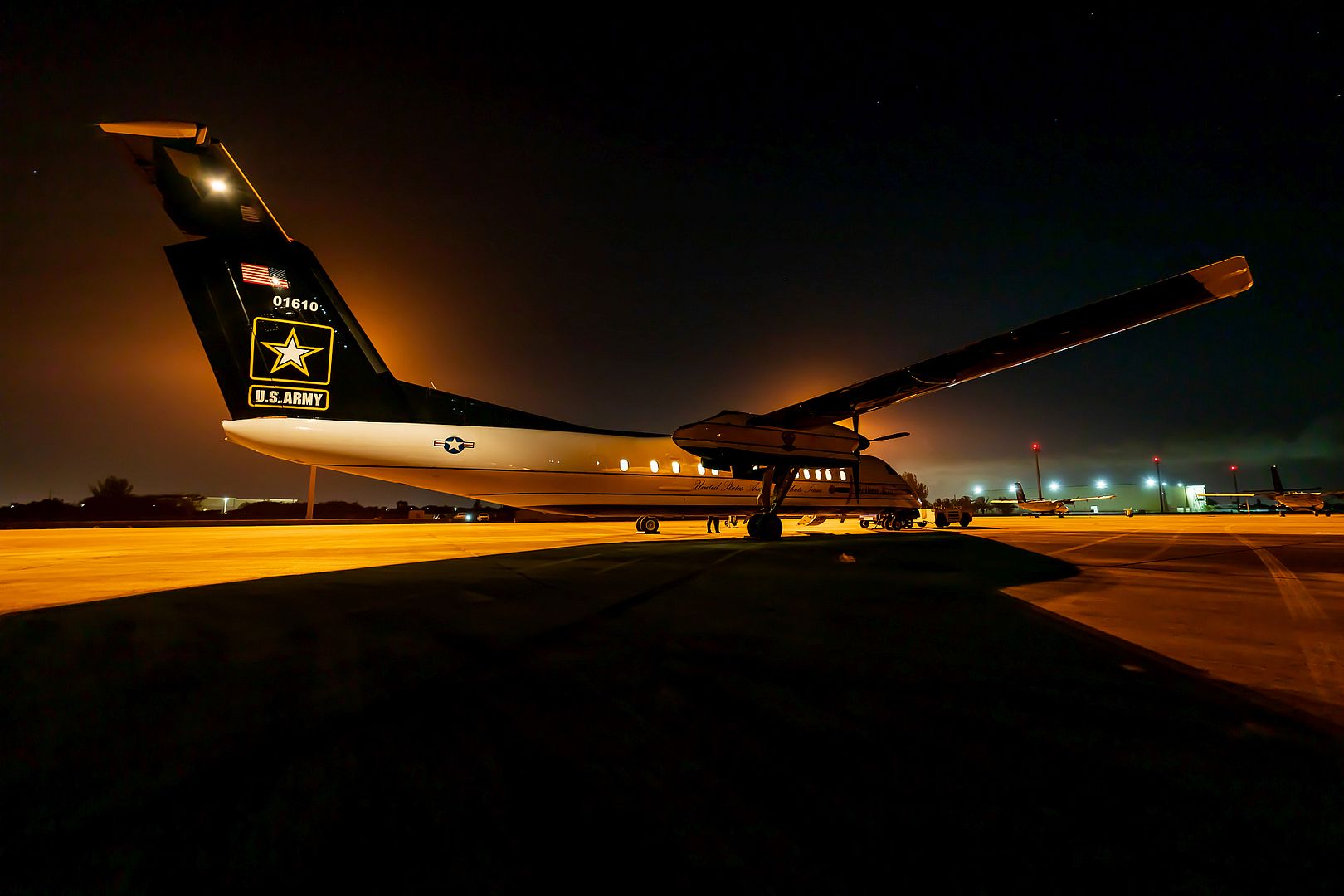
A U.S. Air Force F-35A Lightning II assigned to 34th Fighter Squadron, Hill Air Force Base, Utah, taxis at Spangdahlem Air Base, Germany, Feb. 24, 2022. USAFE’s ability to support and integrate with NATO’s air policing missions continually hardens the alliance’s solidarity, collective resolve, and ability to adapt to a dynamic warfighting environment. (U.S. Air Force photo by Staff Sgt. Melody W. Howley)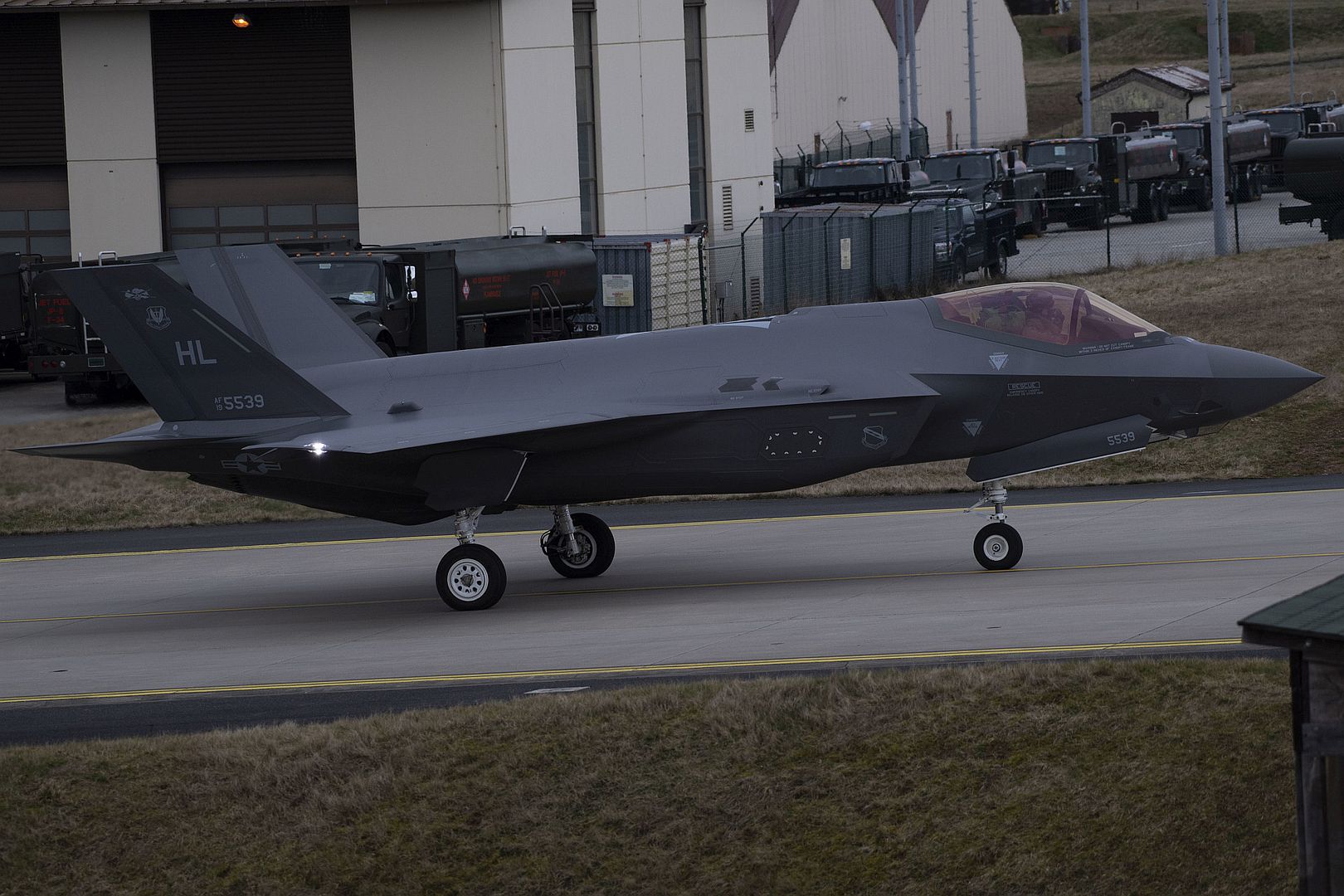
Two U.S. Air Force F-35 Lightning II aircraft assigned to the 34th Fighter Squadron at Hill Air Force Base, Utah, arrive at Ämari AB, Estonia, Feb. 24, 2022. Aircraft and crews will work closely with Allies in the Black Sea region to reinforce regional security during the current tensions caused by Russia's continuing military build-up near Ukraine. (Courtesy Photo)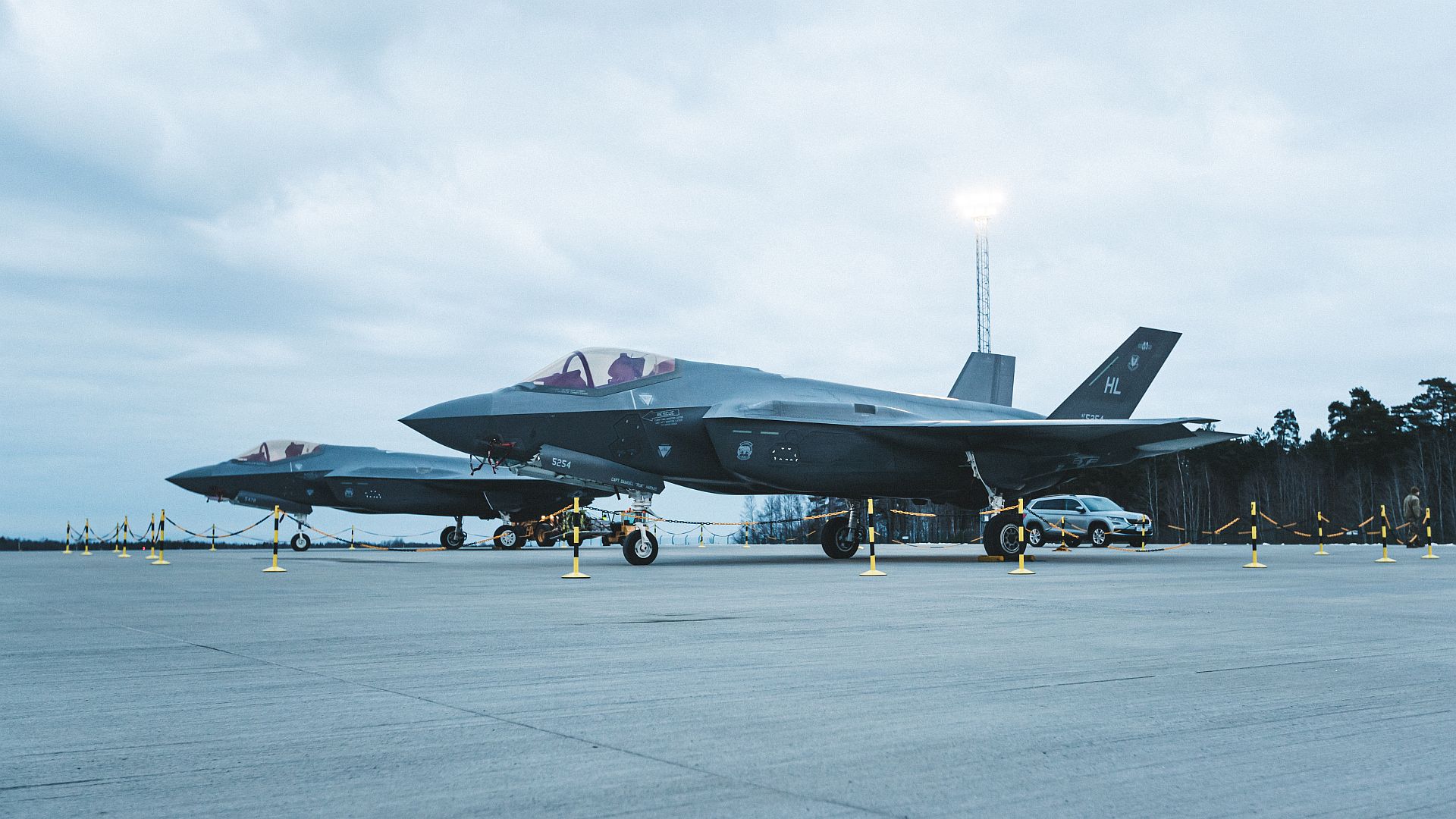
U.S. Air Force F-35A Lightning II aircraft assigned to the 495th Fighter Squadron, return to Royal Air Force Lakenheath, England, after concluding a training exercise with NATO allies, Feb. 22, 2022. The Liberty Wing strives to increase defense and modernization in the European theater, to bolster the NATO alliance in the face of shared security concerns. (U.S. Air Force Photo By Tech. Sgt. Rachel Maxwell)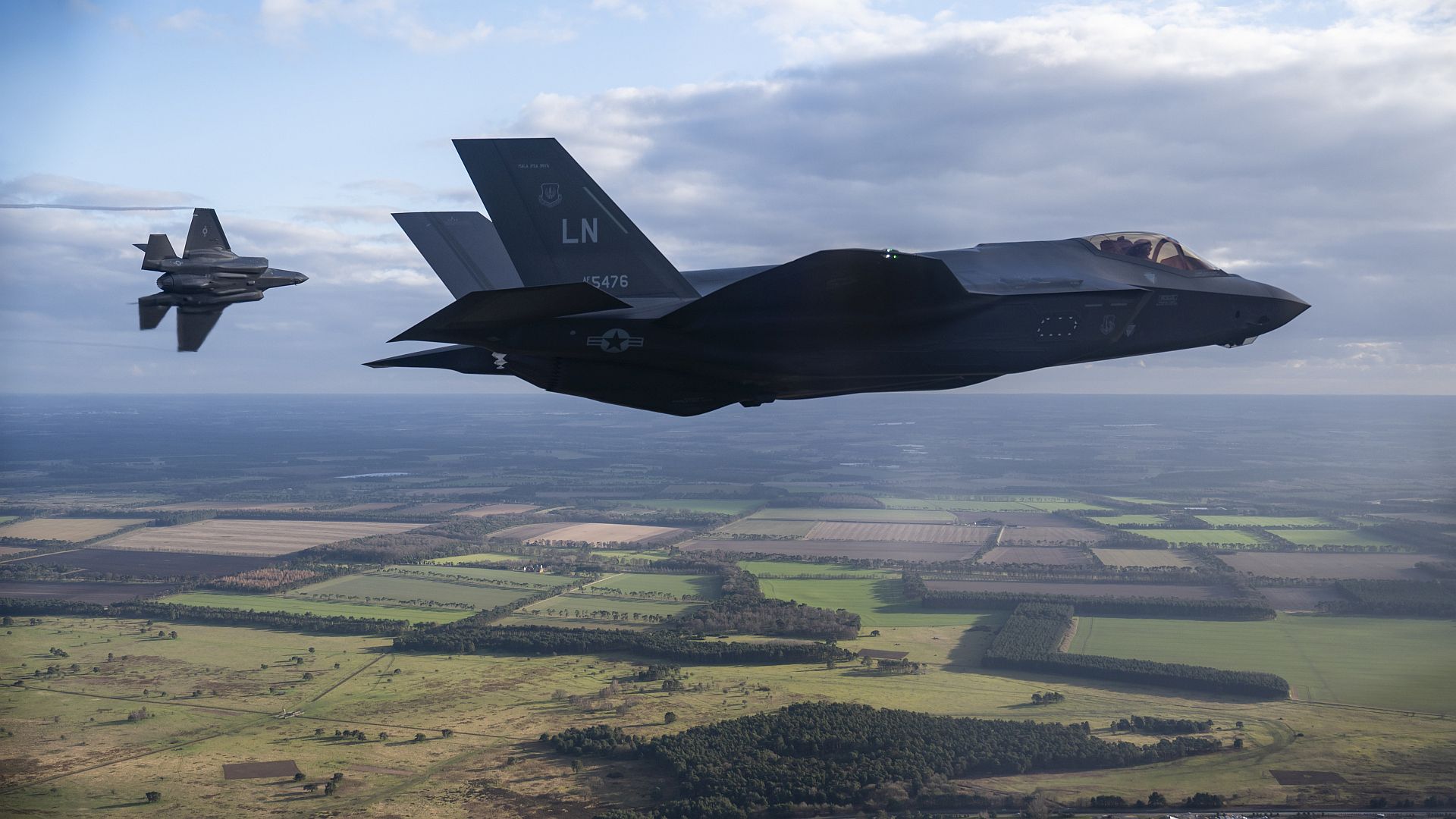
A U.S. Air Force F-35 Lightning II aircraft assigned to the 34th Fighter Squadron departs from a KC-10 Extender aircraft after receiving fuel over Poland, Feb. 24, 2022. U.S. Air Forces in Europe and Air Forces Africa’s ability to support and integrate with NATO’s air policing missions continually hardens the alliance’s solidarity, collective resolve, and ability to adapt to a dynamic war fighting environment. (U.S. Air Force photo by Senior Airman Joseph Barron)
PHILIPPINE SEA (Feb. 22, 2022) An F-35C Lightning II assigned to the "Black Knights" of Marine Fighter Attack Squadron (VMFA) 314 launches from the flight deck of the Nimitz-class aircraft carrier USS Abraham Lincoln (CVN 72). The Abraham Lincoln Carrier Strike Group is on a scheduled deployment in the U.S. 7th Fleet area of operations to enhance interoperability through alliances and partnerships while serving as a ready-response force in support of a free and open Indo-Pacific region. (U.S. Navy photo by Mass Communication Specialist 3rd Class Michael Singley).jpg?width=1920&height=1080&fit=bounds)
PHILIPPINE SEA (Feb. 22, 2022) An F/A-18E Super Hornet assigned to the "Tophatters" of Strike Fighter Squadron (VFA) 14 prepares to make an arrested landing on the flight deck of the Nimitz-class aircraft carrier USS Abraham Lincoln (CVN 72). The Abraham Lincoln Carrier Strike Group is on a scheduled deployment in the U.S. 7th Fleet area of operations to enhance interoperability through alliances and partnerships while serving as a ready-response force in support of a free and open Indo-Pacific region. (U.S. Navy photo by Mass Communication Specialist 3rd Class Michael Singley)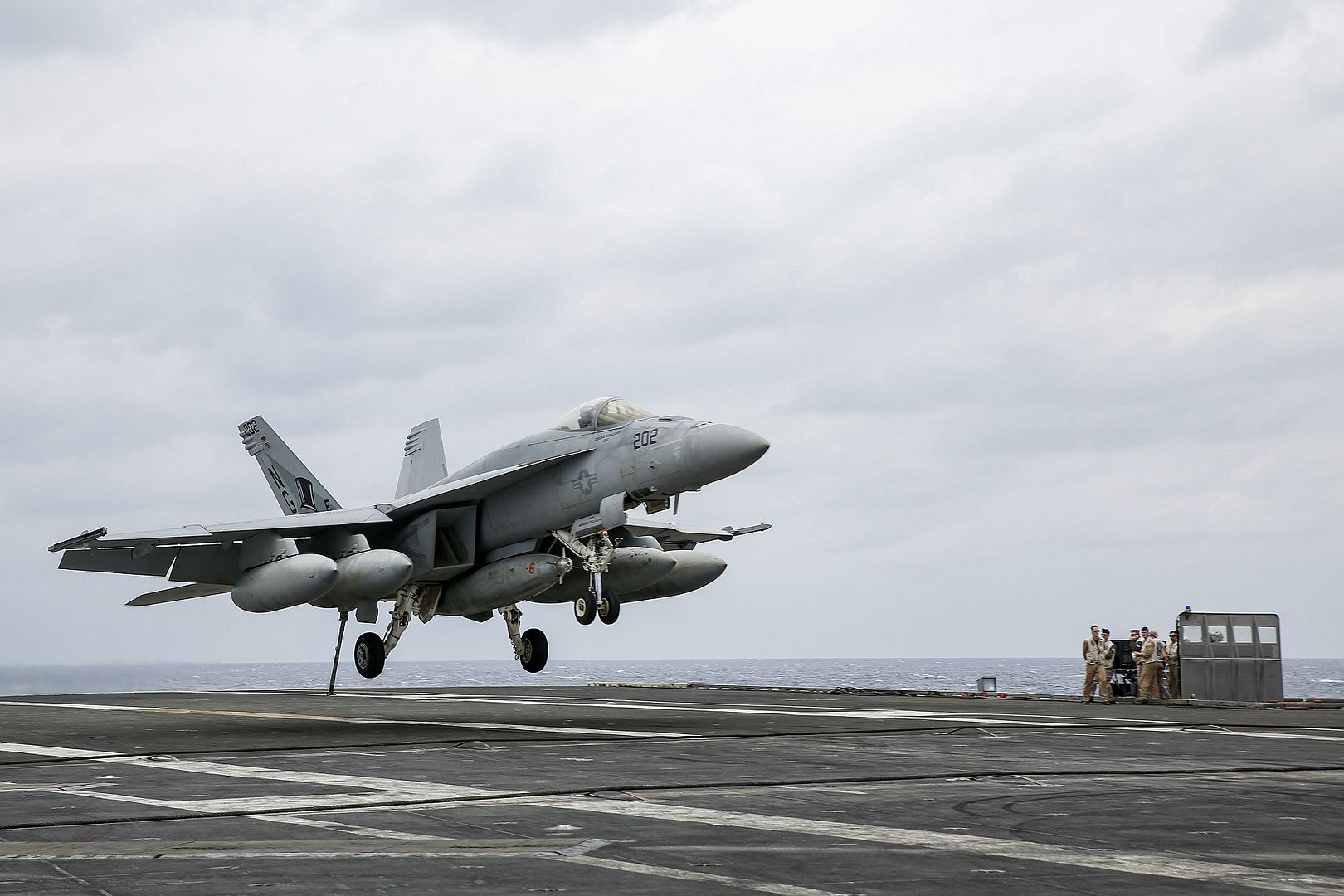
-
 Main AdminA U.S. Air Force KC-135 Stratotanker aircraft assigned to the 100th Air Refueling Wing sits on the flightline prior to take off for pre-flight inspections at Royal Air Force Mildenhall, England, Feb. 25, 2022. The 100th ARW is the only permanent U.S. air refueling wing in the European theater that provides critical air refueling support that allows the Expeditionary Air Force to deploy around the globe on a moment’s notice. (U.S. Air Force photo by Airman Alvaro Villagomez)
Main AdminA U.S. Air Force KC-135 Stratotanker aircraft assigned to the 100th Air Refueling Wing sits on the flightline prior to take off for pre-flight inspections at Royal Air Force Mildenhall, England, Feb. 25, 2022. The 100th ARW is the only permanent U.S. air refueling wing in the European theater that provides critical air refueling support that allows the Expeditionary Air Force to deploy around the globe on a moment’s notice. (U.S. Air Force photo by Airman Alvaro Villagomez)
Polish Mi-24 Hind helicopters circle the field, providing practice for U.S. and Polish air defense units during Exercise Saber Strike 22 at BPTA, Poland on February 24, 2022. This week 5-4 ADA Battalion is building capacity and interoperability with its Polish air defense counterparts by sharing data between Allied radars and weapons platforms while tracking live targets in the field. The exercise runs through March with approximately 13,000 participants from 13 countries. Saber Strike has been held every 2 years since 2010. U.S. Army photo by Maj. Robert Fellingham)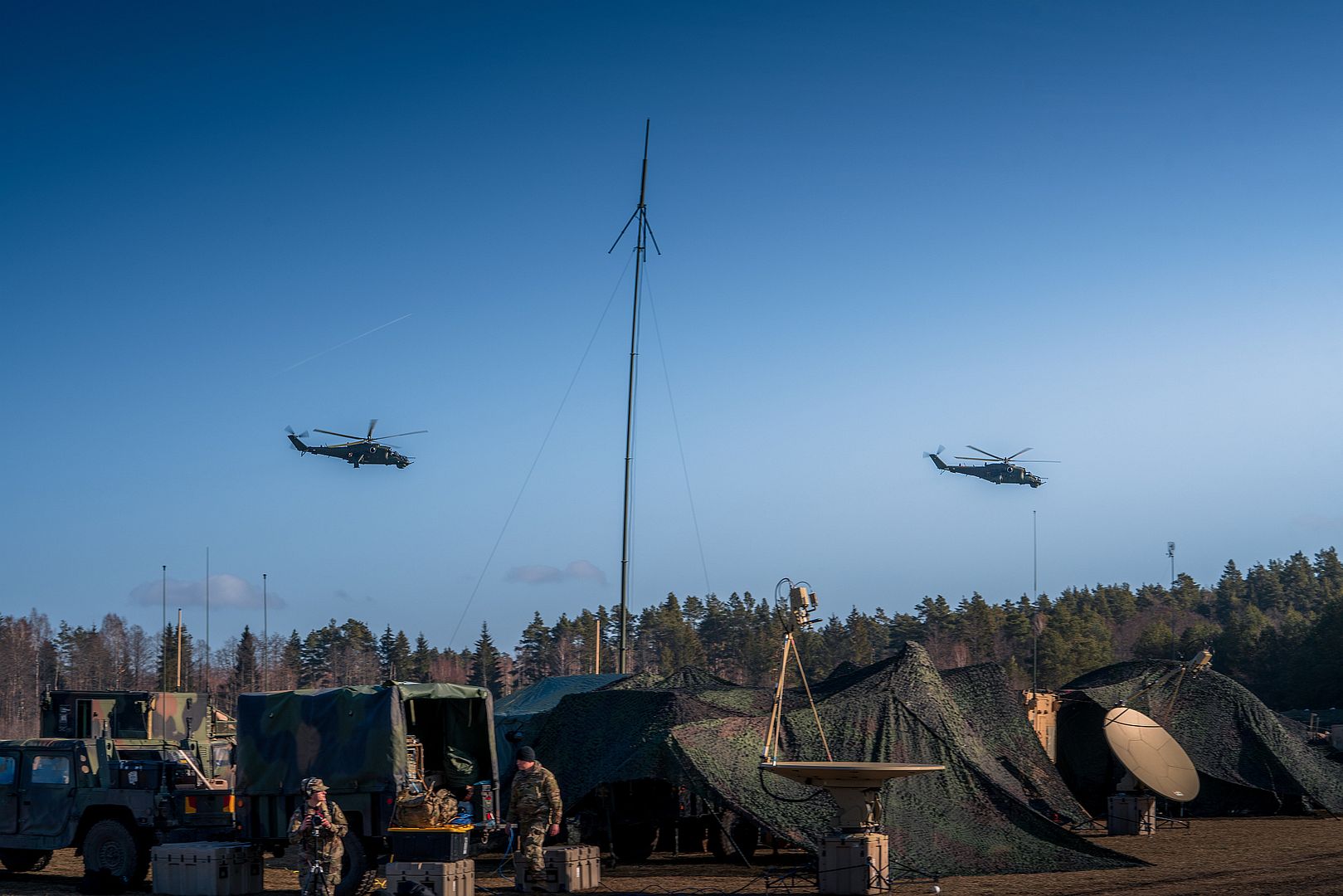
ADRIATIC SEA (Feb. 24, 2022) An E-2D Hawkeye, attached to the "Seahawks" of Airborne Command and Control Squadron (VAW) 126, launches from the flight deck of the Nimitz-class aircraft carrier USS Harry S. Truman (CVN 75), Feb. 24, 2022. The Harry S. Truman Carrier Strike Group is on a scheduled deployment in the U.S. Sixth Fleet area of operations in support of U.S., allied and partner interests in Europe and Africa. (U.S. Navy photo by Mass Communication Specialist 2nd Class Kelsey Trinh)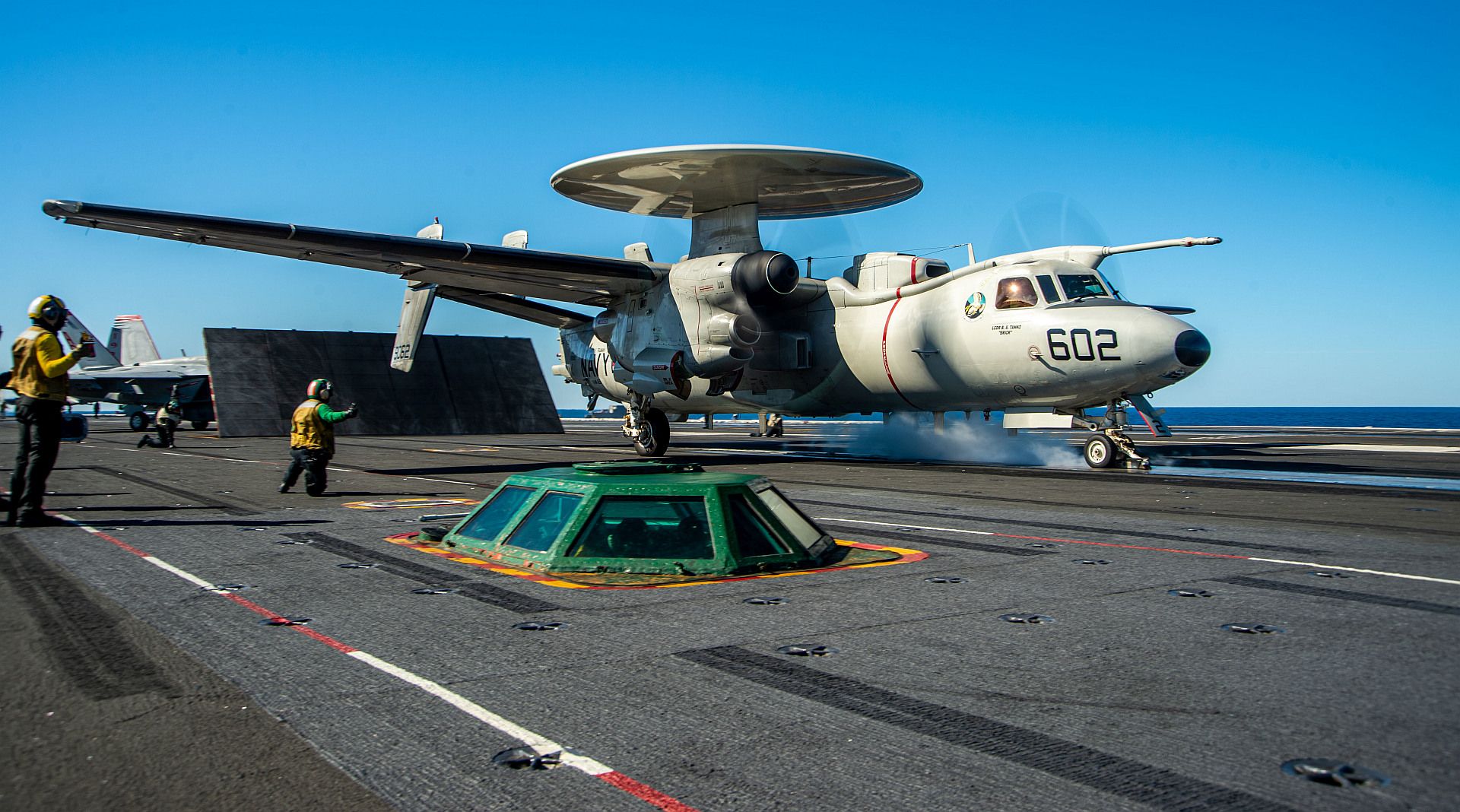
ADRIATIC SEA (Feb. 24, 2022) An F/A-18E Super Hornet, attached to the “Blue Blasters” of Strike Fighter Squadron (VFA) 34, lands on the flight deck of the Nimitz-class aircraft carrier USS Harry S. Truman (CVN 75), Feb. 24, 2022. The Harry S. Truman Carrier Strike Group is on a scheduled deployment in the U.S. Sixth Fleet area of operations in support of U.S., allied and partner interests in Europe and Africa. (U.S. Navy photo by Mass Communication Specialist 2nd Class Kelsey Trinh).jpg?width=1920&height=1080&fit=bounds)
IONIAN SEA (Feb. 25, 2022) An F/A-18E Super Hornet, attached to the “Fighting Checkmates” of Strike Fighter Squadron (VFA) 211, launches from the flight deck of the Nimitz-class aircraft carrier USS Harry S. Truman (CVN 75), Feb. 25, 2022. The Harry S. Truman Carrier Strike Group is on a scheduled deployment in the U.S. Sixth Fleet area of operations in support of U.S., allied and partner interests in Europe and Africa. (U.S. Navy photo by Mass Communication Specialist Seaman Hunter Day).jpg?width=1920&height=1080&fit=bounds)
PHILIPPINE SEA (Feb. 24, 2022) An F/A-18E Super Hornet, assigned to the "Tophatters" of Strike Fighter Squadron (VFA) 14, makes an arrested landing on the flight deck of the Nimitz-class aircraft carrier USS Abraham Lincoln (CVN 72). Abraham Lincoln Strike Group is on a scheduled deployment in the U.S. 7th Fleet area of operations to enhance interoperability through alliances and partnerships while serving as a ready-response force in support of a free and open Indo-Pacific region. (U.S. Navy photo by Mass Communication Specialist 3rd Class Javier Reyes)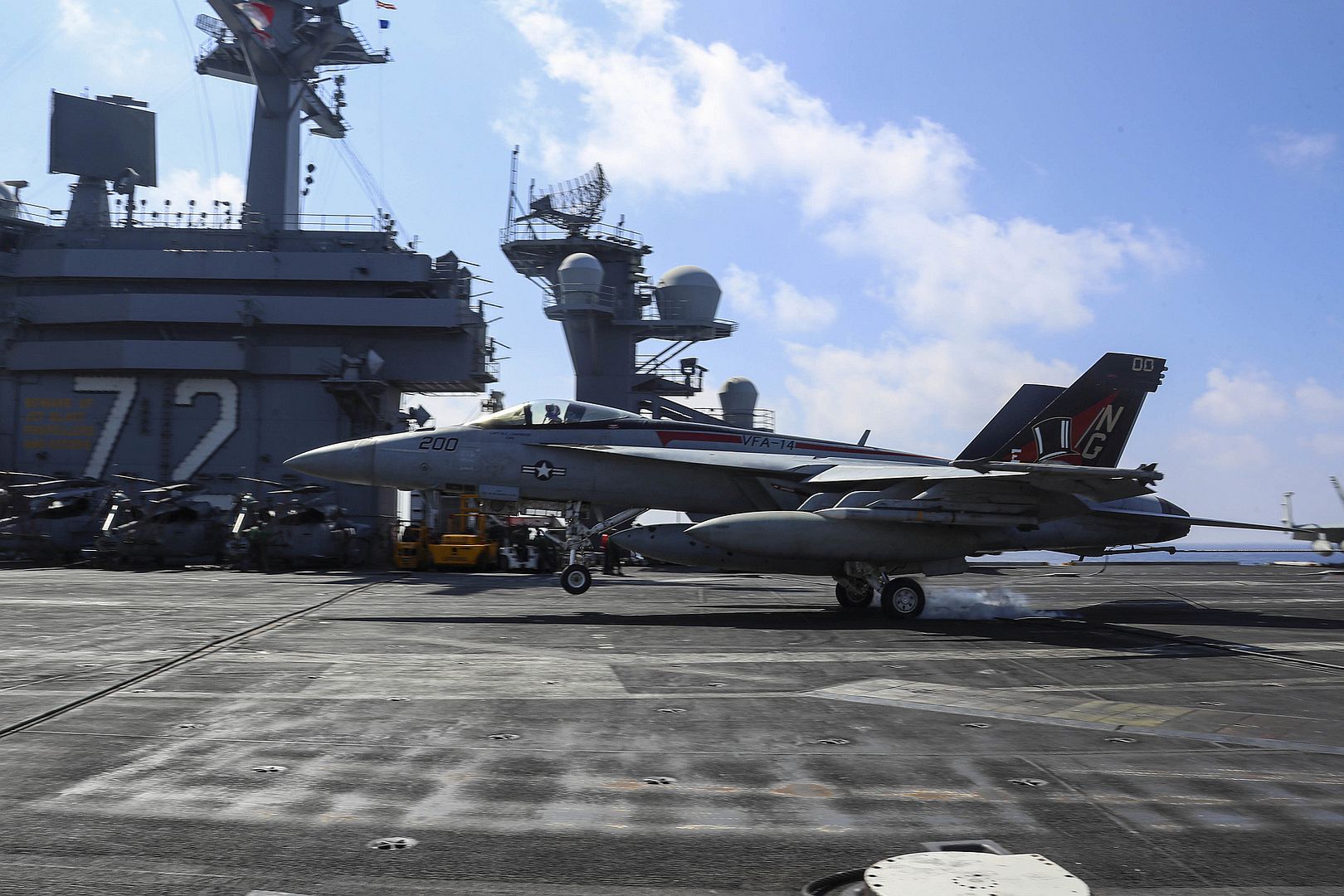
SAN DIEGO – 25 February 2022 – As part of the company’s commitment to develop advanced unmanned autonomy, General Atomics Aeronautical Systems, Inc. (GA-ASI) used a company-owned Avenger® Unmanned Aircraft System and five hardware-in-the-loop synthetic Avengers to autonomously search and follow an artificially-generated adversary. The live-virtual swarm utilized a simulated Infrared Search and Track (IRST) sensor network in addition to the government-furnished CODE autonomy engine to accomplish the mission.
In the two-hour flight on January 28, 2022, the Avenger flew over the high desert of southern California. The live Avenger was commanded into a search mission with the five simulated Avengers. Once the simulated adversary entered the designated search area, the team of Avengers would decide, utilizing an AI/ML algorithm, which aircraft would autonomously break from the search-loiter and perform complex behaviors to show closed loop, air-to-air tactics.
“The flight demonstrated GA-ASI’s unique ability to deploy autonomy using a blend of simulated threats, real-world sensors, and live aircraft. GA-ASI’s robust autonomy pipeline provided seamless digital environments, UAV digital twins and machine learning to validate unmanned aircraft closing complex kill chains. This framework allows the DoD to rapidly transition next-generation, operationally relevant air-to-air warfare technology from the lab to the battlespace,” said GA-ASI Senior Director of Advanced Programs Michael Atwood.
The Avenger UAS integrated a ZPX-R ADS-B and Mode 5 Level 2 receiver provided by uAvionix. The low size, weight, and power (SWAP) sensor allowed the platform to track active aircraft within the local airspace. In addition to the live ADS-B/Mode 5 L2 sensor tracks being downlinked, the Advanced Framework for Simulation, Integration, and Modeling (AFSIM) software simulated two separate types of IRST sensors (situational and long-range). This allowed the multi-physics sensor network to downlink into the Common Operating Picture (COP) running on a government standard Human-Machine Interface. To complement the live-flying sensor suite, the Avenger also operated with All-Source Track and Identity Fuser (ATIF), a government-owned Multi-Physics Fusion engine.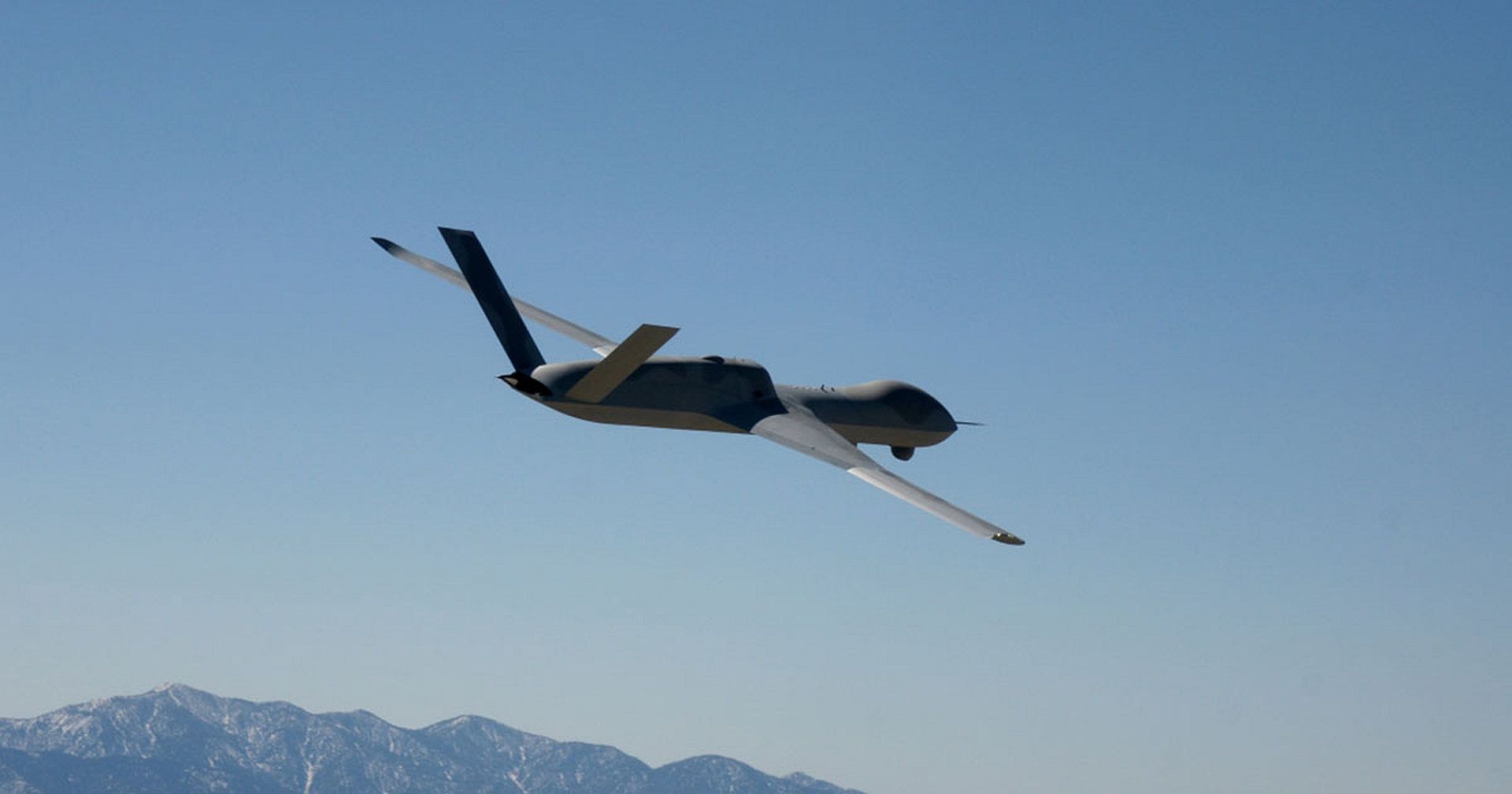
The RAF were invited to support Estonia’s 104th Independence Day celebrations in recognition of the UK’s close relationship with Joint Expeditionary Force (JEF) partner nations.
Typhoons from Royal Air Force Coningsby took part in a flyover of Freedom Square in Tallinn which saw a static parade hosted by President Alar Karis and led by Lieutenant General Martin .
(Photo courtesy of the RAF)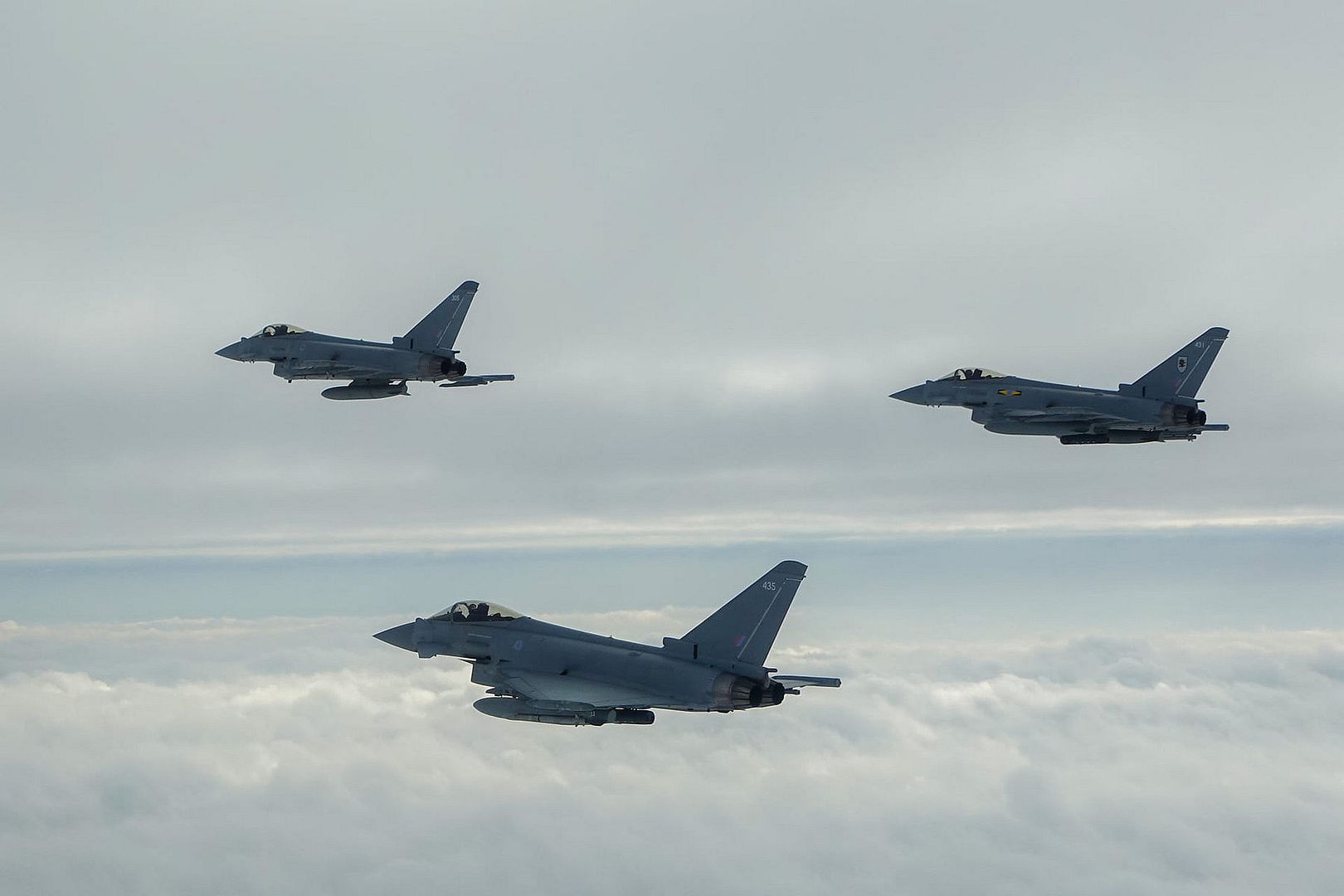
02,24,22.
F-35s and F-16s of the Dutch Royal Air Force will be deployed today to protect the NATO airspace above Eastern Europe. This is the first time that the Defense has officially launched the F-35. The fighters are being refueled in the air by an MRTT .
The Netherlands expresses its allied solidarity .
(Photo courtesy of the Koninklijke Luchtmacht).jpg?width=1920&height=1080&fit=bounds)
-
 Main AdminA U.S. Air Force Boeing KC-135 Stratotanker provides fuel to an F15E Strike Eagle in Eastern European airspace, Feb. 26, 2022. The 100th Aerial Refueling Wing assigned to Royal Air Force Mildenhall is currently operating missions out of Ramstein Air Base, Germany, providing 24-hour support to NATO allies and partners. (U.S. Air Force Airman 1st Class Edgar Grimaldo)
Main AdminA U.S. Air Force Boeing KC-135 Stratotanker provides fuel to an F15E Strike Eagle in Eastern European airspace, Feb. 26, 2022. The 100th Aerial Refueling Wing assigned to Royal Air Force Mildenhall is currently operating missions out of Ramstein Air Base, Germany, providing 24-hour support to NATO allies and partners. (U.S. Air Force Airman 1st Class Edgar Grimaldo)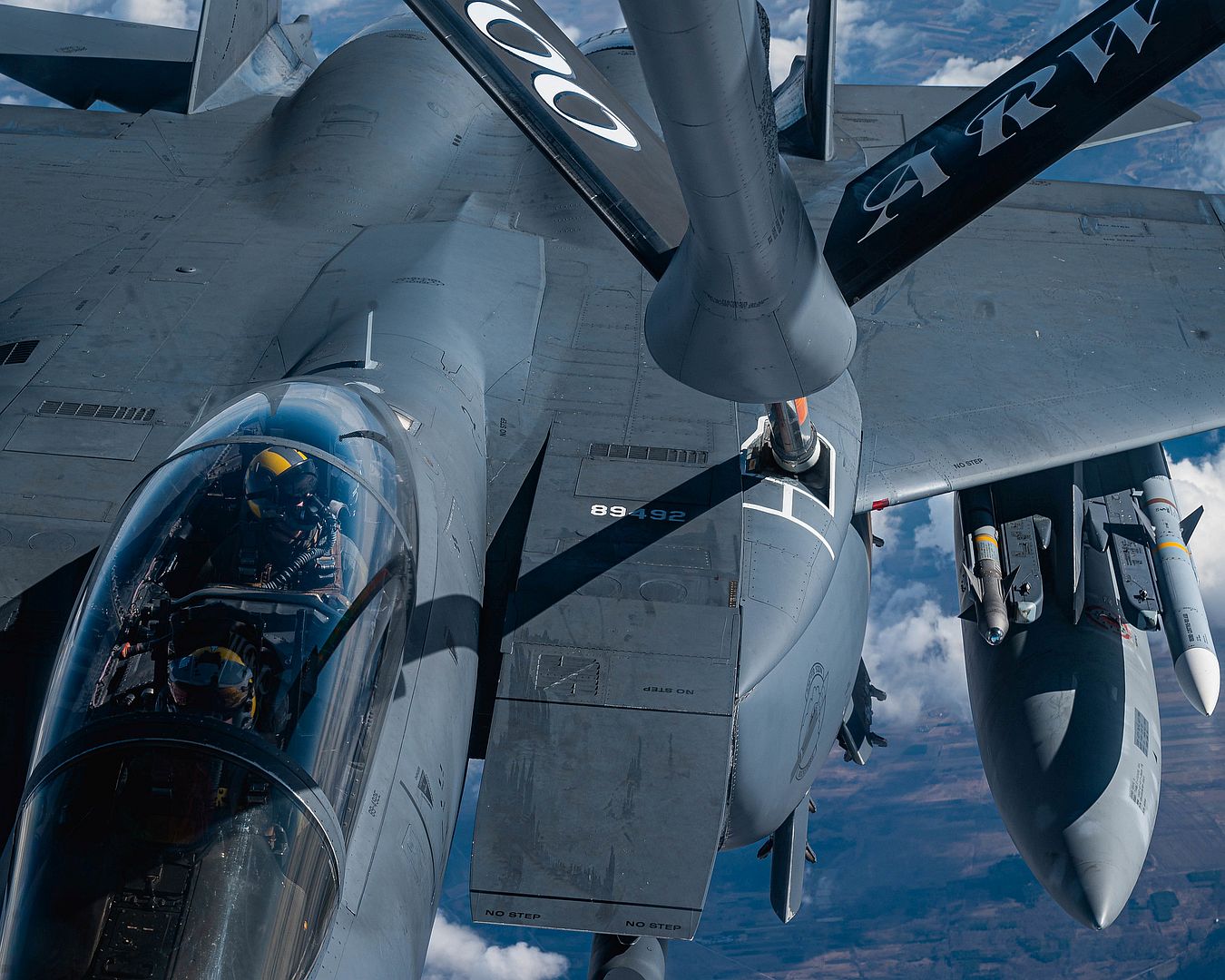
A U.S. Air Force F-15C Eagle from the 493rd Fighter Squadron assigned to Royal Air Force Lakenheath, England tests an air break deployment in preparation to depart Poland after completing a NATO enhanced Air Policing mission at Łask Air Basel Poland, Feb. 28, 2022. The 493rd FS executed NATO EAP for several weeks before being relieved by the 336th Fighter Squadron assigned to Seymour Johnson Air Force Base, North Carolina. (U.S. Air Force photo by Tech. Sgt. Jacob Albers)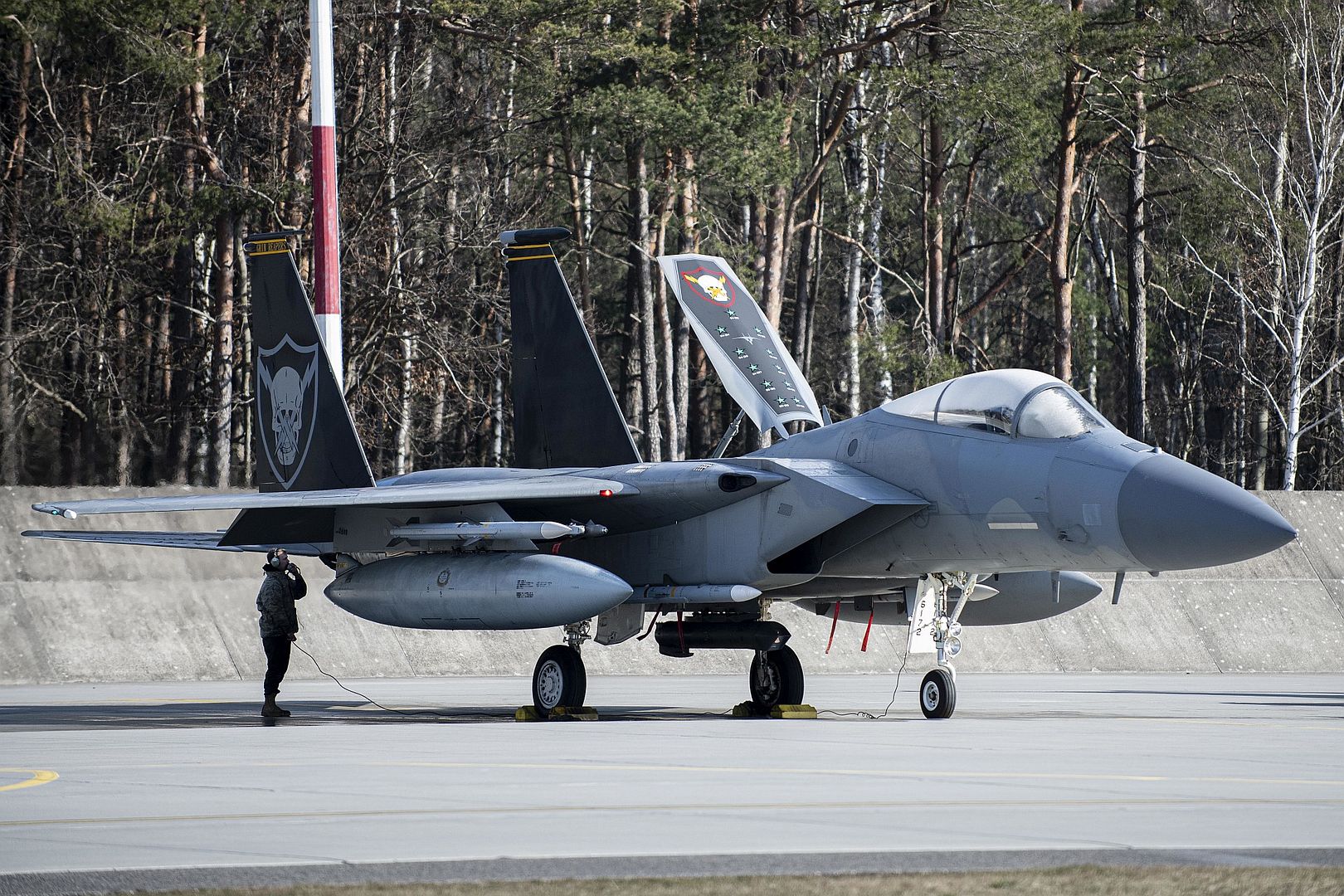
A U.S. Air Force F-15C Eagle from the 493rd Fighter Squadron assigned to Royal Air Force Lakenheath, England, takes off after completing a NATO enhanced Air Policing mission at Łask Air Base, Poland, Feb. 28, 2022. The 493rd FS executed NATO EAP for several weeks before being relieved by the 336th Fighter Squadron assigned to Seymour Johnson Air Force Base, North Carolina. (U.S. Air Force photo by Tech. Sgt. Jacob Albers)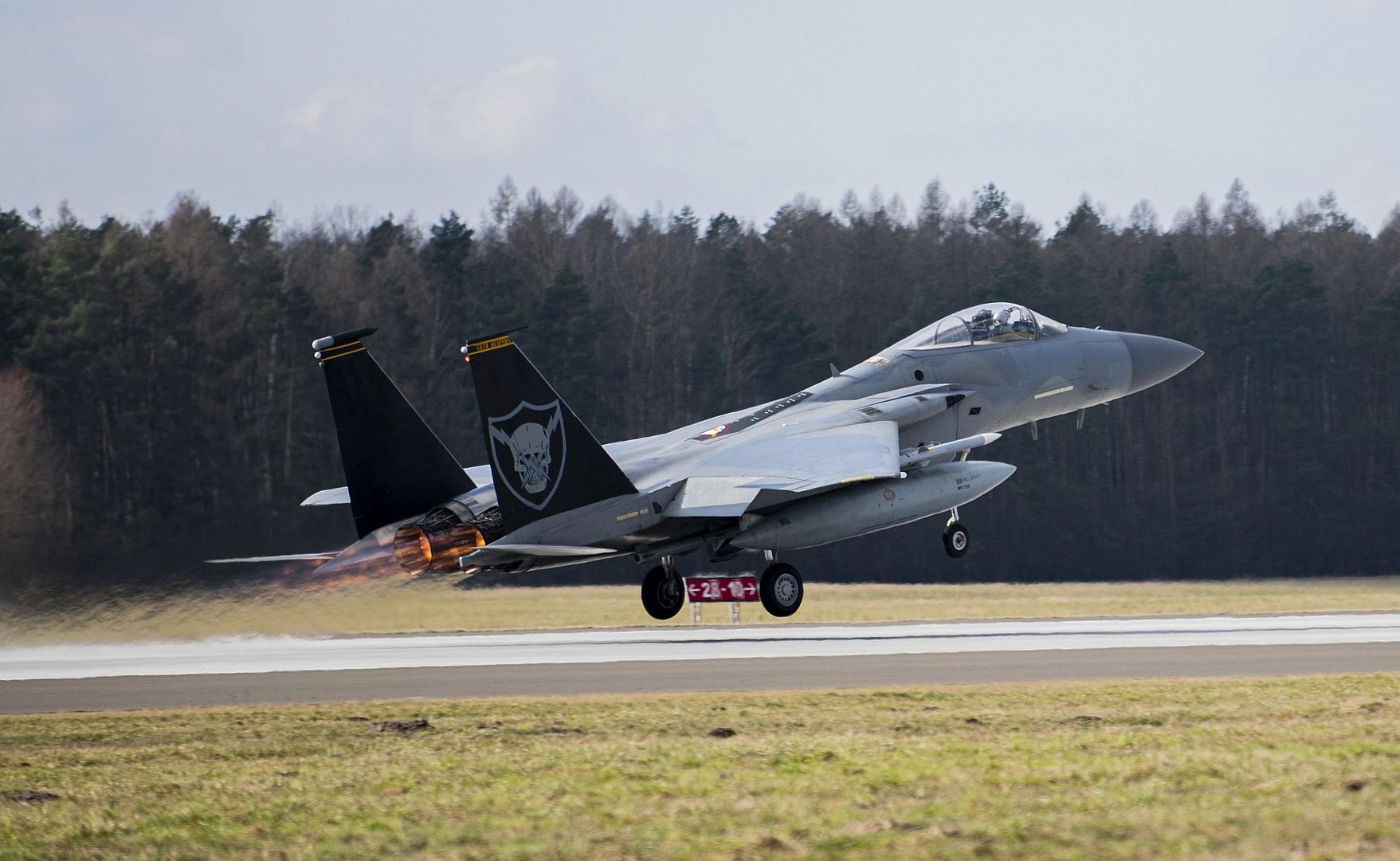
PHILIPPINE SEA (Feb. 28, 2022) An F/A-18E Super Hornet, assigned to the “Vigilantes” of Strike Fighter Squadron (VFA) 151, launches from the flight deck of the Nimitz-class aircraft carrier USS Abraham Lincoln (CVN 72). Abraham Lincoln Strike Group is on a scheduled deployment in the U.S. 7th Fleet area of operations to enhance interoperability through alliances and partnerships while serving as a ready-response force in support of a free and open Indo-Pacific region. (U.S. Navy photo by Mass Communication Specialist 3rd Class Michael Singley)
Rome, 28th February 2022 - The Aeronautical Armaments and Airworthiness Directorate (DAAA) recently approved a contract for the technical-logistical support of the Italian Air Force’s C-130J Super Hercules airlifter fleet. The agreement, which lasts five years and is worth a total of 380 million euros, was signed on Jan. 28, 2022, between the Italian Air Force and the Temporary Business Grouping (RTI) formed by Leonardo, Avio Aero and Lockheed Martin Aeronautics.
Contract activities, as defined by the Logistic Command’s 2nd Division, include the implementation of a technical-logistical model that provides integrated logistical support (ILS), "in house" engineering support and "on-site" support through operational technical representatives at the 46th Air Brigade in Pisa. Aircraft maintenance activities, planned and managed by at the Air Force Logistic Command’s 11th Maintenance Depot in Sigonella, are also envisaged at Leonardo plant in Tessera near Venice and Avio Aero plant in Brindisi as complementary support to those provided on the Pisa base, as well as repairs, spare parts, material logistics, inspection activities, software, and technical publications maintenance and updates.
Dario Marfè, SVP Marketing, Sales, Customer Support & Services at Leonardo's Aircraft Division said: "The finalization of this important agreement confirms the validity of our Customer Support model which, thanks to a state-of-the-art national and global support structure, allows us to provide our customers with dedicated technical-logistical support services, guaranteeing operational continuity to the fleets and, for operators, the readiness to carry out any type of mission, as in the case of the C-130J operated by the Italian Air Force.”
Pierfederico Scarpa, VP Strategy, Marketing and Sales at Avio Aero said: “This contract undoubtedly represents a further consolidation of our historic partnership with the Italian Air Force. The C-130J fleet is indeed one of the most strategic of the whole armed force. Furthermore, under this agreement, Avio Aero will provide a “Performance-Based Logistics” service to support the AE 2100D3 engines. This is an innovative and increasingly used model that in this case will allow Avio Aero not only to optimize performance, but also to implement ever more effective and functional solutions in response to the needs of the Italian Air Force.”
Trish Pagan, Vice President of International Programs at Lockheed Martin’s Air Mobility & Maritime Missions line of business said: “Aeronautica Militare C-130J crews continually exemplify the C-130J’s unmatched and proven airlift and refueling capabilities. This partnership allows Lockheed Martin to pair our Original Equipment Manufacturer insights with our trusted partners at Leonardo and Avio Aero to ensure Italy’s C-130J Super Hercules fleet is ready to support any mission — any time, anywhere.”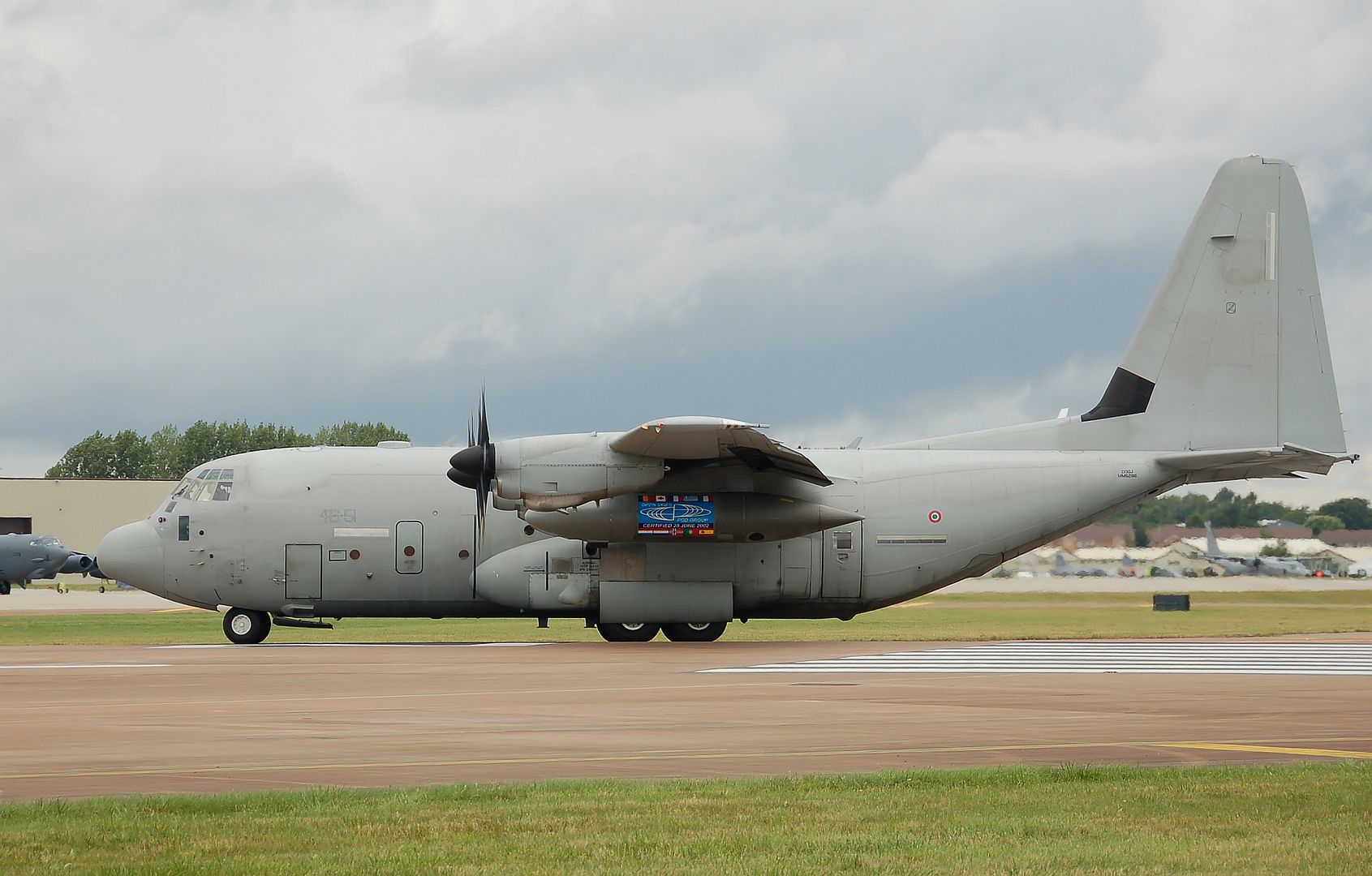
Royal Air Force Typhoons have taken to the skies as part of NATO's mission to defend Europe.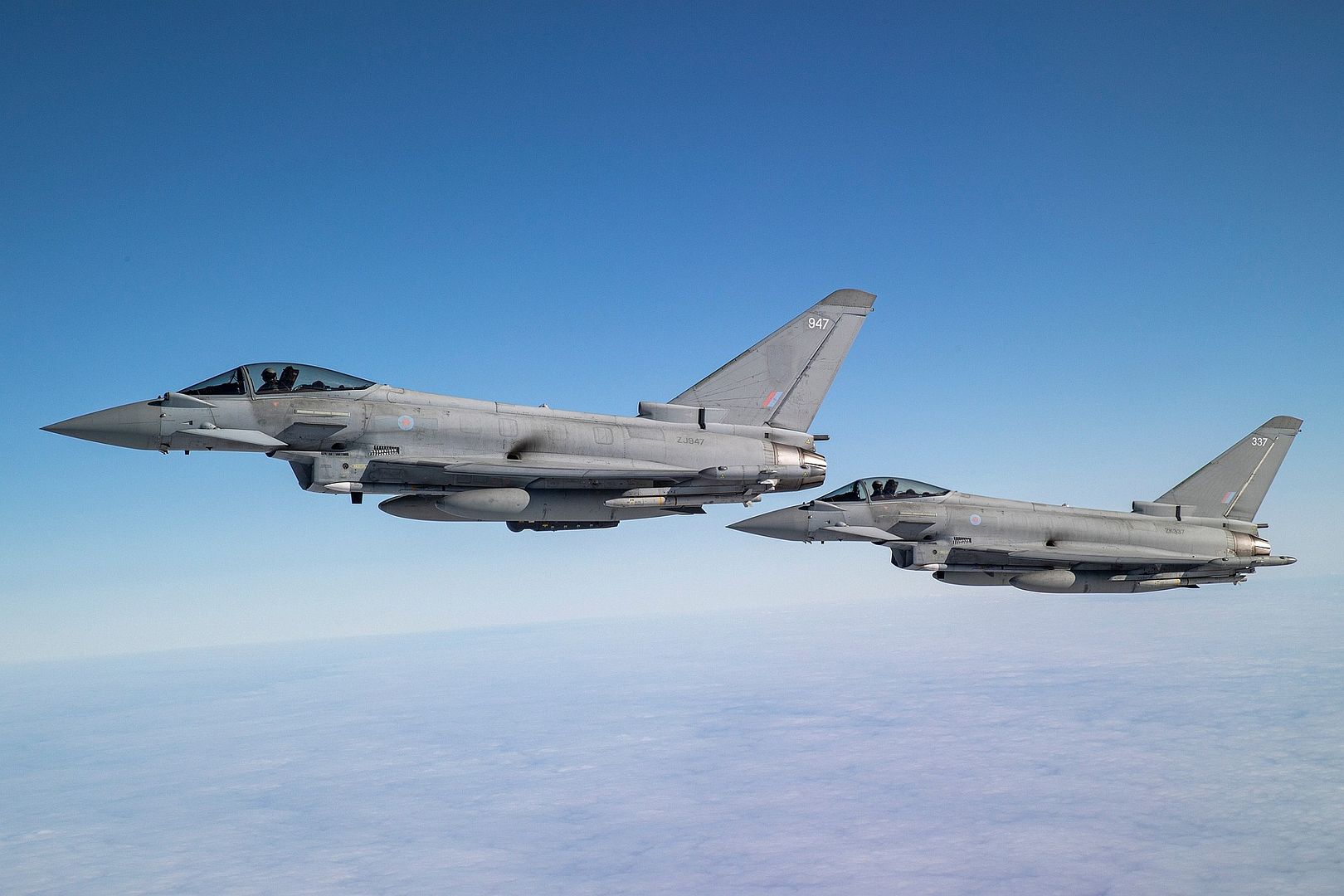
Supported by RAF Voyager aircraft, this is part of pre-planned Enhanced Vigilance Activity, a NATO-led Operation initiated due to the unfolding events in Ukraine.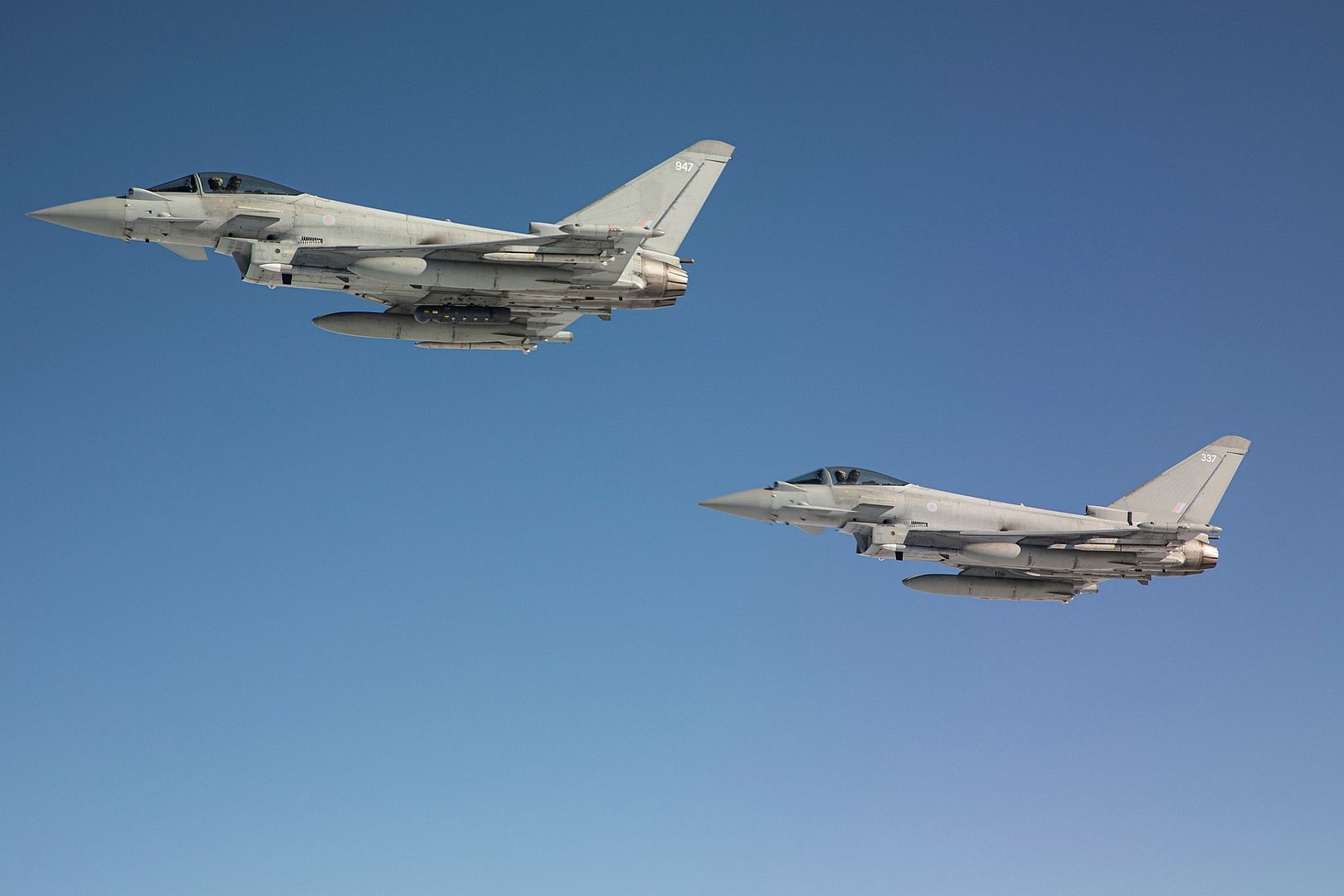
The RAF are providing air support ready to defend the region and are part of a robust response to Russian aggression, contributing to the security of Europe.
The RAF’s contribution is in the form of additional Typhoon FGR4 aircraft, operating from RAF Coningsby in Lincolnshire and RAF Akrotiri in Cyprus. The Typhoons, armed with state-of-the-art Air-to-Air missiles and a full suite of defensive aids, are patrolling NATO airspace over Poland and Romania, once more demonstrating the UK’s unwavering commitment to the NATO Alliance.
(Photos courtesy of the RAF)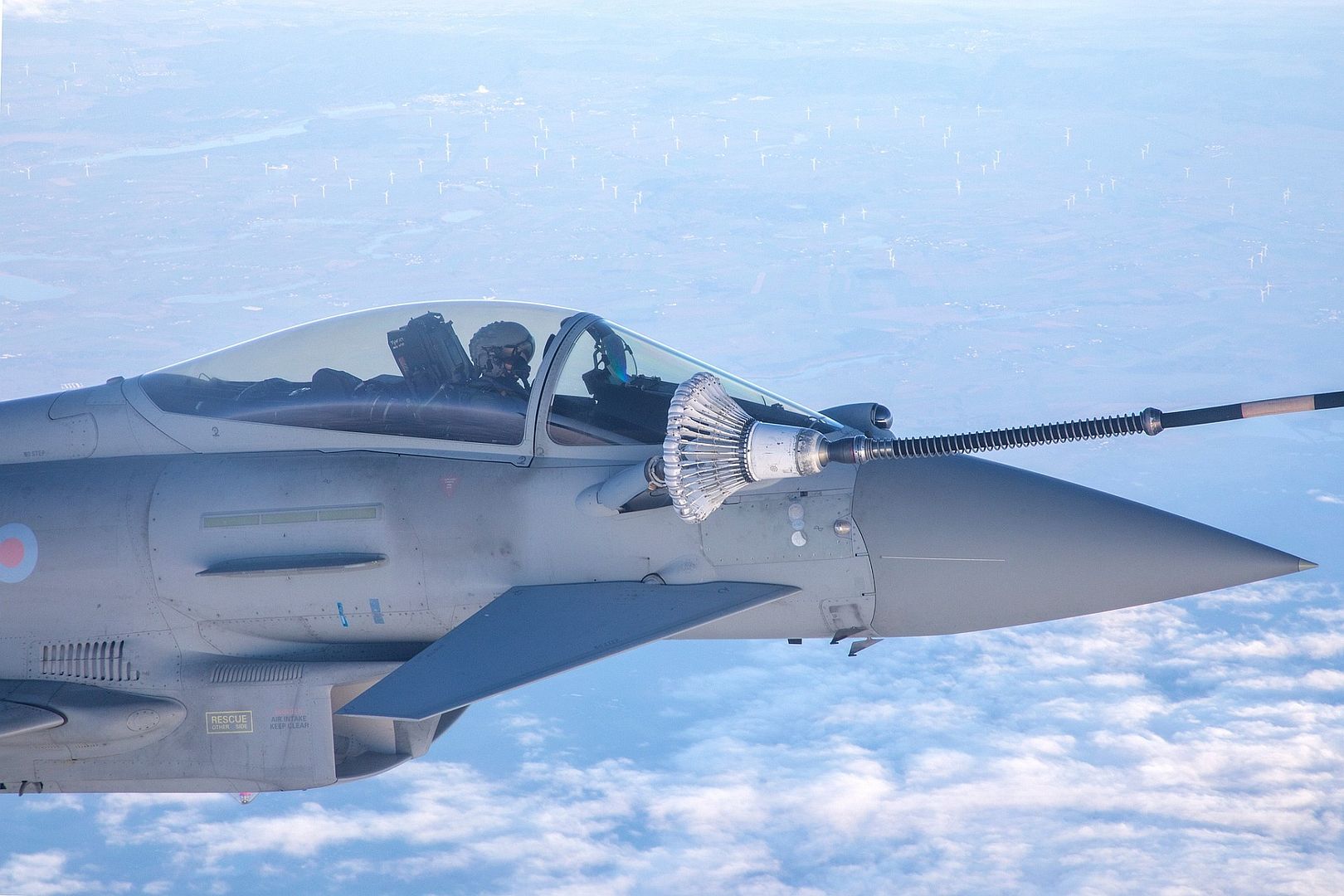
-
 Main AdminU.S. Marines with Marine Fighter Attack Squadron 312, 2nd Marine Aircraft Wing, conduct a post-flight inspection at Air Force Base Bodø, Norway, Feb. 28, 2022. Exercise Cold Response '22 is a biennial Norwegian national readiness and defense exercise that takes place across Norway, with participation from each of its military services, as well as from 26 additional North Atlantic Treaty Organization (NATO) allied nations and regional partners. (U.S. Marine Corps photo by Lance Cpl. Adam Henke)
Main AdminU.S. Marines with Marine Fighter Attack Squadron 312, 2nd Marine Aircraft Wing, conduct a post-flight inspection at Air Force Base Bodø, Norway, Feb. 28, 2022. Exercise Cold Response '22 is a biennial Norwegian national readiness and defense exercise that takes place across Norway, with participation from each of its military services, as well as from 26 additional North Atlantic Treaty Organization (NATO) allied nations and regional partners. (U.S. Marine Corps photo by Lance Cpl. Adam Henke)
A U.S. Air Force F-35 Lightning II aircraft from Royal Air Force Lakenheath rests on the flightline as a U.S. C-17 Globemaster III from Joint Base Charleston, South Carolina, at Ämari Air Base, Estonia, Feb. 28, 2022. The C-17 delivered additional Airmen and cargo from the 48th FW from RAF Lakenheath to support NATO’s collective defense and enhanced Air Policing mission. The F-35 allows NATO leaders the flexibility to project power and assert air dominance in highly contested environments by providing unprecedented communication capabilities, command and control, and lethality. (U.S. Air Force photo by Staff Sgt. Megan M. Beatty)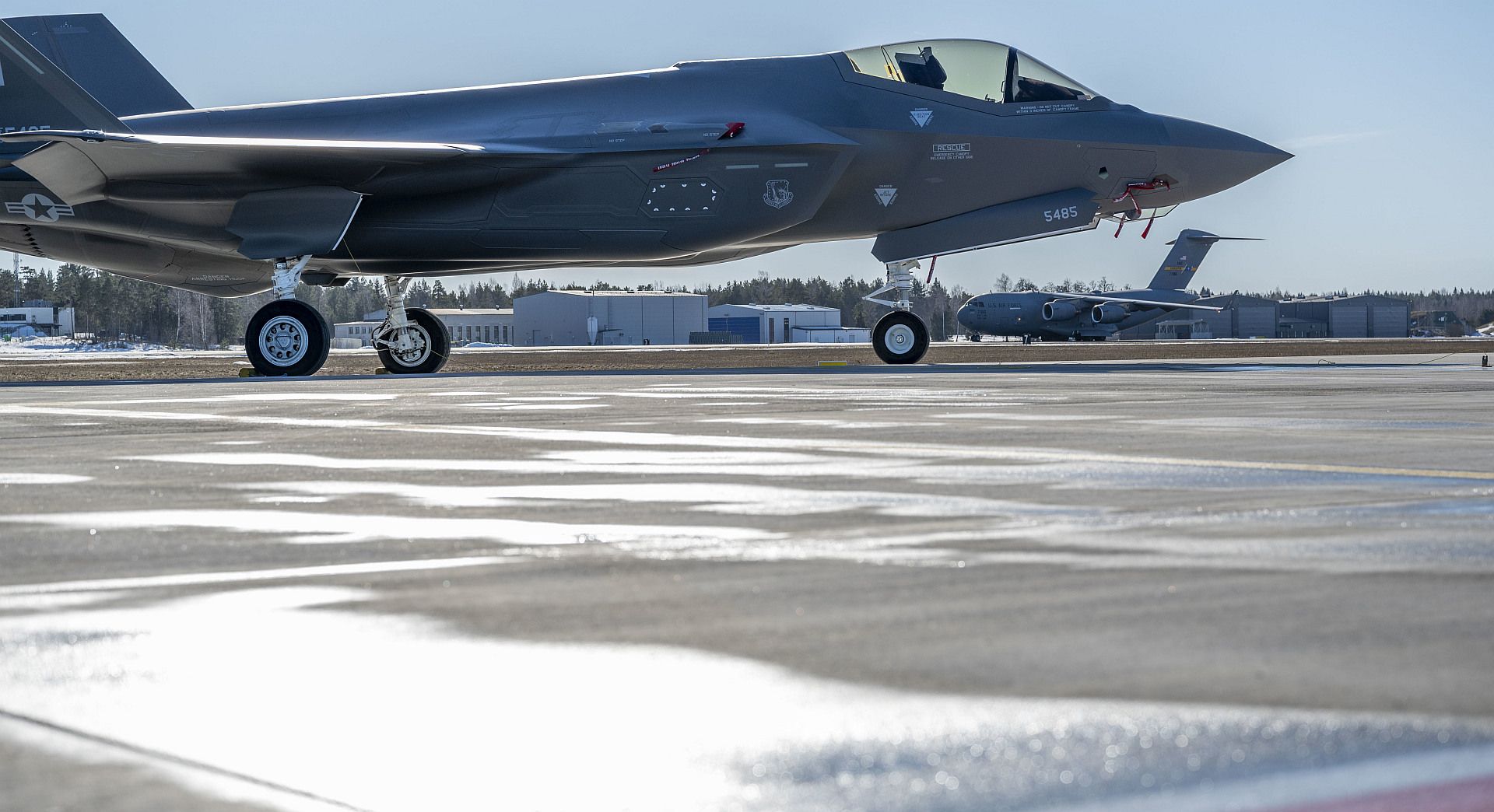
A U.S. Air Force F-16 Fighting Falcon pilot from the 555th Fighter Squadron takes-off at Aviano Air Base, Italy, Feb. 28, 2022. The flight will support NATO’s enhanced air policing mission; integrate with allies and partners in the Black Sea region in an increased defensive posture along NATO’s border and to reinforce regional security. (U.S. Air Force photo by Airman First Class Thomas Calopedis)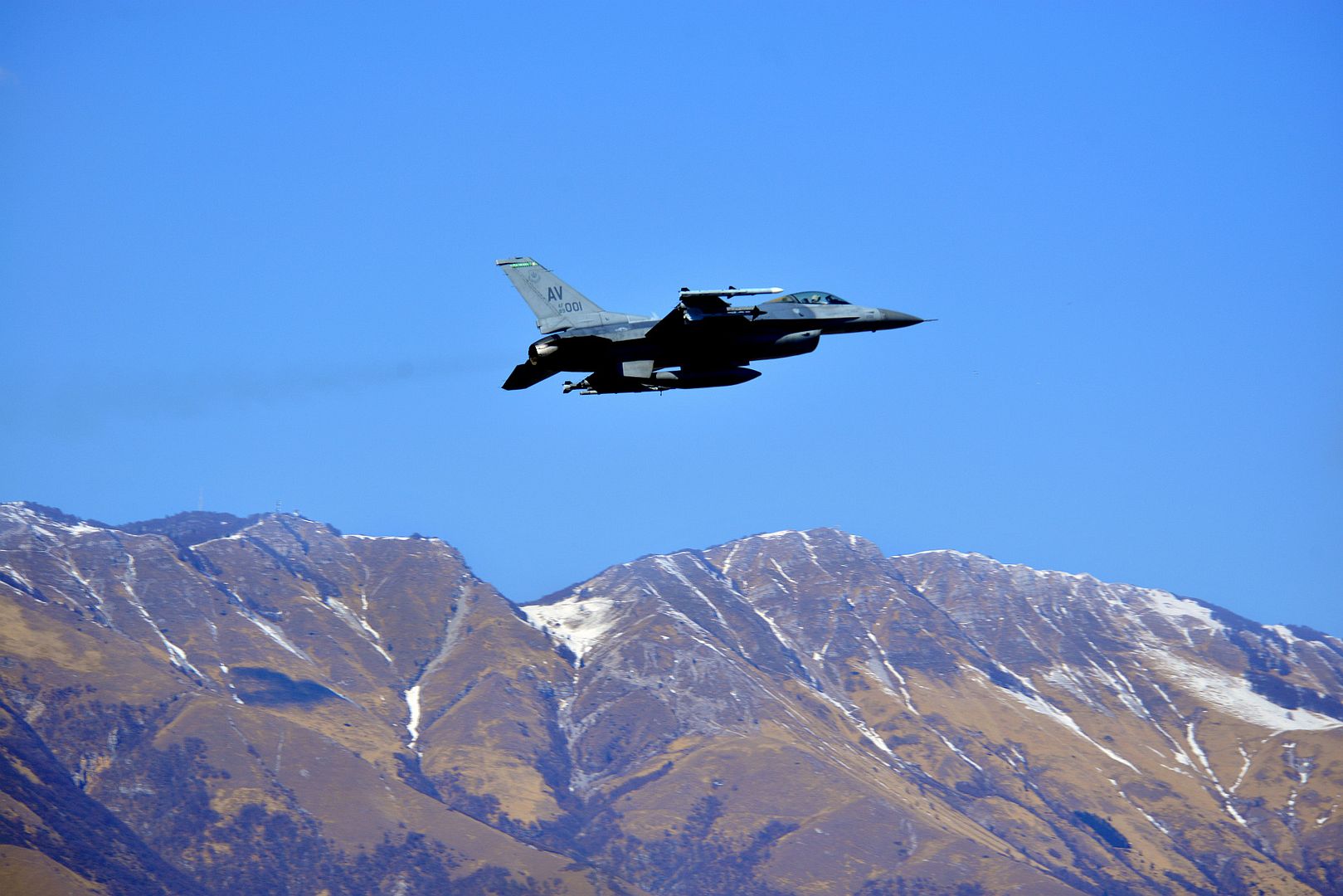
A U.S. Air Force F-15D Eagle assigned to the 493rd Fighter Squadron return to Royal Air Force Lakenheath, England, after conducting NATO Polish Enhanced Air Policing Feb. 28, 2022. Forces continue to conduct engagements and bilateral exercises, enhancing interoperability and improving regional cooperation, maritime security and stability in the region. (U.S. Air Force Photo by Senior Airman Koby I. Saunders)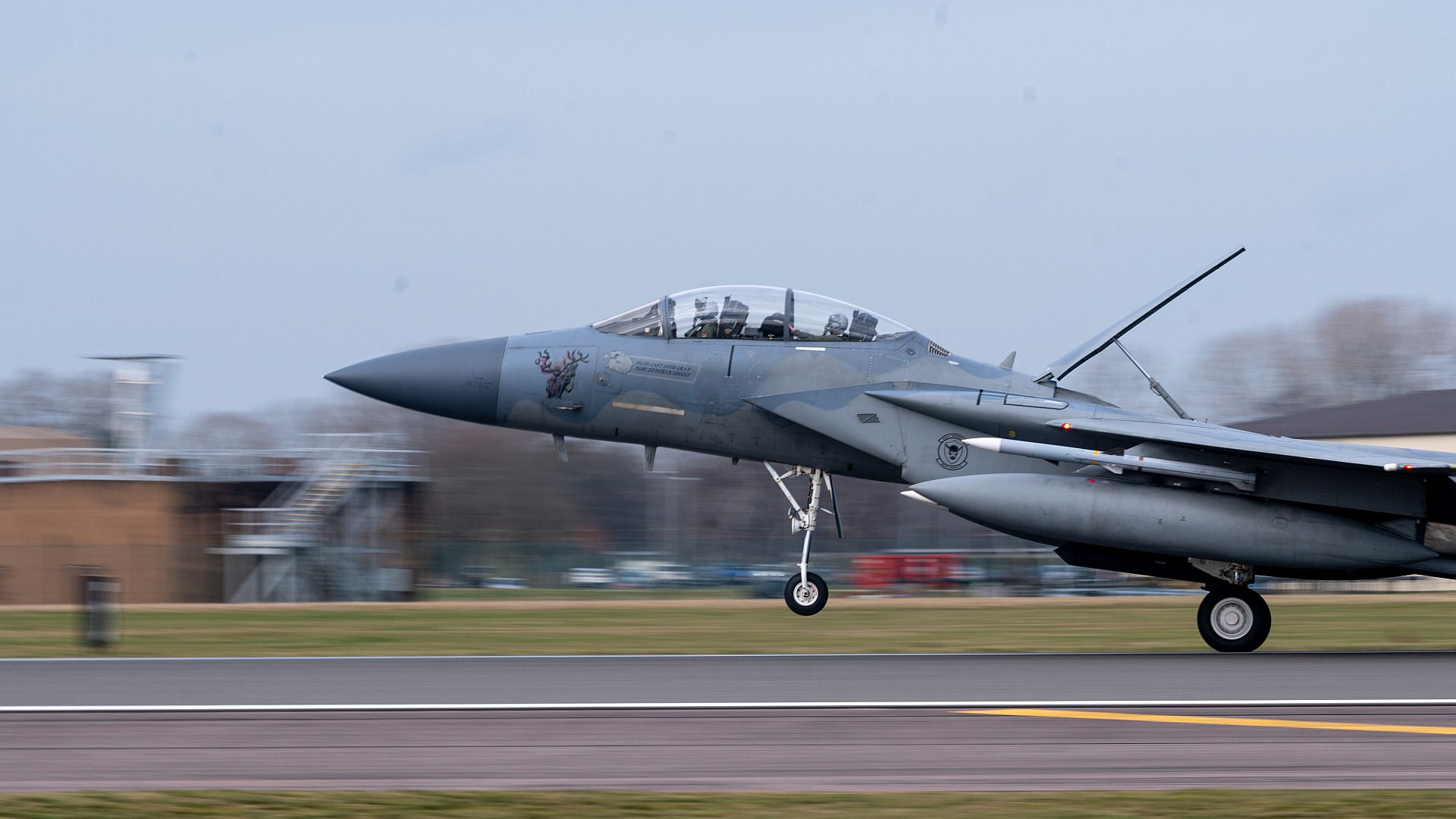
A U.S. Air Force F-15C Eagle assigned to the 493rd Fighter Squadron return to Royal Air Force Lakenheath, England, after conducting NATO Polish Enhanced Air Policing Feb. 28, 2022. Forces continue to conduct engagements and bilateral exercises, enhancing interoperability and improving regional cooperation, maritime security and stability in the region. (U.S. Air Force Photo by Senior Airman Koby I. Saunders)
A U.S. Air Force B-52H Stratofortress, assigned to the 69th Expeditionary Bomb Squadron, RAF Fairford, England, prepares for departure for a Bomber Task Force mission to southeastern Mauritania and along the west coast of Africa, where aircrew and U.S. Coast Guard members aboard the aircraft exercised their ability to conduct counter-illicit maritime tracking efforts, Feb. 28, 2022. U.S. Coast Guard members are trained to identify and track illegally operating vessels, such as those conducting illegal, unregulated and unreported fishing activities, and then transmit the vessel's location to the appropriate law enforcement authority. (U.S. Air Force photos by Tech. Sgt. Corban Lundborg)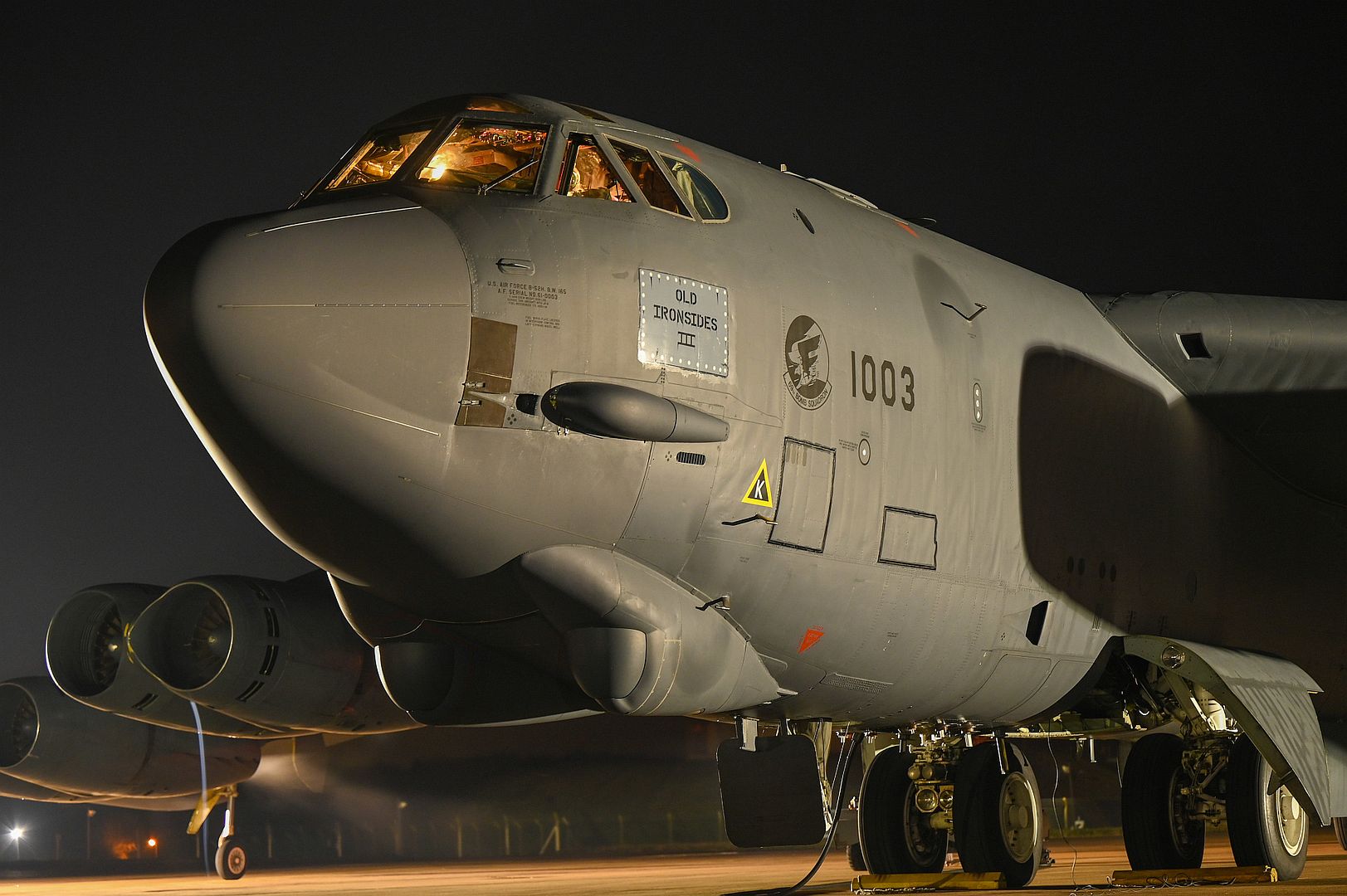
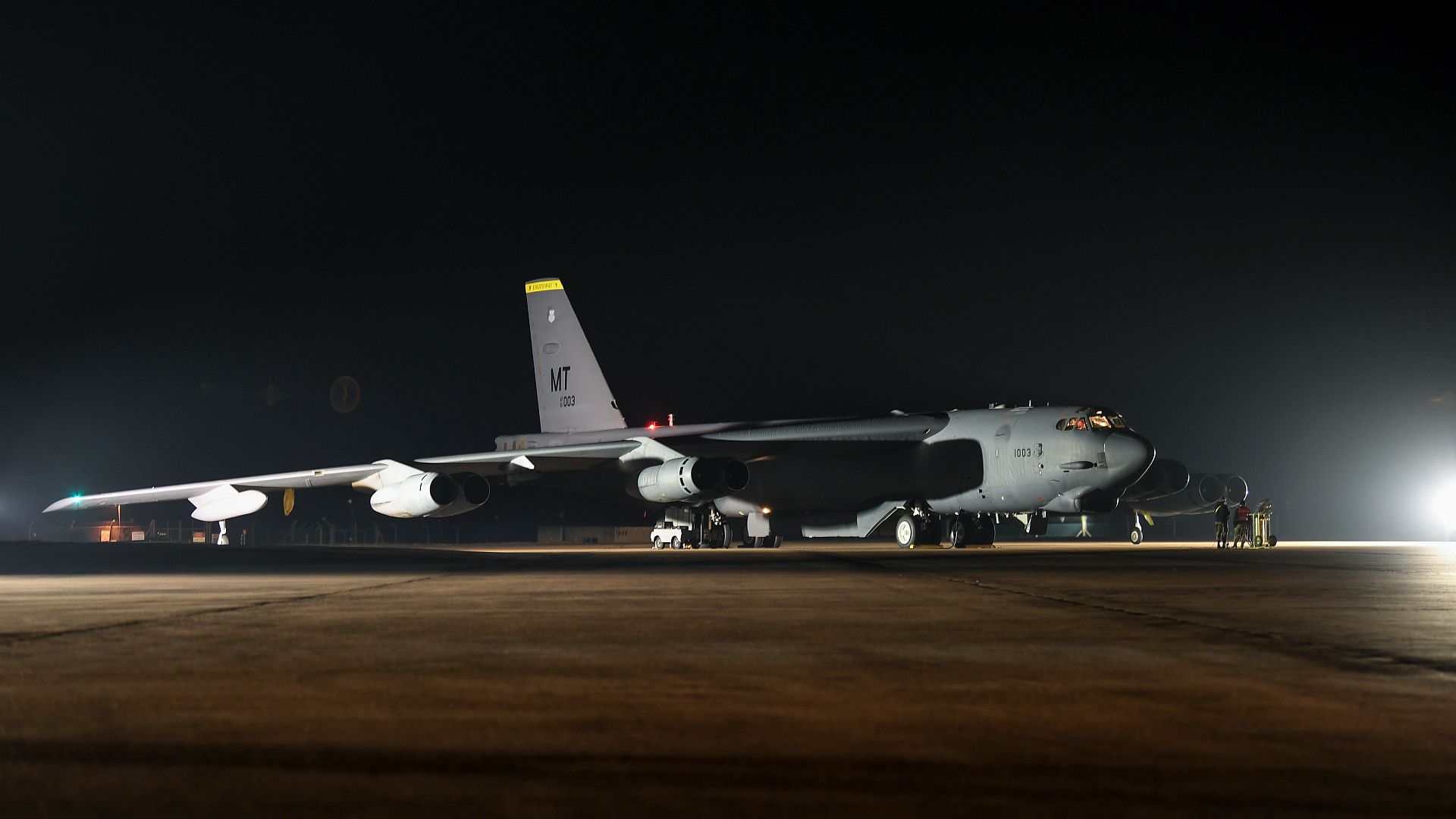
A German Eurofighter conducts a show of force fly by during joint terminal attack controller training with U.S. Airmen assigned to 2nd Air Support Operations Squadron at the 7th Army Training Command's Grafenwoehr Training Area, Germany, Feb. 25, 2022. (U.S. Army photo by Markus Rauchenberger)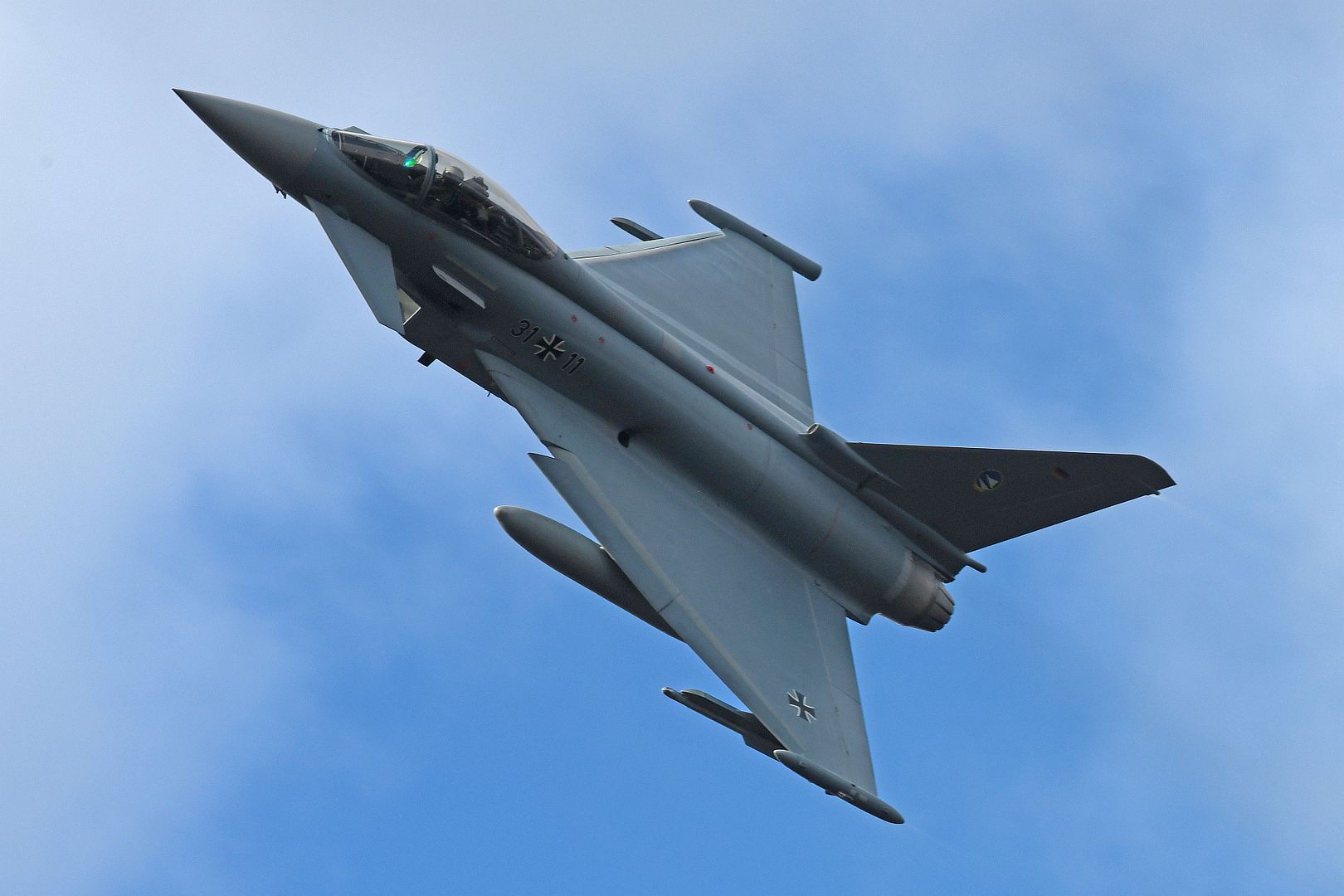
-
 Main AdminU.S. Air Force B-52H Stratofortress’ assigned to the 69th Expeditionary Bomb Squadron, RAF Fairford, England, flew a Bomber Task Force mission to southeastern Mauritania and along the west coast of Africa, where aircrew and U.S. Coast Guard members aboard the aircraft exercised their ability to conduct counter-illicit maritime tracking efforts, Feb. 28, 2022. U.S. Coast Guard members are trained to identify and track illegally operating vessels, such as those conducting illegal, unregulated and unreported fishing activities, and then transmit the vessel's location to the appropriate law enforcement authority. (U.S. Air Force courtesy photos)
Main AdminU.S. Air Force B-52H Stratofortress’ assigned to the 69th Expeditionary Bomb Squadron, RAF Fairford, England, flew a Bomber Task Force mission to southeastern Mauritania and along the west coast of Africa, where aircrew and U.S. Coast Guard members aboard the aircraft exercised their ability to conduct counter-illicit maritime tracking efforts, Feb. 28, 2022. U.S. Coast Guard members are trained to identify and track illegally operating vessels, such as those conducting illegal, unregulated and unreported fishing activities, and then transmit the vessel's location to the appropriate law enforcement authority. (U.S. Air Force courtesy photos)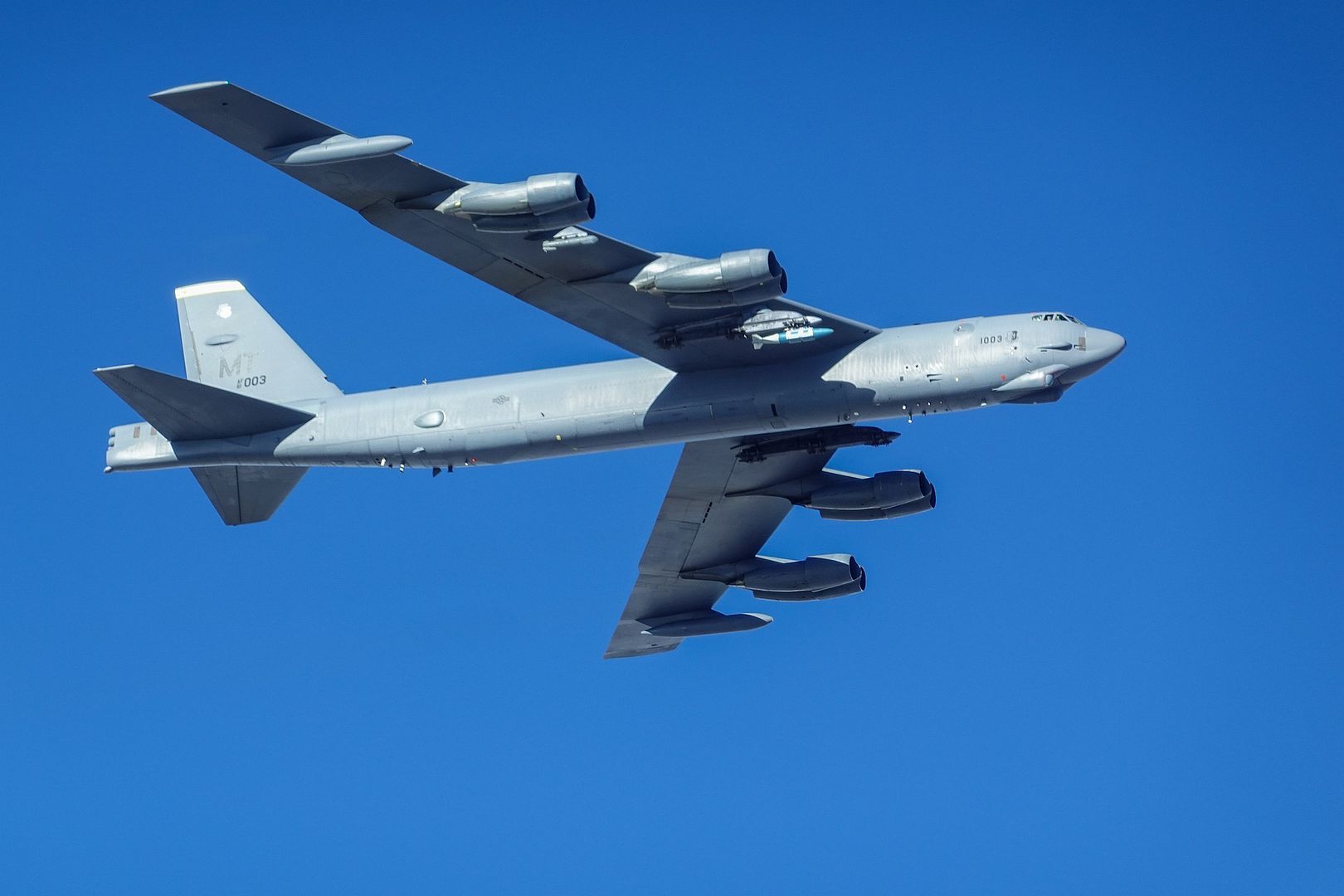
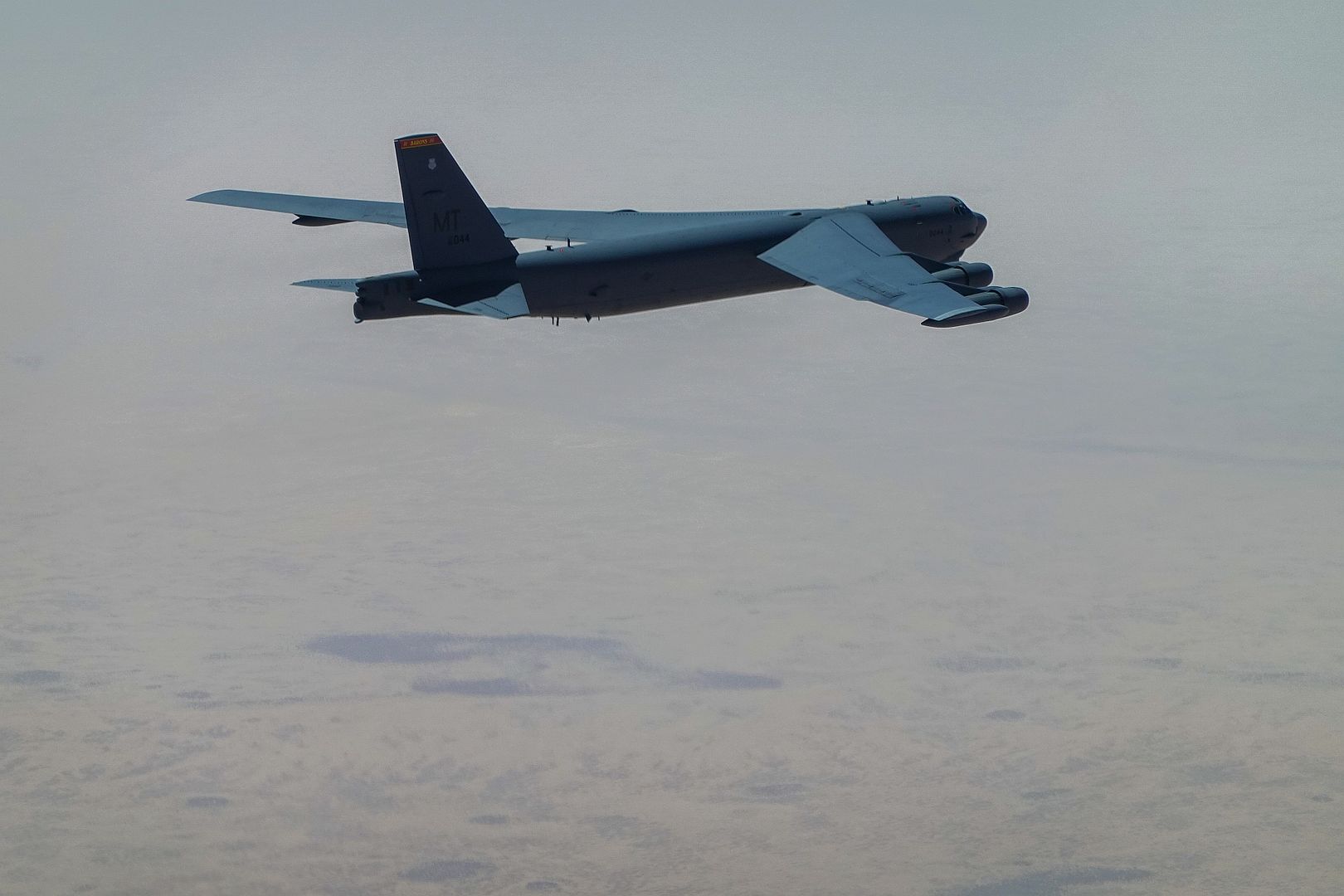
A U.S. Air Force EC-130H Compass Call takes its final flight at Davis-Monthan Air Force Base, Arizona, Feb. 28, 2022. The Compass Call system employs offensive counter-information and electronic attack capabilities in support of U.S. and coalition tactical air, surface and special operations forces. (U.S. Air Force photos by Senior Airman Alex Miller)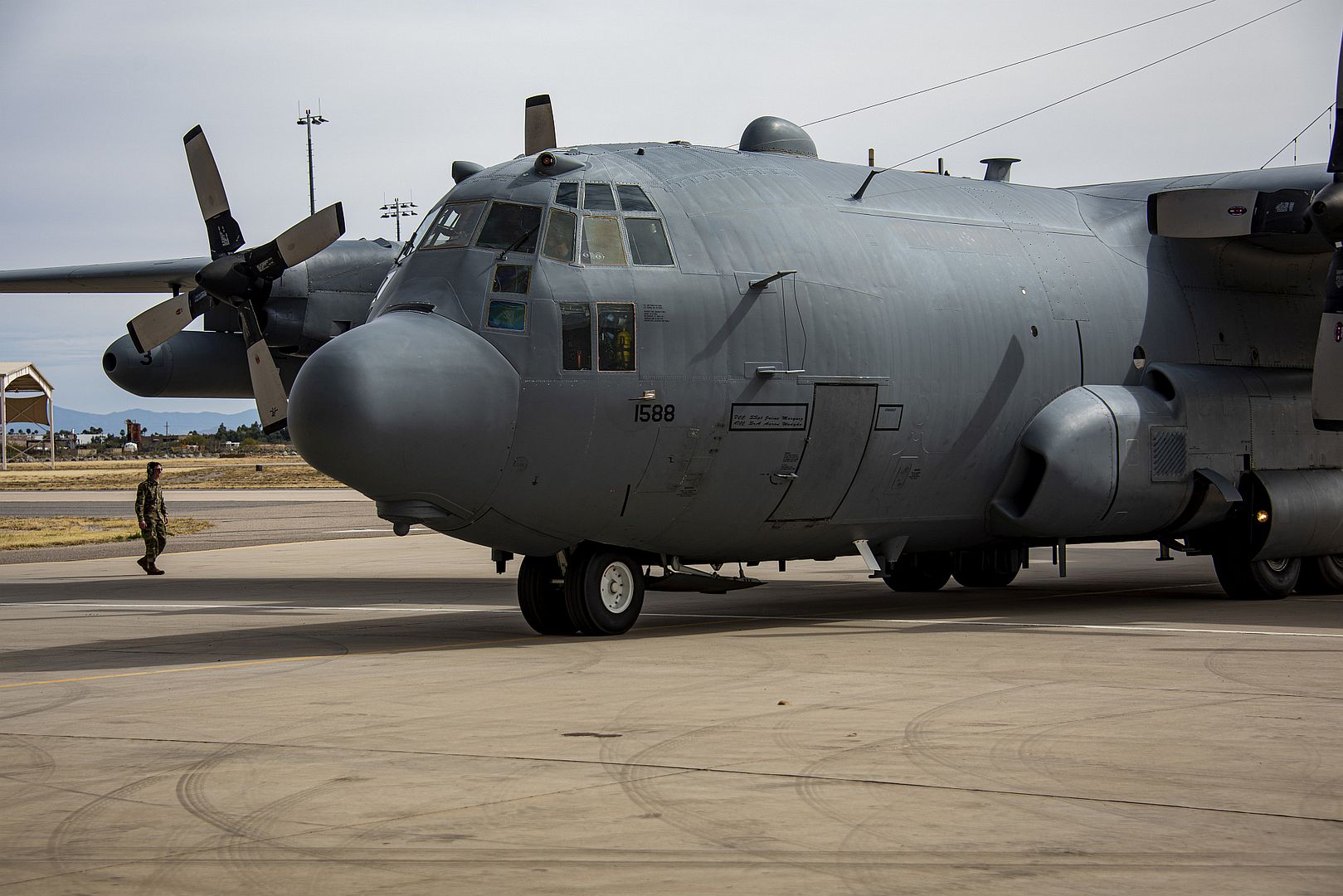
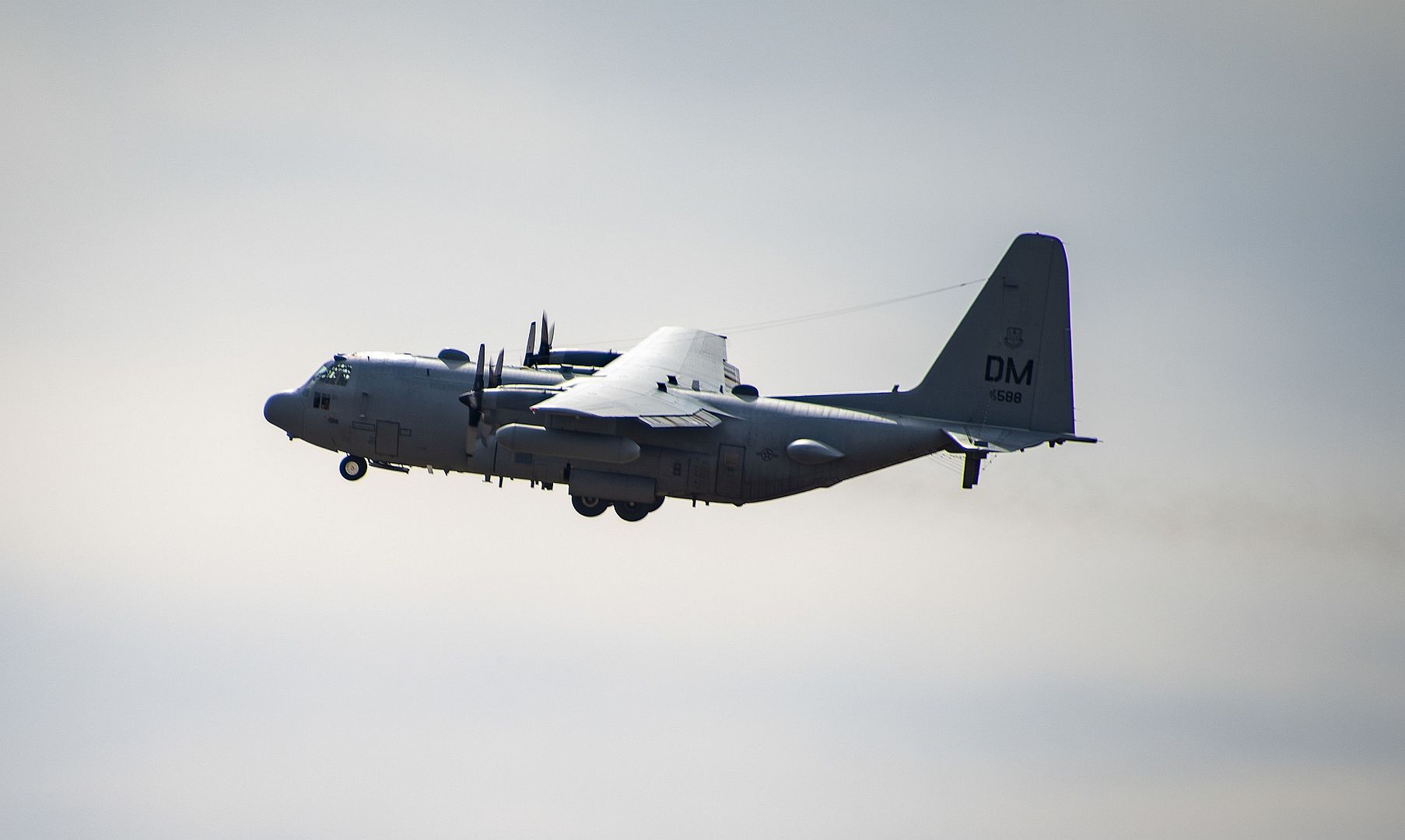
PACIFIC OCEAN (Mar. 1, 2022) An F/A-18E Super Hornet, from the "Kestrels" of Strike Fighter Squadron (VFA) 137, lands on the flight the aircraft carrier USS Nimitz (CVN 68). Nimitz is currently underway conducting routine operations. (U.S. Navy photos by Mass Communications Specialist Second Class Bryant Lang and Mass Communication Specialist 3rd Class Lorenzo Fekieta-Martinez)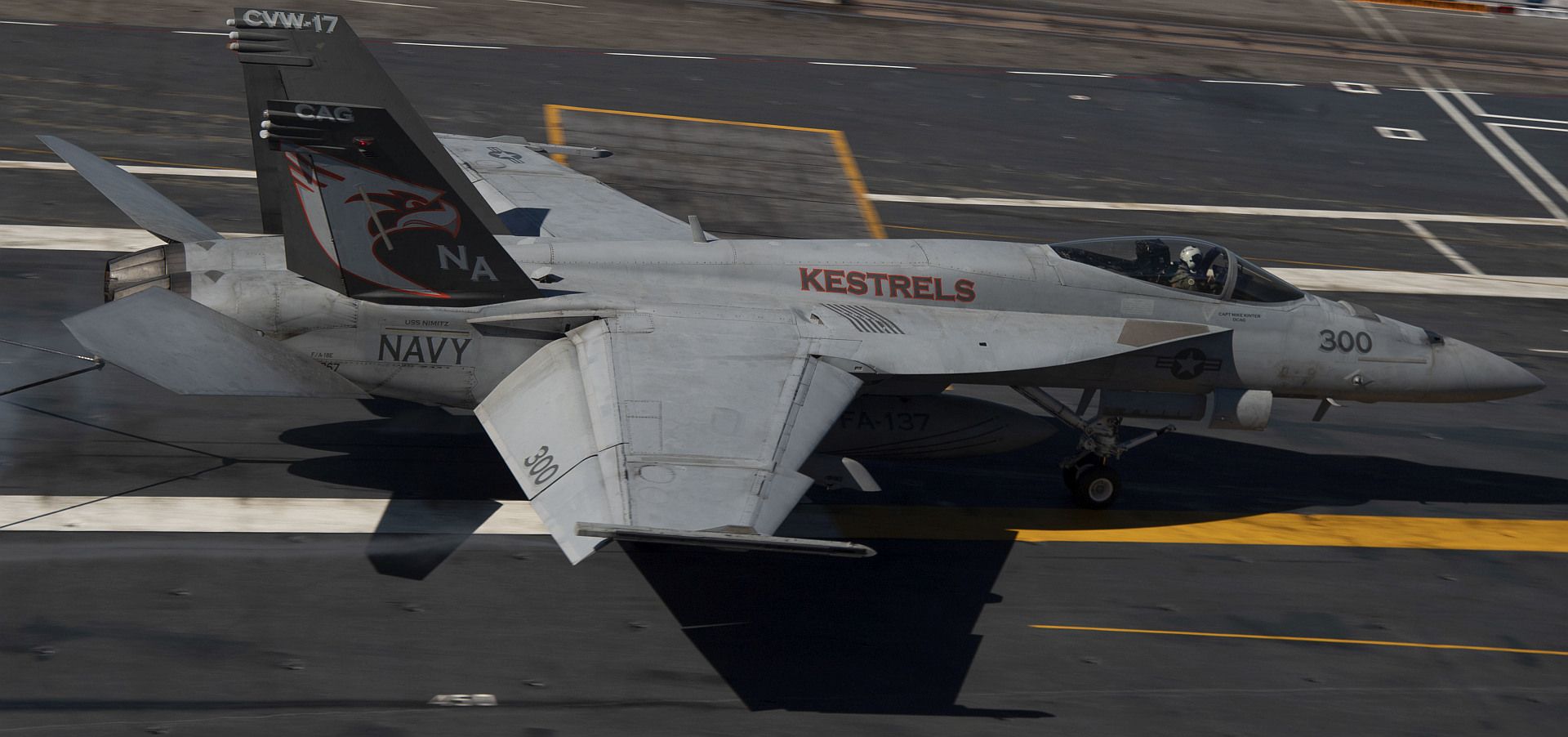

Airmen from the 2nd Bomb Wing pose for a photo at Barksdale Air Force Base, Louisiana, Feb. 19, 2022, after relocating a retired B-1B Lancer to its new location. Approximately ten squadrons across the wing worked together to move the B-1 from the flightline to the Barksdale Global Power Museum.
(Photos by Staff Sgt. Tristan Biese )
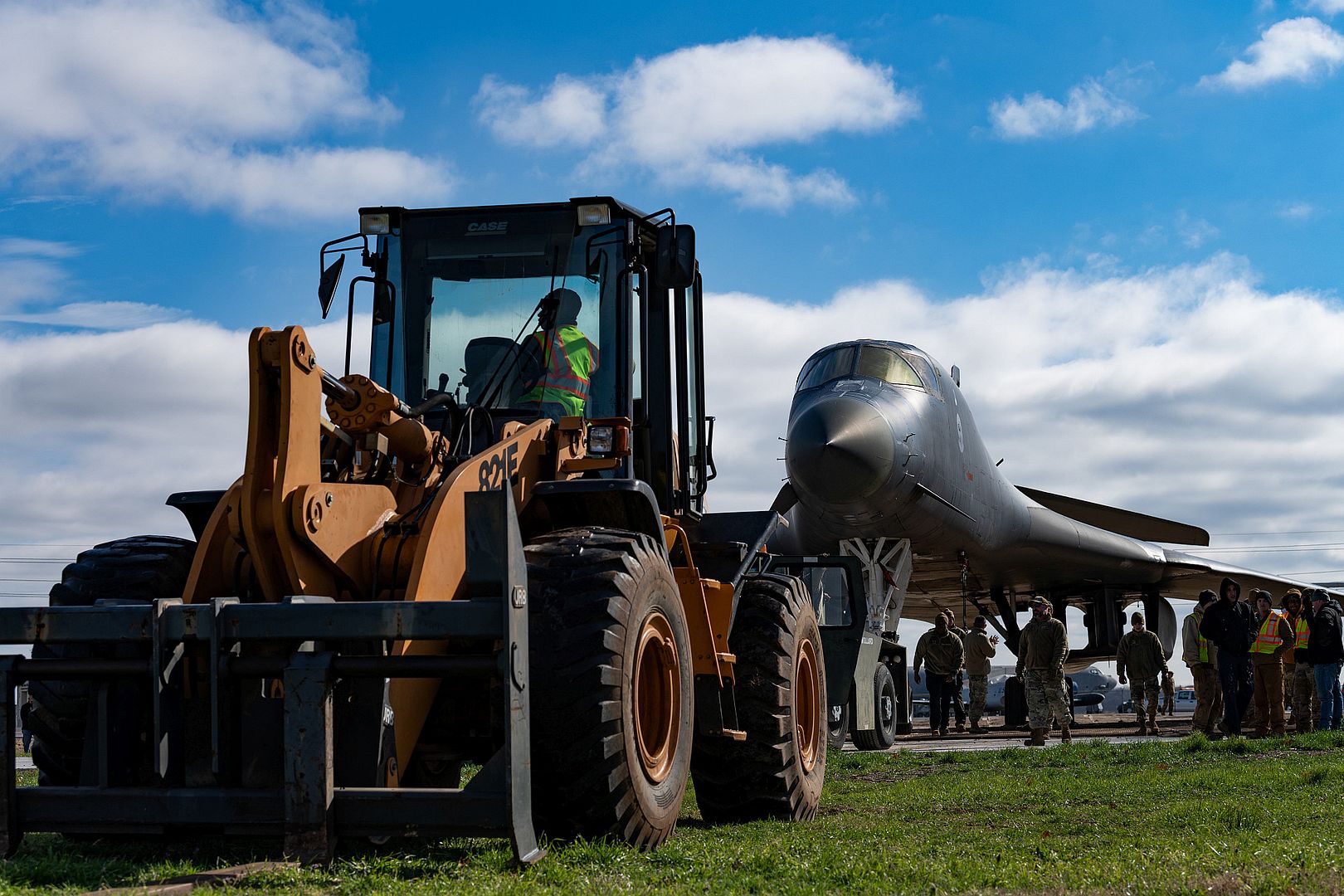
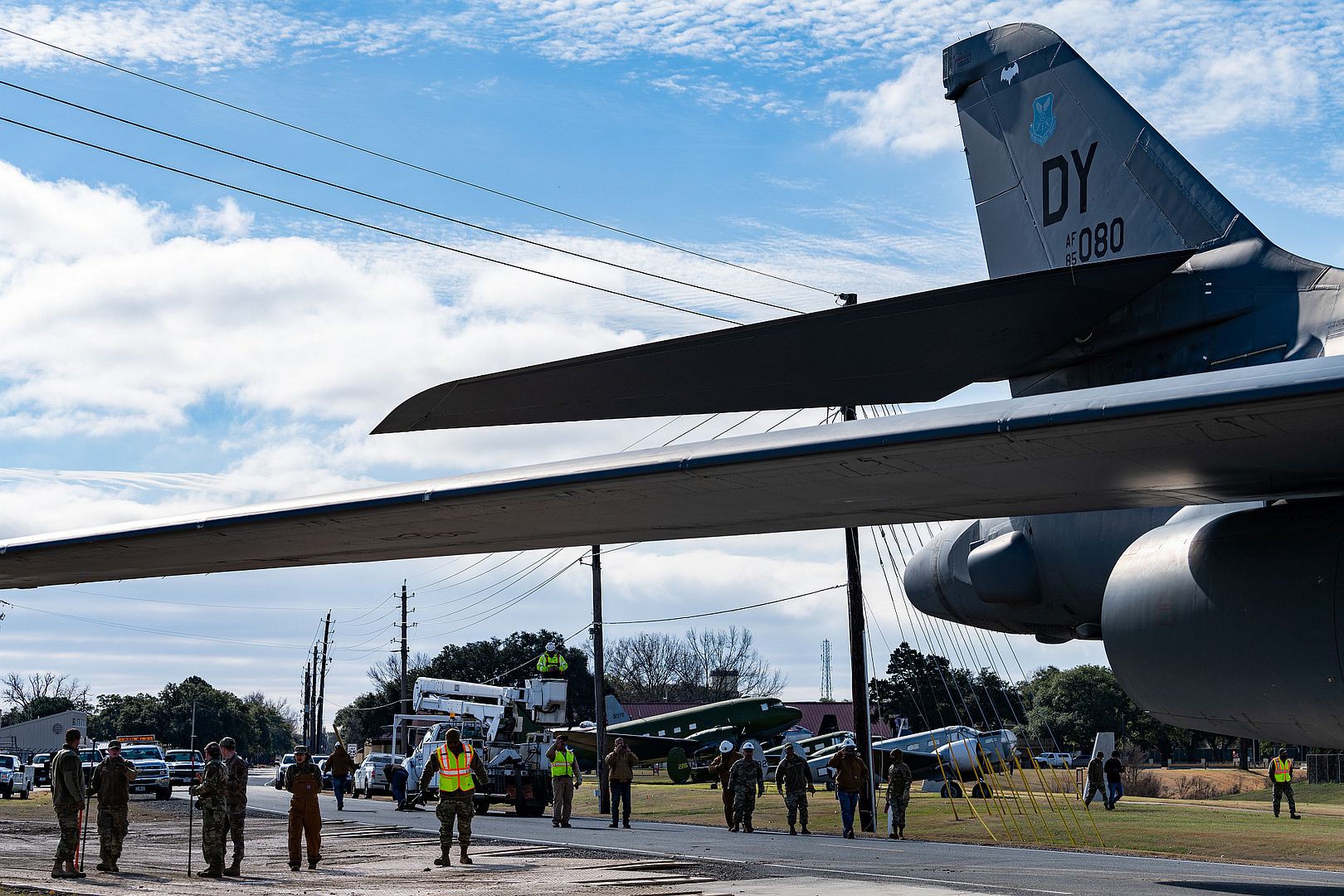
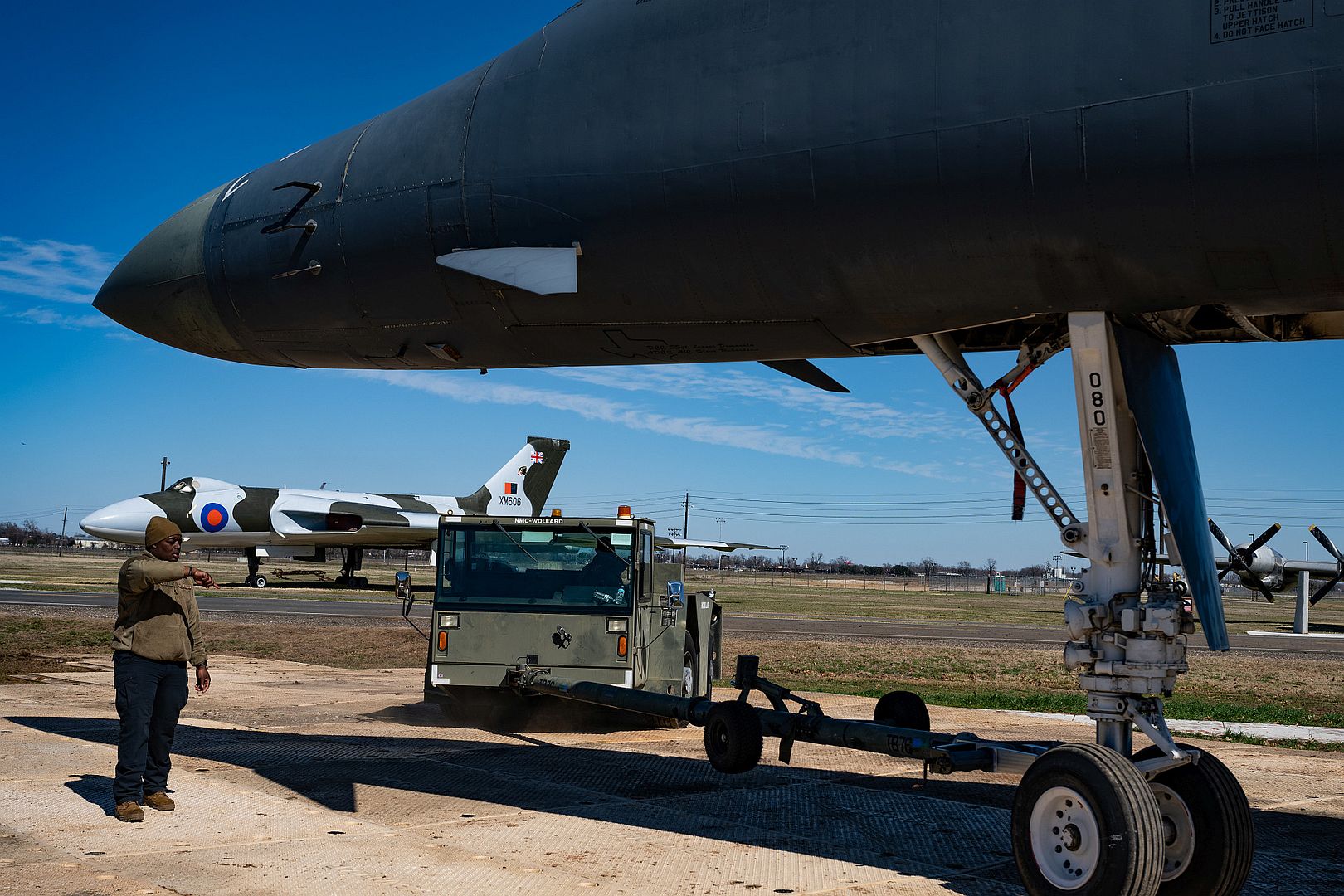
ARABIAN GULF (Feb. 13, 2022) A Royal air force of Oman Hawk Mk 166 Advanced Jet Trainer conducts helicopter insertion and extraction training during International Maritime Exercise/Cutlass Express (IMX/CE) 2022 in the Arabian Gulf. IMX/CE 2022 is the largest multinational training event in the Middle East, involving more than 60 nations and international organizations committed to enhancing partnership and interoperability to strengthen maritime security and stability. (U.S. Army photo by Spc. Natianna Strachen)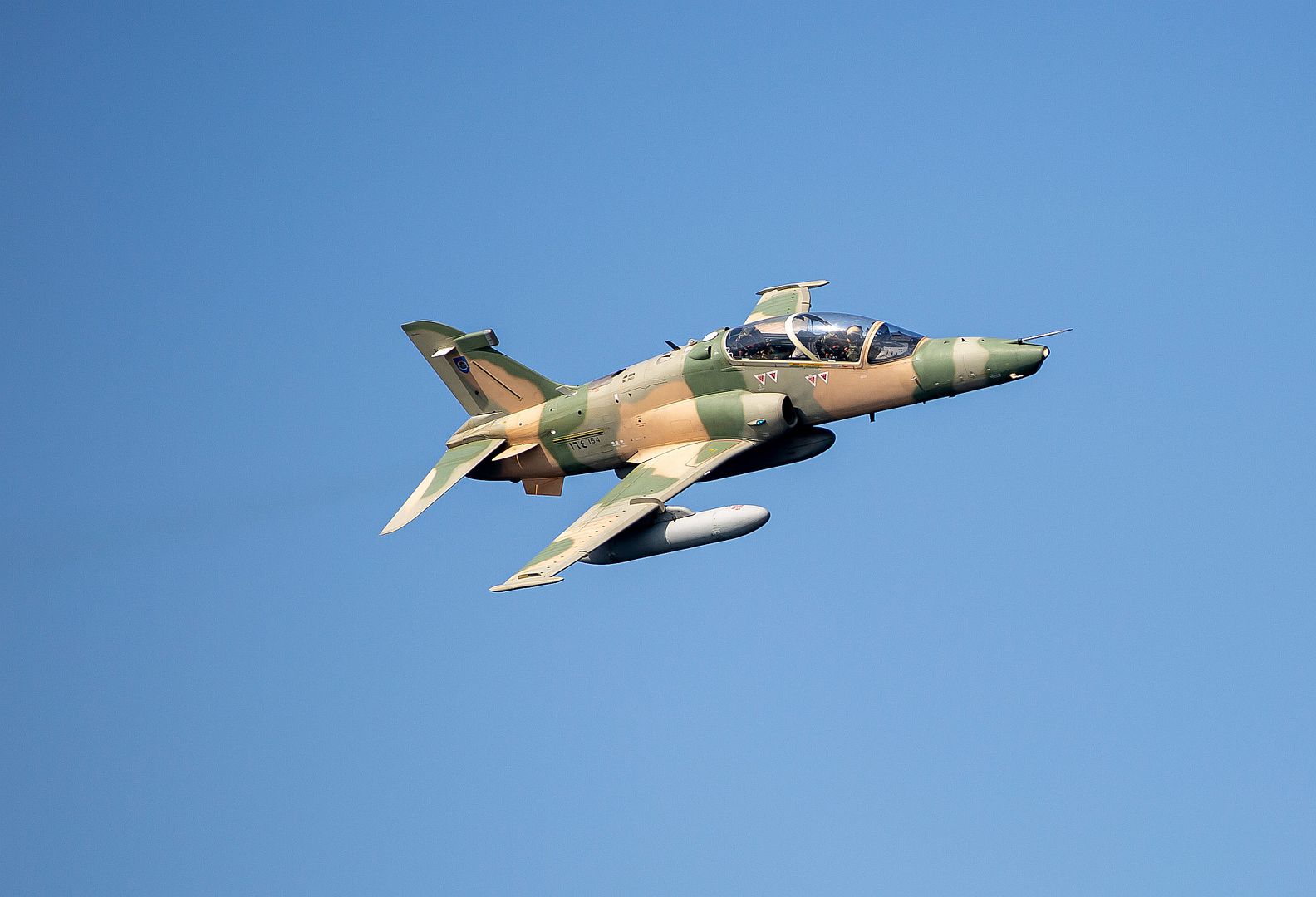
CAPE CANAVERAL SPACE FORCE STATION, Fla., March 1, 2022 /PRNewswire/ -- Space and Earth weather forecasting across the Western Hemisphere just got a little boost thanks to the Geostationary Operational Environmental Satellite (GOES-T), an advanced weather satellite built by Lockheed Martin [NYSE: LMT] for the National Oceanic and Atmospheric Administration (NOAA). The satellite successfully launched from Florida's Space Coast at 4:38 p.m. ET.
"GOES-T's launch is the culmination of innovative engineering, science and strong teamwork between NASA, NOAA and Lockheed Martin," said Jagdeep Shergill, Lockheed Martin's GOES-R chief engineer and program manager. "With the impact climate change has on weather patterns around the world, the work of satellites like GOES-T is more crucial than ever before, to help keep people safe now and in the future."
GOES-T will be renamed GOES-18 when it reaches geostationary orbit. Once operational, GOES-18 will take GOES-17's place tracking atmospheric rivers, floods, wildfires, drought, and other severe weather and climate phenomena over the West Coast of the United States.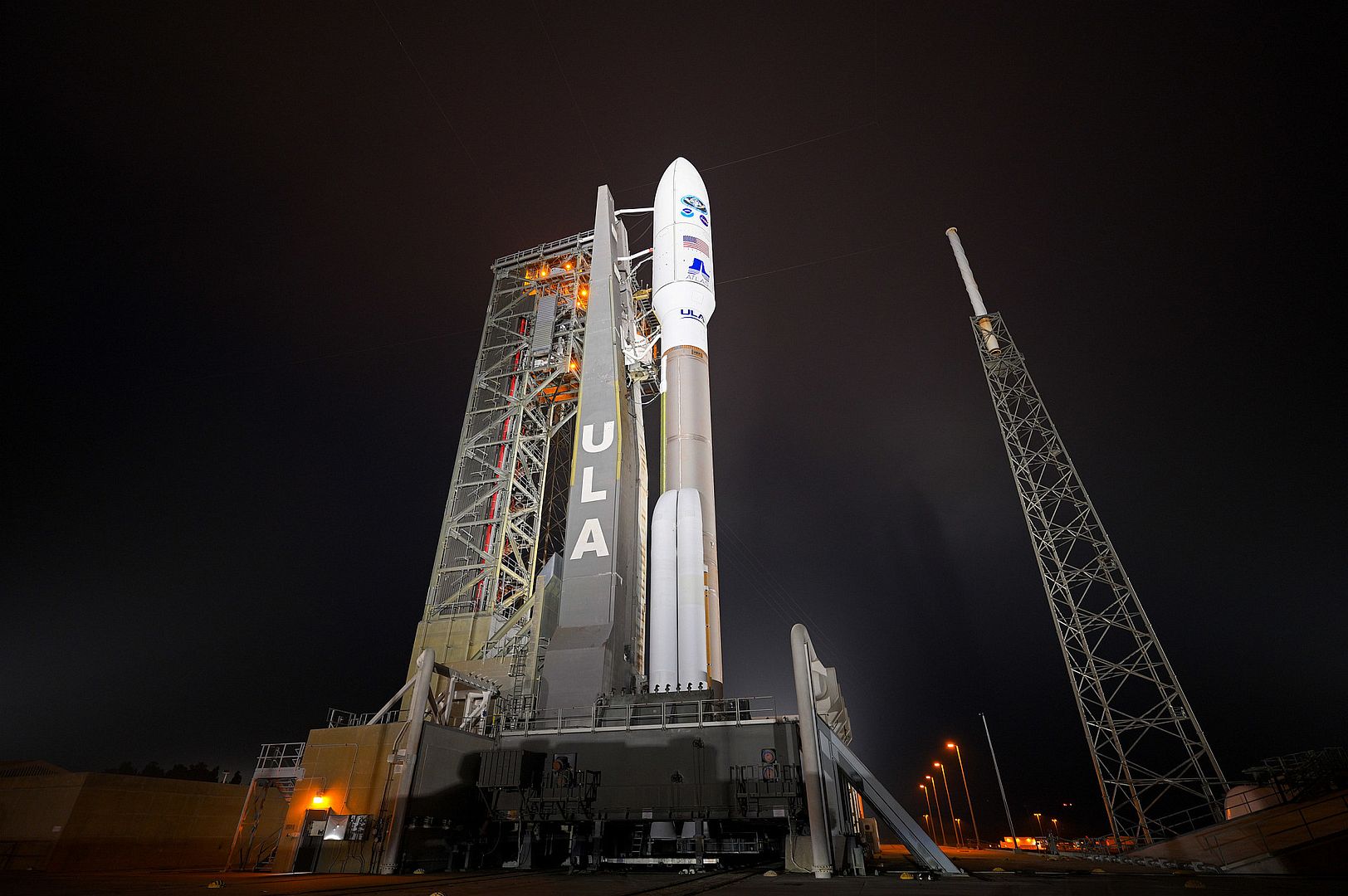
Advanced Monitoring of Weather, Oceans and Climate
As climate change continues to drive more frequent and severe environmental impacts, the GOES-R satellite series – of which GOES-T is the third – uses sophisticated technology to put information in the hands of those who need it most, when they need it.
Before it starts collecting and sharing critical weather data, the satellite's journey to space began in Littleton, Colorado, where it was designed and built by Lockheed Martin engineers.
Based on Lockheed Martin's novel A2100 satellite bus design, the spacecraft features two high-tech instruments built by the company's Advanced Technology Center in Palo Alto, California:
Geostationary Lightning Mapper (GLM), which is a first-of-its-kind operational lightning mapper flown into its orbit, tracking lightning across the U.S. in real-time. By collecting data on the frequency, location and extent of lightning discharges, GLM allows meteorologists to quickly identify intensifying storms and take appropriate action. In 2020, GLM captured a lightning megaflash nearly 500 miles long that broke the world record for longest lightning flash.
Solar Ultraviolet Imager (SUVI), focuses on space weather and measures the sun in extreme ultraviolet wavelength range and provides solar images. SUVI is essential to understanding active areas on the sun and predicting solar events that may disrupt power utilities, communication or navigation systems here on Earth.
Over its 10-year operational lifetime, GOES-T can produce over a terabyte of data per day and monitors severe weather continuously, supporting NOAA's mission to provide weather data to save lives.
What's After Lift Off?
Now that it's in space, GOES-T will undergo an on-orbit checkout of its instruments and systems before beginning official operations in January 2023.
In addition to severe weather monitoring, it will do things like:
Identify volcanic eruptions, even ones under the ocean, like the recent event near Tonga
Measure land and sea surface temperatures to track drought conditions and warming oceans
Provide early alerts to emergency responders for wildfires, including those caused by lightning strikes
Observe solar flares that could impact telecommunication on and around Earth
With three of the four GOES-R weather satellites now launched, GOES-U, the last satellite in the series, is in production and planned for a 2024 launch.
Beyond the GOES-R series, Lockheed Martin looks forward to continued partnership with NASA and NOAA as they look ahead to future weather and climate missions.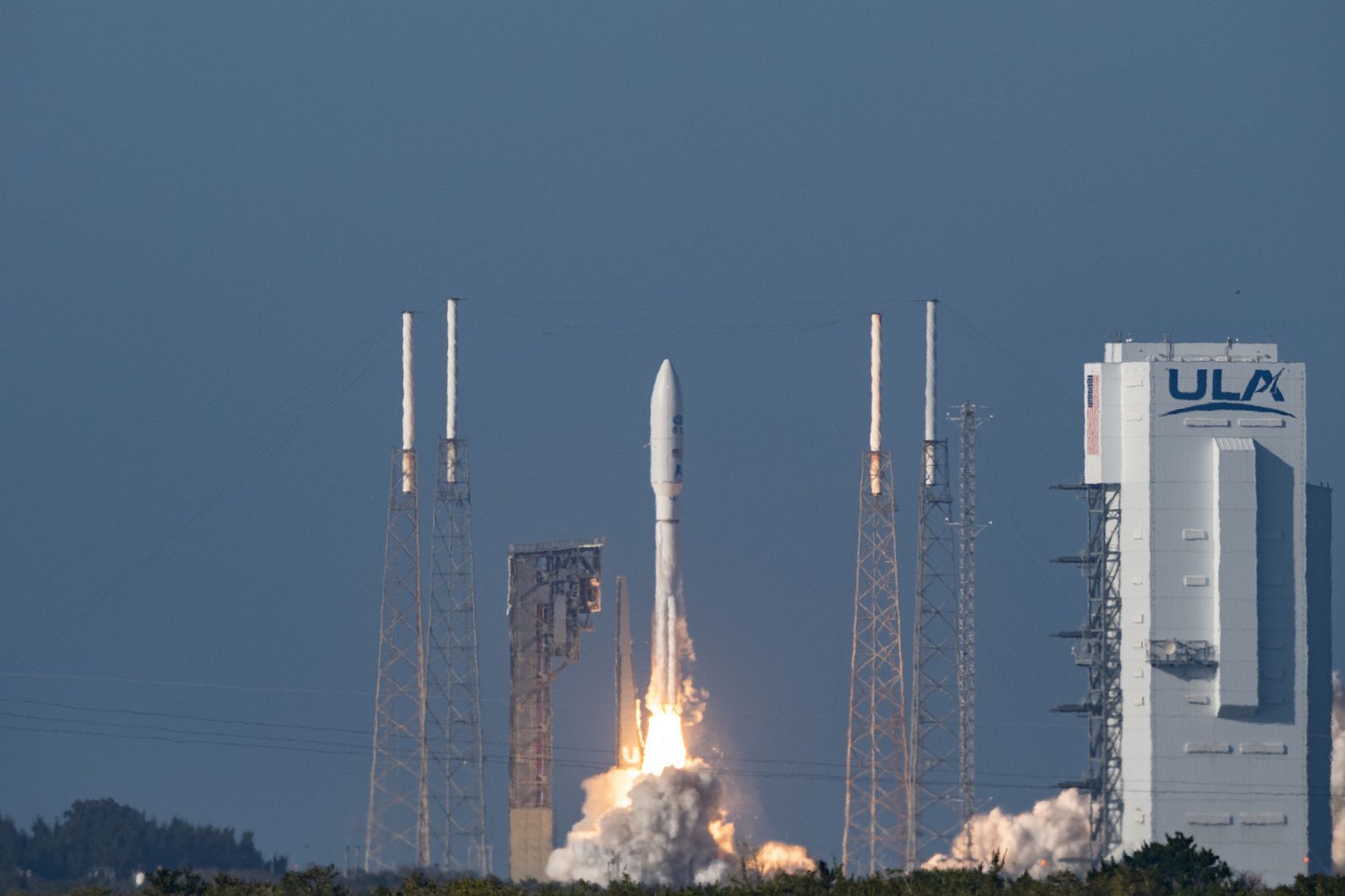
SAN DIEGO – 02 March 2022 – The MQ-9A Remotely Piloted Aircraft has surpassed 2 million flight hours in support of global customers. The workhorse unmanned aircraft from General Atomics Aeronautical Systems, Inc. (GA-ASI) combines unmatched persistence and mission flexibility with a >90% Mission Capable Rate, which puts the MQ-9A in a class by itself.
“We developed the MQ-9A to set the standard for persistent surveillance and rapid strike capability, and it’s delivered on expectations,” said GA-ASI Vice President of DoD Strategic Development, J.R. Reid. “The effectiveness of a military aircraft can be measured in how often its used (total flight hours) and in its readiness to perform, and the MQ-9A exceeds in performance on both metrics.”
When combined with the flight hours of other GA-ASI aircraft, which includes Predator A and Predator XP; Predator B Extended Range (ER), Guardian, Gray Eagle and Gray Eagle ER; Predator C Avenger; and MQ-9B SkyGuardian and SeaGuardian®, the total flight hours for the GA-ASI fleet exceed 7.2 million supporting close to 500,000 missions.
GA-ASI aircraft average more than 48,000 hours per month supporting the U.S. Air Force, U.S. Army, U.S. Marine Corps, NASA, the Italian Air Force, the UK Royal Air Force, the French Air Force, the UAE Armed Forces, the Indian Government, and new MQ-9As are being delivered to the Royal Netherlands Air Force now. Missions include helping protect ground units on the battlefield; supporting first responders in the wake of natural disasters; and providing critical ISR around the world. With a host of additional reconnaissance, surveillance, and communications payloads in development and early fielding, GA-ASI UAS continue to demonstrate exceptional value across the full spectrum of current and future operations.
The MQ-9A Block 5 has endurance of over 27 hours, speeds of 240 KTAS and can operate up to 50,000 feet. It has a 3,850-pound (1,746-kilogram) payload capacity that includes 3,000 pounds (1,361 kilograms) of external stores. It provides a long-endurance, persistent surveillance capability with Full-Motion Video and Synthetic Aperture Radar/Moving Target Indicator/Maritime Radar. An extremely reliable aircraft, MQ-9A Block 5 is equipped with a fault-tolerant flight control system and triple redundant avionics system architecture. It is engineered to meet and exceed manned aircraft reliability standards.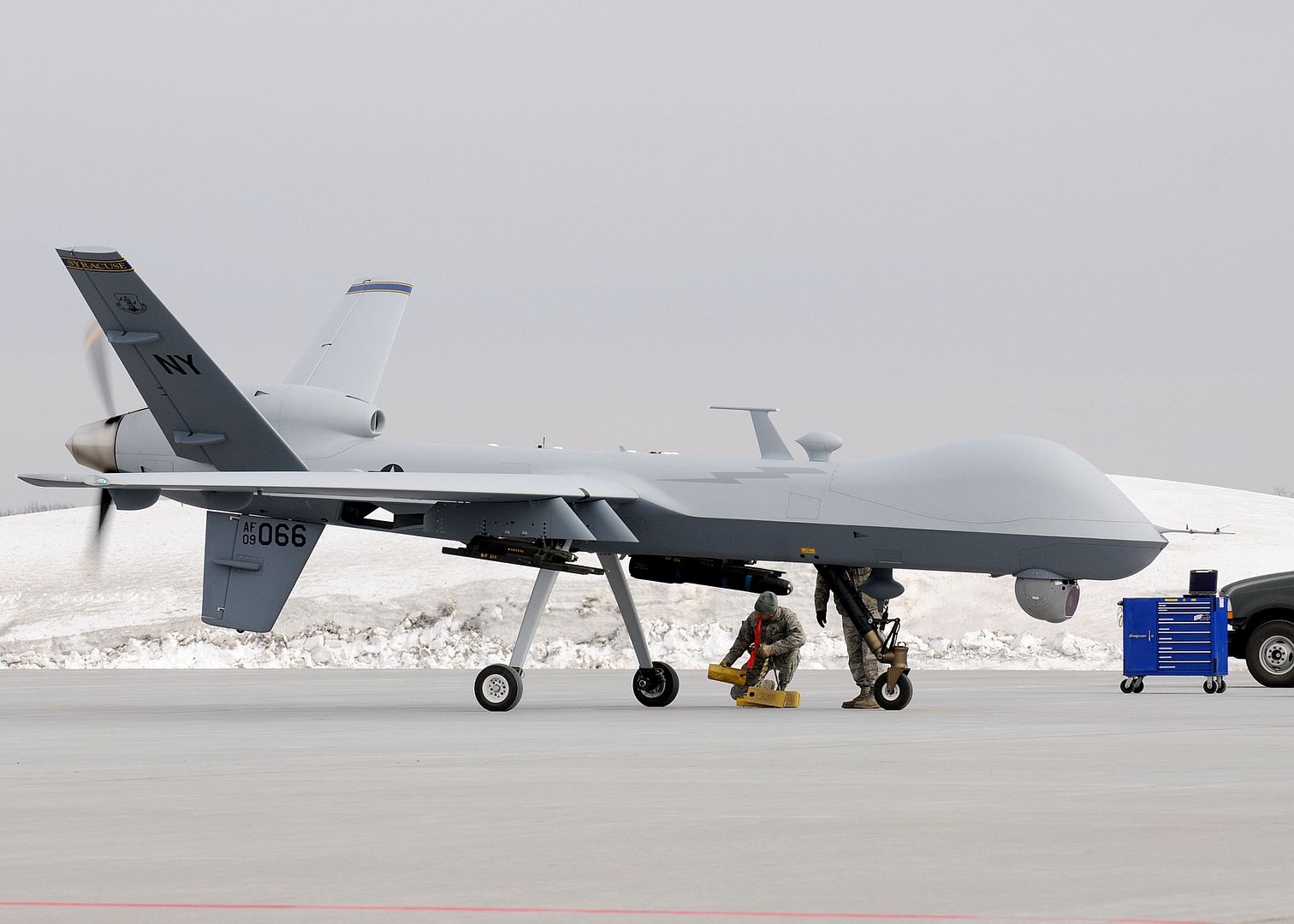
-
 Main AdminA U.S. Air Force F-35 Lightning II aircraft assigned to the 48th Fighter Wing, Royal Air Force Lakenheath, England, flies over Siauliai Air Base, Lithuania, March 2, 2022. The fifth generation aircraft forward deployed to multiple locations in the Baltic region to support NATO’s collective defense and enhanced air policing mission. (U.S. Air Force photo by Senior Airman John R. Wright)
Main AdminA U.S. Air Force F-35 Lightning II aircraft assigned to the 48th Fighter Wing, Royal Air Force Lakenheath, England, flies over Siauliai Air Base, Lithuania, March 2, 2022. The fifth generation aircraft forward deployed to multiple locations in the Baltic region to support NATO’s collective defense and enhanced air policing mission. (U.S. Air Force photo by Senior Airman John R. Wright)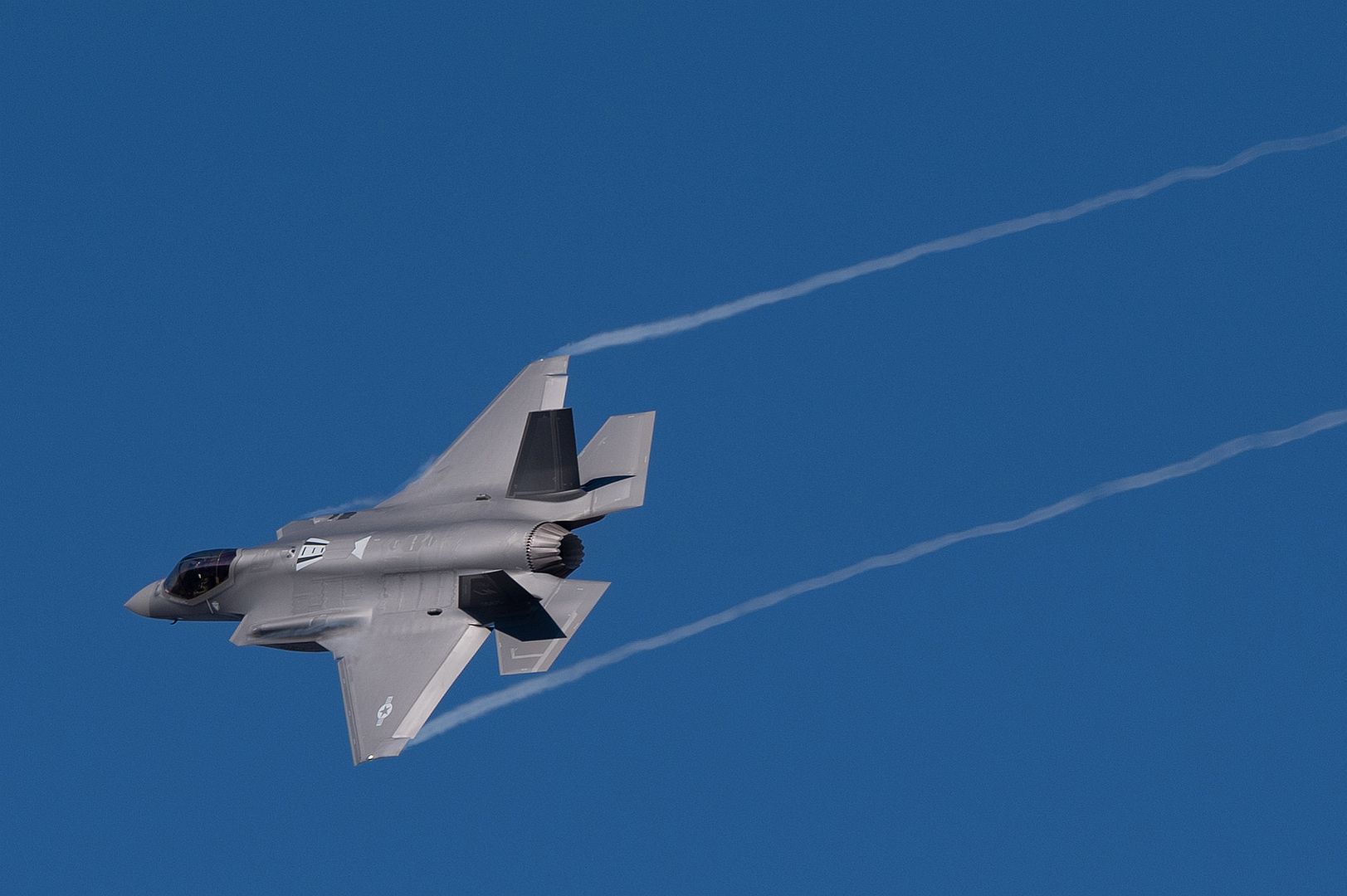
U.S. Air Force Lt. Col. Tyler Cox, 173rd Fighter Wing F-15 instructor pilot, taxis out an F-15C Eagle in preperation for a routine training mission at Kingsley Field in Klamath Falls, Oregon March 1, 2022. The 173rd Fighter Wing is home to the premier F-15C training base for the United States Air Force. (U.S. Air National Guard photos by Senior Master Sgt. Jennifer Shirar)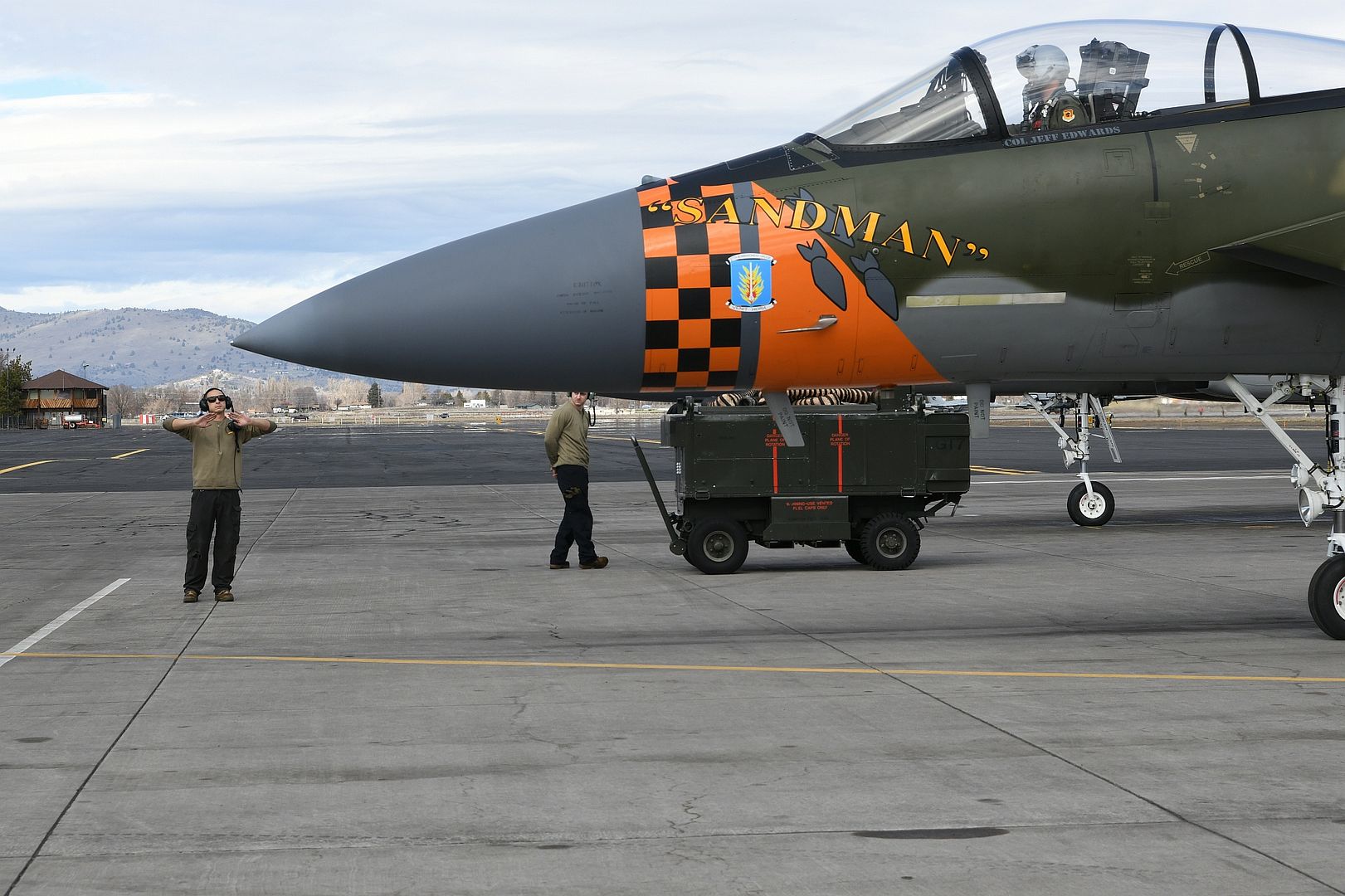
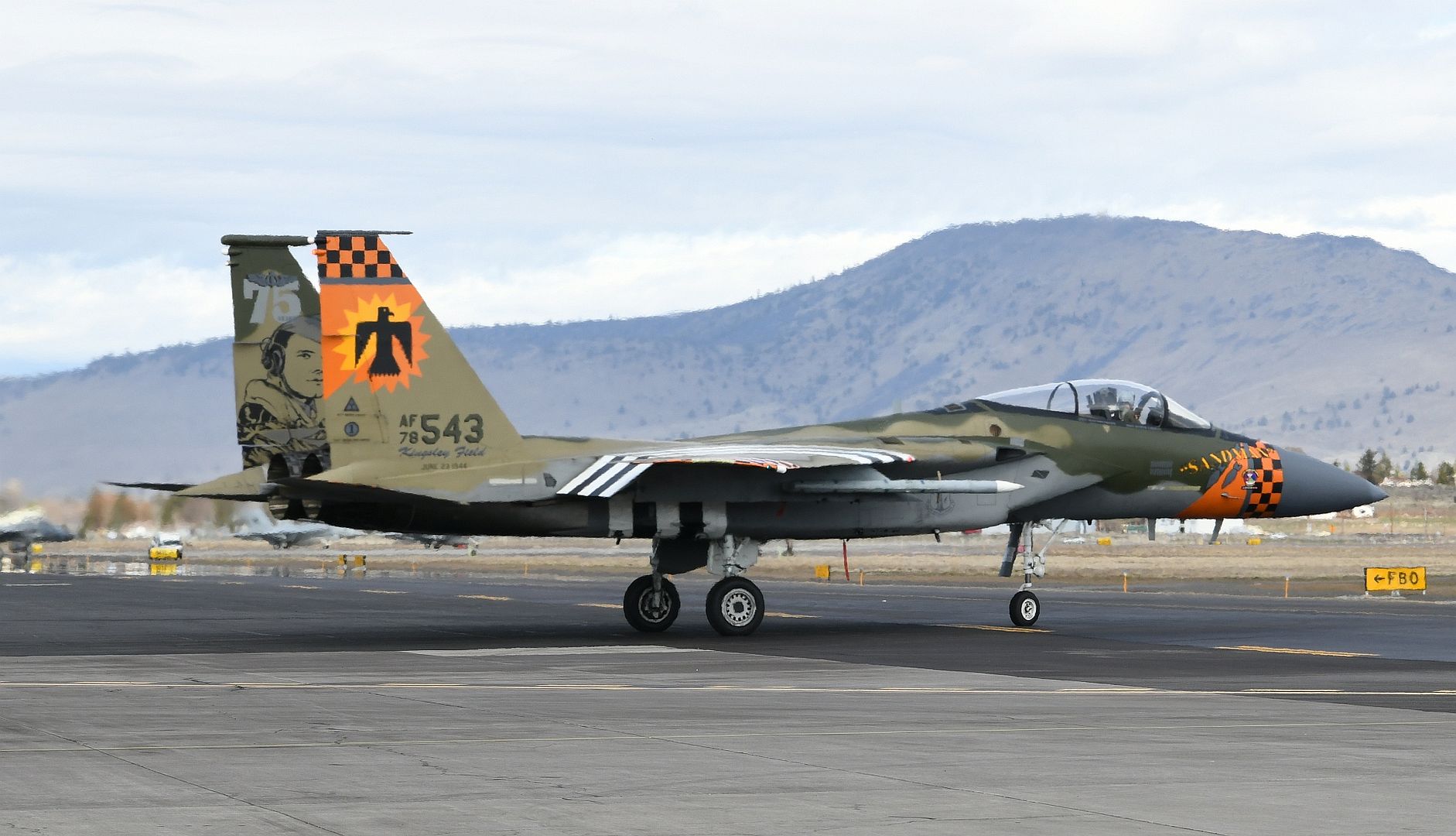
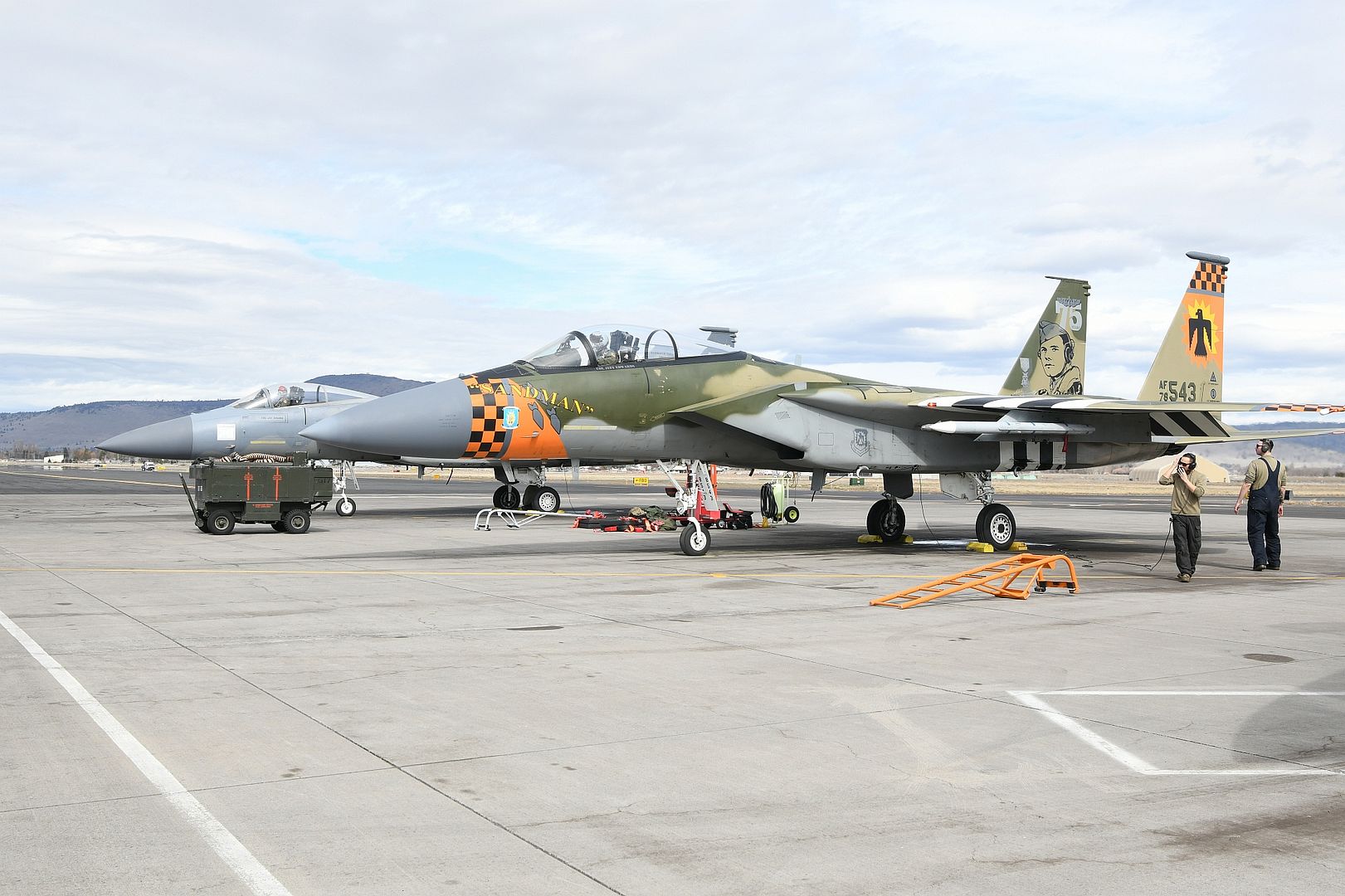

PACIFIC OCEAN (Mar. 02, 2022) F/A-18F Super Hornets and an F/A-18E Super Hornet, from Carrier Air Wing (CVW) 17, rest on the flight deck of the aircraft carrier USS Nimitz (CVN68). Nimitz is underway conducting routine operations. (U.S. Navy photo by Mass Communication Specialist 3rd Class Jared Mancuso)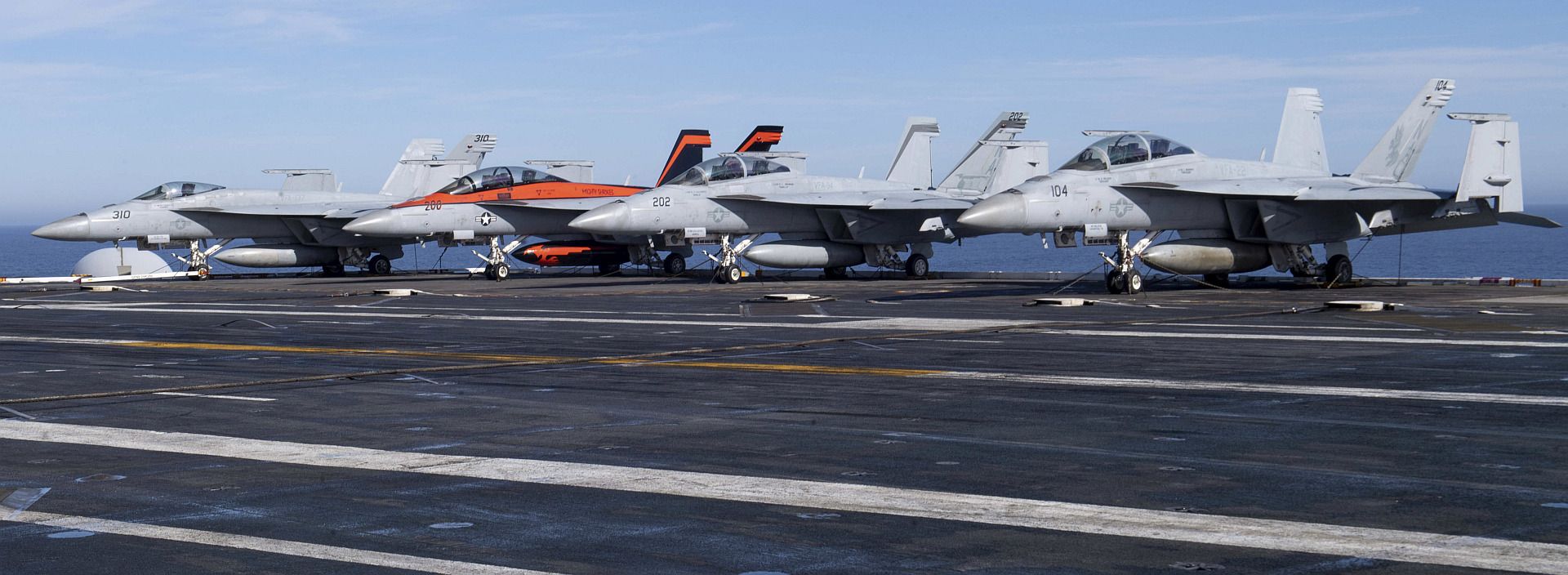
A B-52H Stratofortress from the 69th Expeditionary Bomb Squadron at RAF Fairford, England, flies in formation with two Polish Air Force MiG-29s and two F-15E Strike Eagles from the 336th Fighter Squadron at Seymour Johnson Air Force Base, North Carolina, Feb. 24, 2022. The 69th EBS Bomber Task Force mission was integrate with U.S. Eastern European Allies.(U.S. Air Force photo by Airman 1st Class Zachary Wright)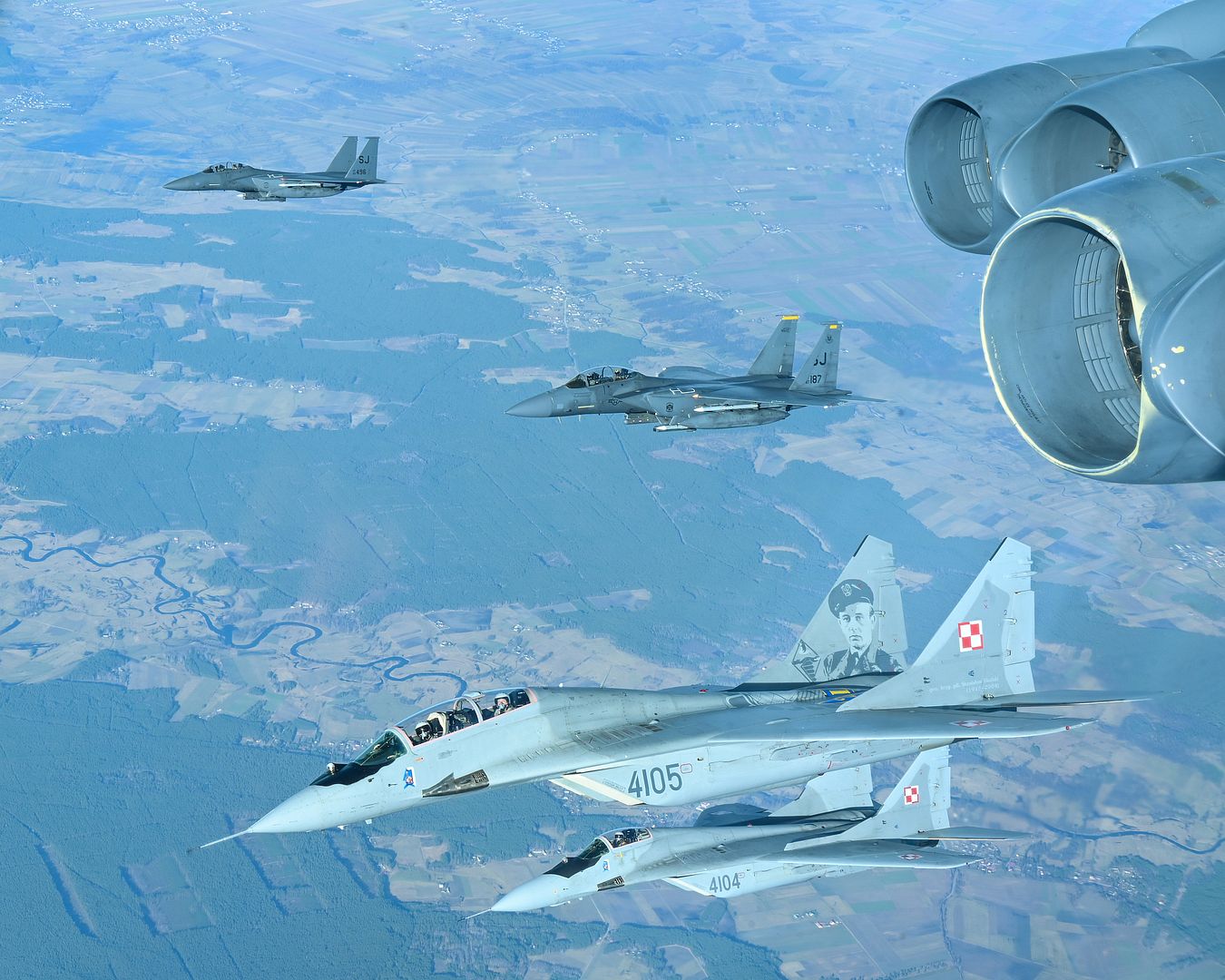
A Swedish Saab JAS-39 Gripen fighter jet escorts a B-52H Stratofortress, assigned to the 69th Expeditionary Bomb Squadron, RAF Fairford, England, over Sweden, during Bomber Task Force England Feb. 18, 2022. The U.S. is the only Allied nation that maintains strategic bomber capabilities and exercises their global reach on behalf of Allies and partners around the globe--anytime, anywhere. (U.S. Air Force photo by Tech. Sgt. Corban Lundborg)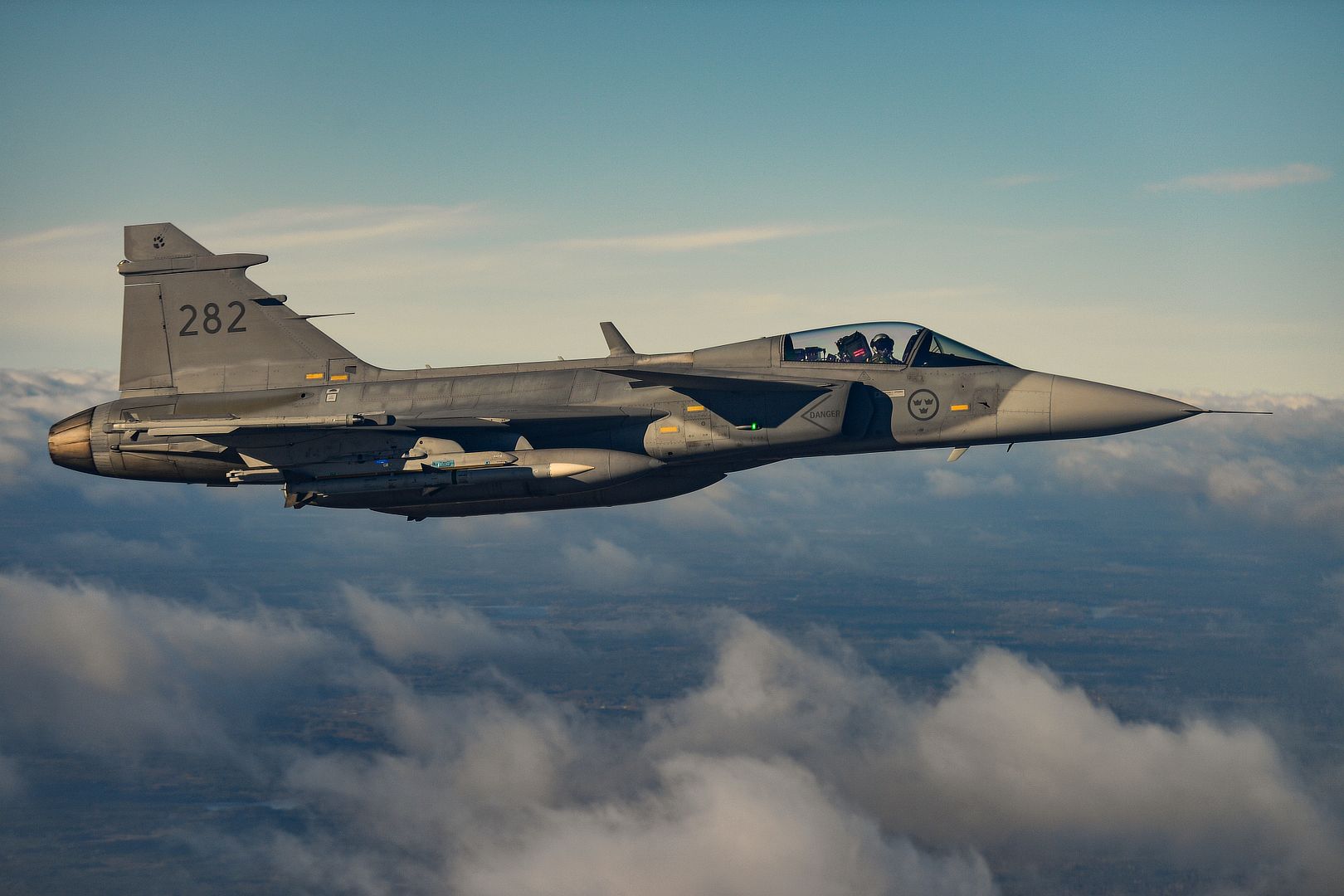
LAKE CHARLES, La. – March 3, 2022 – Northrop Grumman Corporation (NYSE: NOC) announced it was recently awarded the Integrated Modification and Maintenance Contract for the U.S. Navy’s E-6B Mercury platform, a derivative of the commercial Boeing 707 aircraft. The work will be performed at Northrop Grumman’s Aircraft Maintenance and Fabrication Center in Lake Charles.
“We are laser focused on providing the most relevant capabilities while improving mission readiness,” said Mary Petryszyn, corporate vice president and president of Defense Systems at Northrop Grumman. “As leaders in aircraft sustainment and modernization, the US Navy’s E-6B Mercury fleet is another example of our strong partnership with the Navy in achieving those goals.”
Over the next five years, Northrop Grumman will perform modifications to the Navy’s E-6B aircraft improving command, control and communications functions that connect the national command authority with the United States’ Nuclear Triad. The company will establish a consolidated production line for core modifications required under the $111 million contract. Northrop Grumman may also take on additional, smaller modifications and select depot maintenance tasks as required.
As part of the critical Take Charge and Move Out (TACAMO) strategic communications mission, the E-6B operates across a wide frequency spectrum to transmit and receive secure and non-secure voice and data information. The aircraft provides survivable, endurable, reliable airborne command, control, and communications in support of the President, Secretary of Defense, and United States Strategic Command.
Northrop Grumman provides sustainment and modernization support that includes: contractor logistics support and fleet stewardship; modifications and upgrades; mission planning, weapon systems development and pilot training; as well as software design engineering and integration solutions on autonomous, tactical, fixed wing and special mission aircraft systems, including:
F-35 Lightning II; P-3 Orion; BACN E-11A; E-8C; A-10 Thunderbolt II; B-2 Spirit; RQ-4 Global Hawk and more. This contract continues the company’s expansive growth in aircraft maintenance, repair, overhaul and upgrade.
Northrop Grumman is a technology company, focused on global security and human discovery. Our pioneering solutions equip our customers with capabilities they need to connect, advance and protect the U.S. and its allies. Driven by a shared purpose to solve our customers’ toughest problems, our 90,000 employees define possible every day.
(U.S. Air Force photo/Greg L. Davis)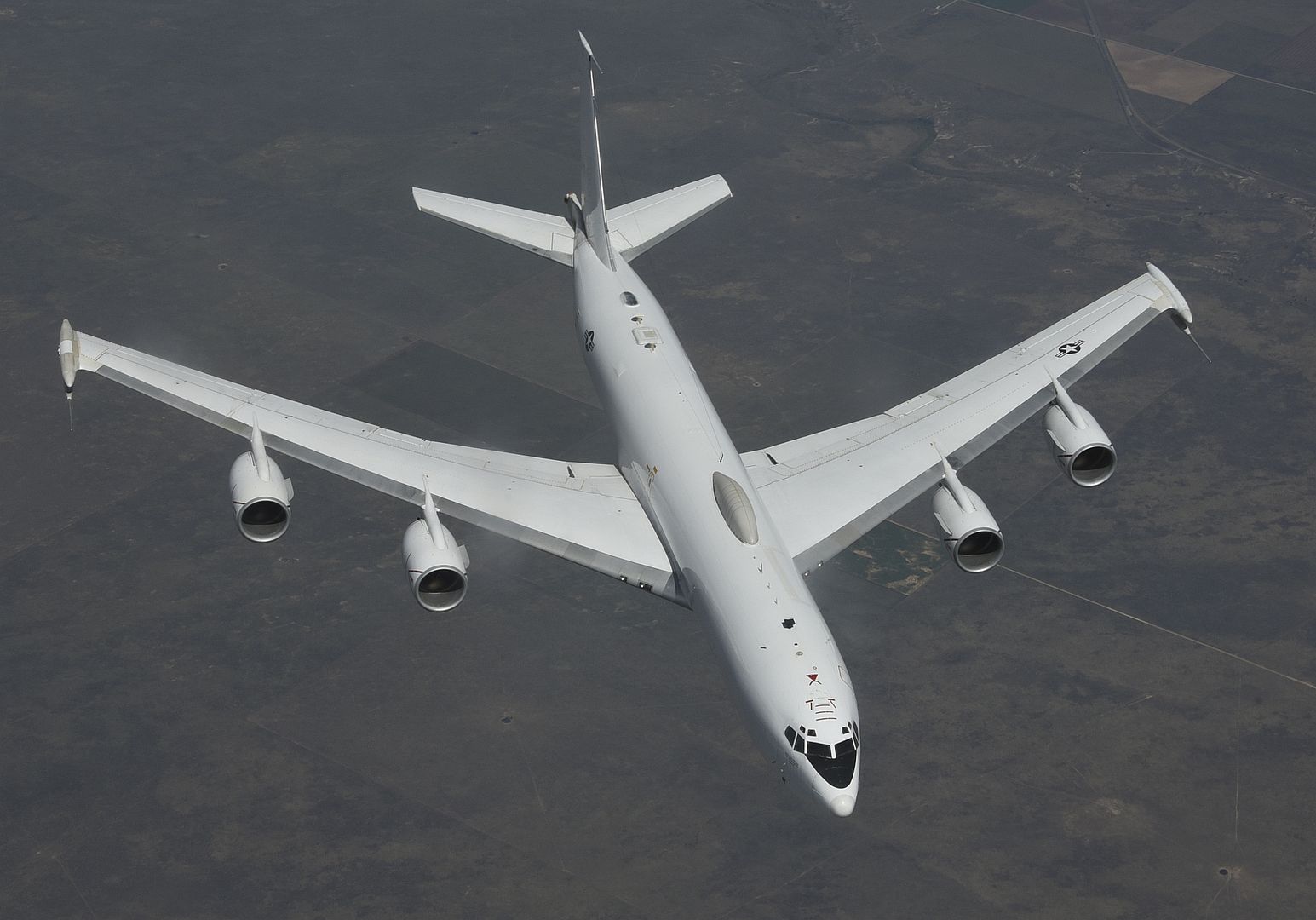
PHILADELPHIA, March 3, 2022 — Boeing [NYSE: BA] extends its partnership with the U.S. Army Special Operations Aviation Command (USASOAC) with an order for six additional MH-47G Block II Chinook helicopters. The award, valued at $195 million, brings the total number of MH-47G Block II aircraft under contract with the USASOAC to 36.
The upgraded MH-47G Block II Chinook features improved structure and weight reduction initiatives that increase the aircraft’s performance and efficiency, allowing for extended lift and range.
“We’re answering the USASOAC's call to modernize its fleet of heavy-lift helicopters,” said Andy Builta vice president, Cargo programs and H-47 program manager. “With this upgrade, new advances in technology enable the proven Chinook to meet evolving threats and ever-changing mission requirements.”
Boeing has delivered five MH-47G Block II aircraft to date. Deliveries of the new order are scheduled to begin in 2024, with production to primarily take place at Boeing’s Philadelphia site.
The H-47 Chinook program supports more than 20,000 jobs and 360 suppliers in 40 states, and is relied on by the U.S. Army and 19 countries around the globe. Supporting a global fleet of more than 950 aircraft, Boeing continues to deliver unrivaled production, maintenance and sustainment cost efficiencies.
As a leading global aerospace company, Boeing develops, manufactures and services commercial airplanes, defense products and space systems for customers in more than 150 countries. As a top U.S. exporter, the company leverages the talents of a global supplier base to advance economic opportunity, sustainability and community impact. Boeing’s diverse team is committed to innovating for the future and living the company’s core values of safety, quality and integrity. Learn more at www.boeing.com.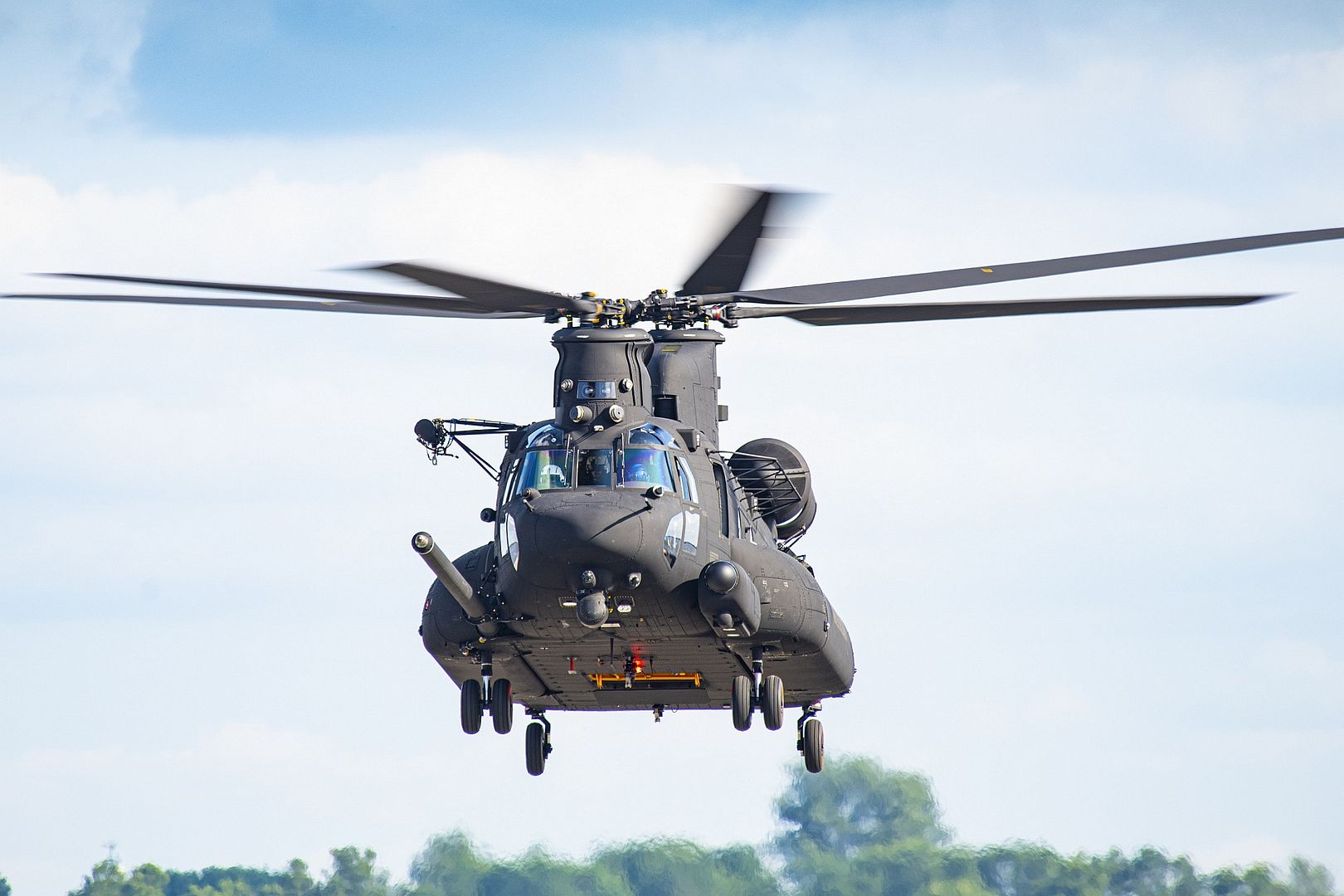
Amsterdam, The Netherlands, March 3, 2022 – Embraer announced that it has signed a multi-year contract extension with German Airways for the Pool Program. With this agreement, the customer will receive support for a wide range of repairable components for the airline’s fleet of five E190 jets. Currently, Embraer’s Pool Program supports more than 50 airlines worldwide.
German Airways is a German airline and leader in the European wet-lease market. Currently, it serves several European airlines all of which utilize comfortable, highly economic, and modern E190 jets.
Embraer provides support to airlines worldwide, with its technical expertise and its vast component services network. The results are significant savings in repair and inventory carrying costs and a reduction in warehousing space and resources required for repair management, while ultimately providing guaranteed performance levels. Embraer Services & Support’s portfolio offers a wide range of competitive solutions designed for each customer to support the growing fleet of Embraer aircraft worldwide and deliver the best after-sales experience in the global aerospace industry.
About German Airways
German Airways is the second oldest German airline: it was originally founded in 1955, later operated under the name WDL Aviation and has been flying under the name German Airways since 2020. The company is active in the world lease and charter business. The airline's aircraft fleet currently comprises five Embraer E190s. German Airways flies on world leases for well-known airlines, as a charter airline and for companies, professional sports clubs and private individuals.
SAN DIEGO – 03 March 2022 – General Atomics Aeronautical Systems, Inc. (GA-ASI), the world leader in unmanned aircraft and associated technologies, proudly announces its newest UAS platform: Gambit.
Like the chess opening move that inspires the name, Gambit is about initiative, leading from the front, using advanced sensing to grab the tactical advantage and open a world of possibilities.
Gambit is an Autonomous Collaborative Platform (ACP) designed through digital engineering to speed its time to market and lower acquisition cost, and it will deliver an extended and enhanced sensing capability. The jet-powered platform is being built for air dominance and will heavily leverage advances in artificial intelligence and autonomous systems. Working alongside human-piloted aircraft, Gambit will enable pilots to see deeper into hostile airspace, detect threats first, and provide time and space for critical decisions and actions.
“GA-ASI has led the way in integrating UAS into every aspect of military operations,” said GA-ASI President David R. Alexander. “Now we’re once again pushing the boundaries of what’s possible with unmanned aircraft, software, mission systems integration and more. Gambit will usher in a new era, where UAS work collaboratively with manned aircraft to detect, identify and target adversaries at range and scale across the battlespace.”
Designed as an advanced concept aircraft, Gambit will use AI and autonomy to complete a variety of tasks without being prompted by an operator. GA-ASI’s software and integration systems will support detection and analysis, and provide users with the highest quality intelligence, surveillance, and reconnaissance ever possible from an unmanned aircraft. On point out ahead of U.S. Air Force tactical aircraft, Gambit will also be able to sense and track targets of interest, and distribute that information across the battlespace.
“We’re designing systems to meet future requirements, to include working collaboratively and autonomously,” Alexander continued. “Gambit is part of a broader Family of Systems strategy that began with Predator and Reaper, and continues in support of USAF’s future force design concepts.”
About GA-ASI
General Atomics-Aeronautical Systems, Inc. (GA-ASI), an affiliate of General Atomics, is a leading designer and manufacturer of proven, reliable remotely piloted aircraft (RPA) systems, radars, and electro-optic and related mission systems, including the Predator® RPA series and the Lynx® Multi-mode Radar. With more than seven million flight hours, GA-ASI provides long-endurance, mission-capable aircraft with integrated sensor and data link systems required to deliver persistent flight that enables situational awareness and rapid strike. The company also produces a variety of ground control stations and sensor control/image analysis software, offers pilot training and support services, and develops meta-material antennas. For more information, visit www.ga-asi.com.
Post a reply
- Go to Previous topic
- Go to Next topic
- Go to Welcome
- Go to Introduce Yourself
- Go to General Discussion
- Go to Screenshots, Images and Videos
- Go to Off topic
- Go to Works in Progress
- Go to Skinning Tips / Tutorials
- Go to Skin Requests
- Go to IJAAF Library
- Go to Luftwaffe Library
- Go to RAF Library
- Go to USAAF / USN Library
- Go to Misc Library
- Go to The Ops Room
- Go to Made in Germany
- Go to Campaigns and Missions
- Go to Works in Progress
- Go to Juri's Air-Raid Shelter
- Go to Campaigns and Missions
- Go to Works in Progress
- Go to Skinpacks
- Go to External Projects Discussion
- Go to Books & Resources
